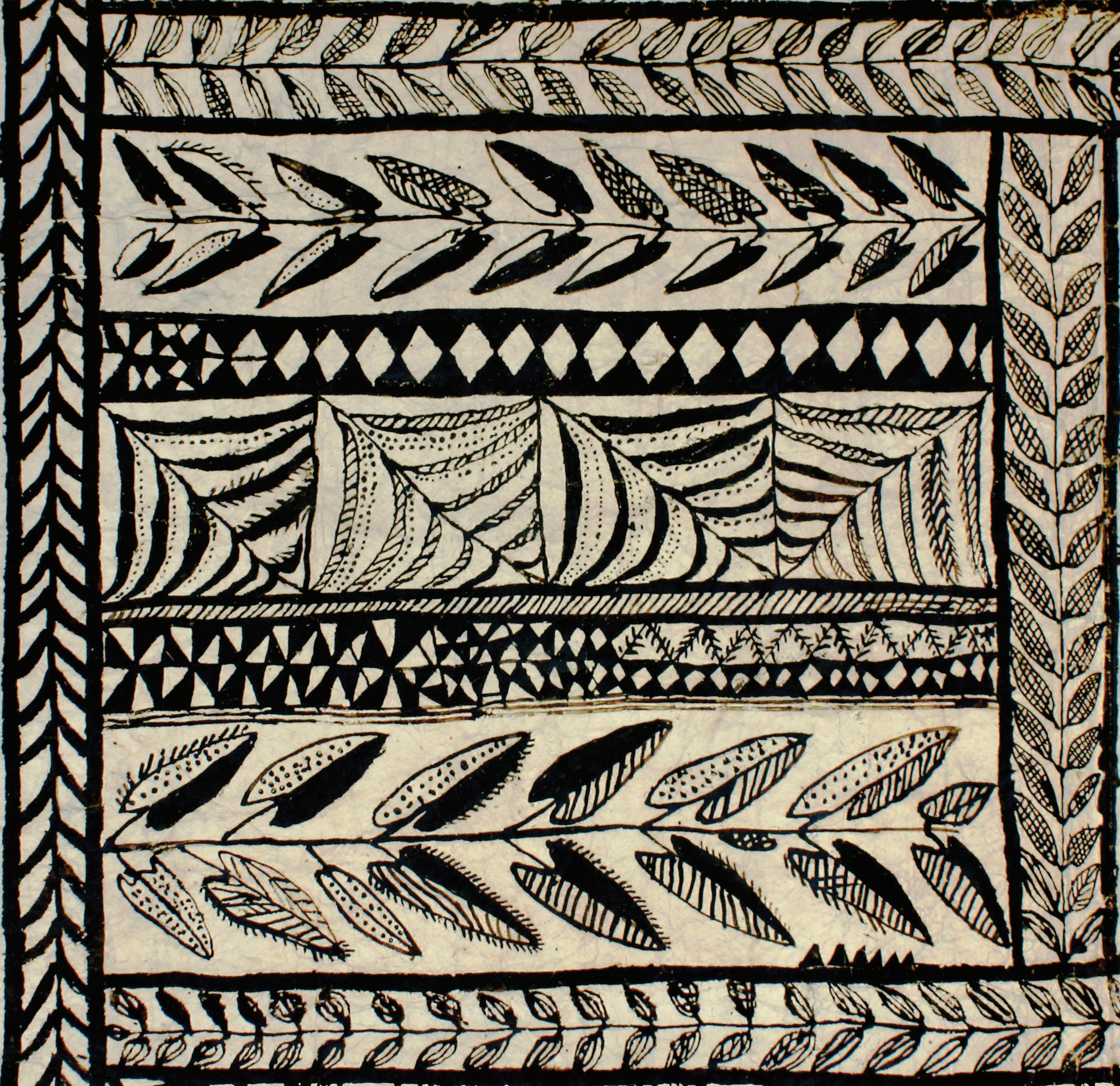
Winter 2023 | Volume 2 | Issue 2
BOARD OF TRUSTEES, 2023-2024
Anthony (Tony) R. Sapienza, Chair
Paulina Arruda
Christina Bascom
Ricardo Bermudez
Susan Costa
Douglas Crocker II
Betsy Fallon
John N. Garfield, Jr.
David Gomes
Edward M. Howland II
Meg Howland
James Hughes
D. Lloyd Macdonald
Ralph Martin
Eugene Monteiro
Michael Moore, Ph.D.
Gilbert Perry
Victoria Pope
Dana Rebeiro
Maria Rosario
Lucy Rose-Correia
Brian J. Rothschild, Ph.D.
Nancy Shanik
Hardwick Simmons
Bernadette Souza
Carol M. Taylor, Ph.D.
R. Davis Webb
Alison Wells
Lisa Whitney
Susan M. Wolkoff
David W. Wright
Front Cover Image: Maker once known (Niue), Hiapo detail, 1880-1890. Handmade bark cloth, 68 x 88 inches, New Bedford Whaling Museum, 00.200.452.
Back Cover Image: Advertisement from the New Bedford Portuguese-language newspaper Progresso, vol 12, no. 48 (January 6, 1906), NBWM, 2023.58. Gift of Rita Pacheco.
Vistas: A Journal of Art, History, Science and Culture
Copyright © 2024 New Bedford Whaling Museum
All rights reserved. No part of this publication may be reproduced, distributed, or transmitted in any form or by any means, including photocopying, recording, or other electronic or mechanical methods, without the written permission of the publisher, except in the case of brief quotations embodied in reviews and certain other non-commercial used permitted by copyright law.
18 Johnny Cake Hill New Bedford, MA 02740 www.whalingmuseum.org
President & CEO
Amanda McMullen
Design and Production
Brian Bierig, Graphic Designer
Consulting Editor
Naomi Slipp
Photography
Melanie Correia
Editor
Michael P. Dyer
Publisher
New Bedford Whaling Museum
Scholarship & Publications Committee
Michael Moore (Chair)
Mary Jean Blasdale
John Bockstoce
Mary K. Bercaw-Edwards
Tim Evans
Ken Hartnett
Judy Lund
Daniela Melo
David Nelson
Victoria Pope
Brian Rothschild
Tony Sapienza
Jan da Silva
Issue
Winter 2023 | Volume 2 |
2
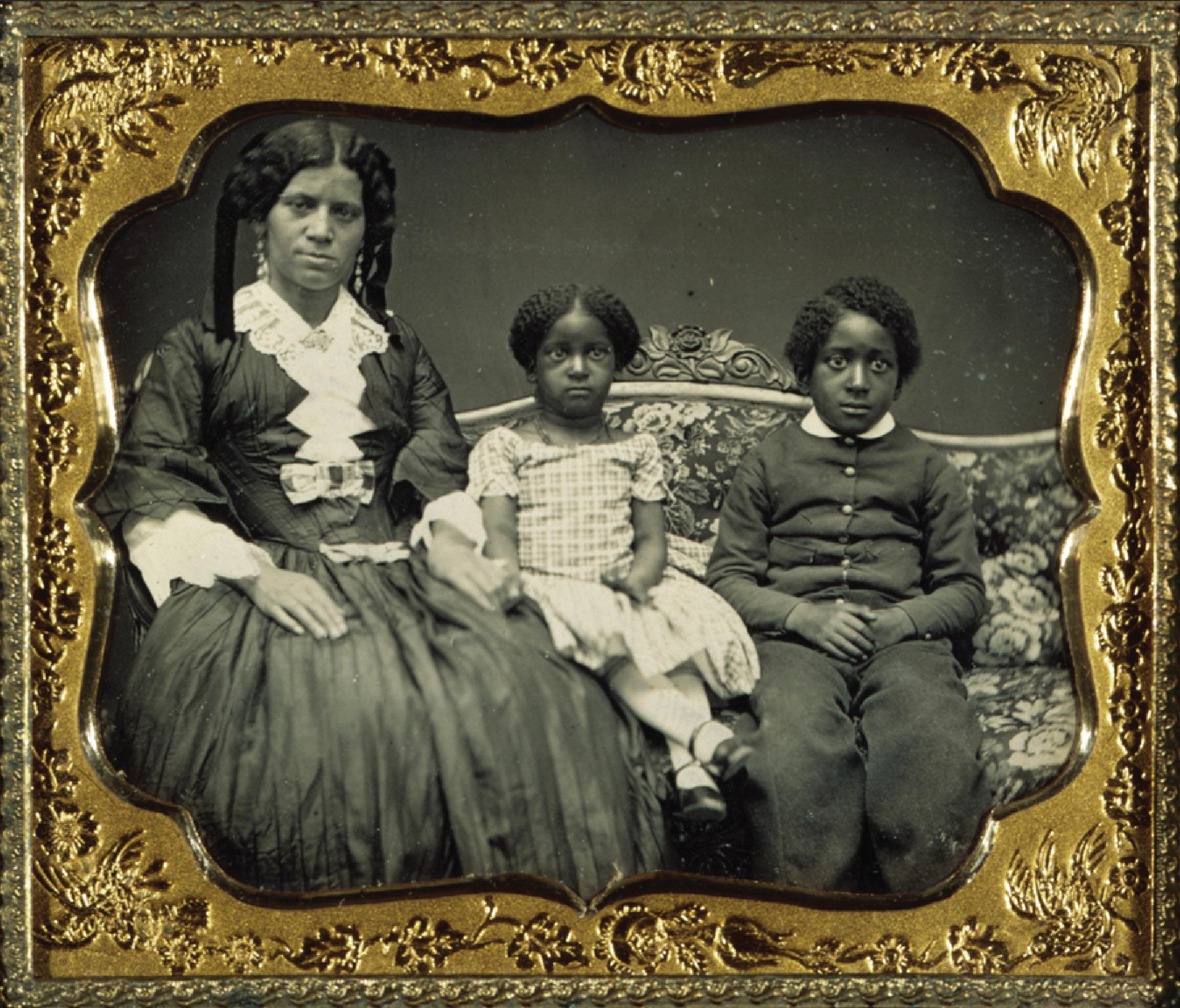
1 | Winter 2023
Maker once known, Maria Beckley Fleetwood with her children Anne and Solomon, c. 1853. Sixth plate daguerreotype, NBWM 1940.24.109.
2 Contents Foreword ............................................................ 3 Mercer’s Legacy Recovering Narratives about the Whaling Collection at the Mercer Museum By Peter Glogovsky, Ph.D. 5 A Record of Life and Encounter A Hiapo from Niue By Ymelda Rivera Laxton ....................................... 13 A Life of Courage, Integrity, and Purpose By Samantha Santos 19 Whaling Journals as Dream Diaries By Mark D. Procknik 21 From the Page: Transcription Stories By Naomi Slipp ...................................................... 23 The Wider World & Scrimshaw ........ 25 The Daguerreotype and Ambrotype in New Bedford By Marina Dawn Wells ........................................... 29 An Institute of Museum and Library Services (IMLS) Grant Improves collections preservation & access By Michael P. Dyer ................................................. 35 The Conservation of Charles Sidney Raleigh’s Panorama of a Whaling Voyage By Jordan Berson .................................................... 41 The Complex Stories of Seals and Society By Andrea Bogomolni ............................................ 45 The Stars That Guide Us Roy Rossow’s Inspiration By Emily Reinl 49 "Harboring Hope": the Importance of Multiple Perspectives By Karissa Walker 51 Looking Back ................................................ 55 Winter 2023 | Volume 2 | Issue 2
Foreword
All too often we place a future value on the concept of “discovery.” What new invention will change our lives; what next daring innovation will alter our tomorrow? The beauty in history is the discovery that comes from looking at yesterday. I was struck by the abundance of discovery laced throughout the contributions in this issue of Vistas.
As you dive into these pages, enjoy learning about a hiapo from Niue in our collection from our Assistant Curator of Contemporary Art & Community Projects, Ymelda Rivera Laxton. She so effectively chronicles all that we can understand of this traditional cloth made from bark; but her essay also illuminates that we can’t ever possibly know everything for certain. So often we work from whispers of yesterday to piece together the narrative. Connecting these dots inspires our team and the many scholars who study our collection.
You may also be equally spellbound by the deep dive from our Photography Collection Curatorial Fellow, Marina Dawn Wells, who shares revelations gathered from more than a year spent understanding and cataloguing our robust photography collection. Seamlessly weaving together a summary of a centurylong span of this portion of our collection, they detail the emergence of this art form and the accessibility it brought. If you have ever sat down to thumb through an old family album, you can relate to the many moments of detection and connection elicited by this work.
Samantha Santos, who has played a key role at the museum in guiding our High School Apprentices, notes her own discovery of Captain Paul Cuffe, an individual of extraordinary contribution to our immediate community and beyond. And yet growing up here she had never known of him before.
Museums and historical societies have a profound responsibility to not only care for our collections, but to bring these stories to you. Offering visitors, scholars, and students a chance for their own discovery is what guides us. Settle in to this edition of our journal dedicated to examinations across art, history, science, and culture. I know there will be many discoveries for you on the following pages.
Amanda McMullen President & CEO New Bedford Whaling Museum
3 | Winter 2023
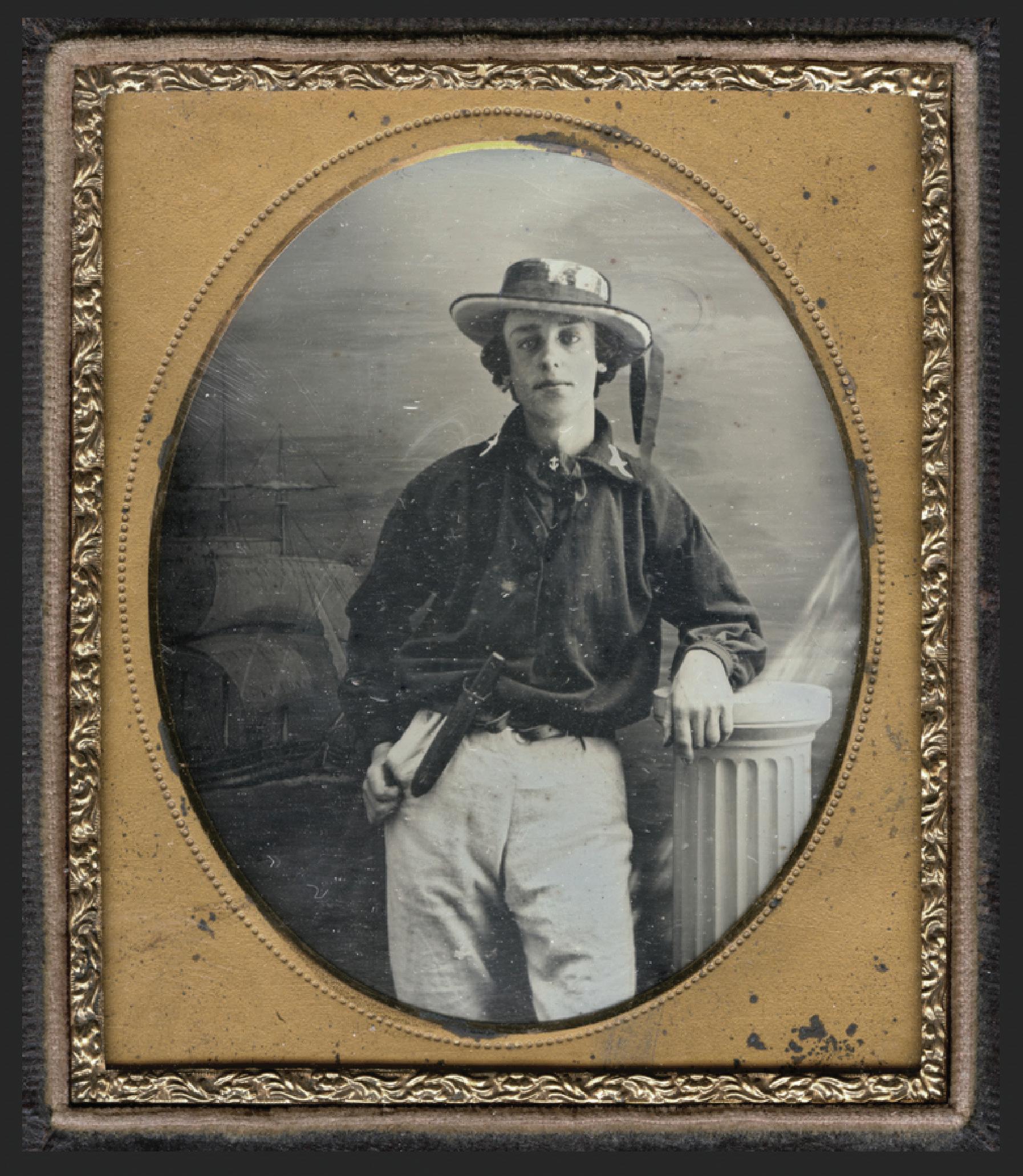
4
Charles H. Williamson, Jamie McKenzie, 1856. Sixth plate daguerreotype, NBWM 1980.33.9.1.
Feature Articles
Mercer’s Legacy:
Recovering Narratives about the Whaling Collection at the Mercer Museum
Peter Glogovsky, Ph.D., Project Assistant
The Mercer Museum & Fonthill Castle, operated by the Bucks County Historical Society
In October 1907, Henry C. Mercer (18561930) acquired a completely outfitted whaleboat (#1945) from the J. & W.R. Wing & Company, New Bedford, Massachusetts. Brothers Joseph Wing (1810-1895) and William R. Wing (1830-1908) of Dartmouth, MA, established the firm in 1849.1 From 1860 to 1910, the company managed one of the largest whaling fleets of the American whaling industry. After Mercer purchased the boat and whaling equipment, he donated the collection to the Bucks County Historical Society. When the new, poured concrete Mercer Museum, in Doylestown, PA was completed in 1916, the boat was suspended from the fourth level of the central court. Much of the whaling equipment that was procured at the time was either placed into the boat itself, along the fourth-level gallery, or into the maritime exhibit in Room 34.
When Henry Mercer acquired the whaling collection and shipped it to Doylestown, little to no provenance about the objects was recorded. The Bucks County
1 “Historical Note,” Mss. 35 J. & W. R. Wing & Company Records, 1833-1918. New Bedford Whaling Museum Research Library, https://www.whalingmuseum.org/collections/highlights/ manuscripts/mss-35/, accessed March 22, 2023. The firm of J. & W. R. Wing was first established as a clothier and outfitter. They acquired their first whaler, the bark John Dawson in 1853, and the bark Osceola 2nd in 1854 as sperm and right whalers on voyages to the South Atlantic and Indian Oceans. In addition to managing whaling vessels, New Bedford whaling merchants, like the Wing brothers, commonly operated other supply or processing businesses directly associated with a functioning whaling port including as grocers, tailors, ship chandlers, lumber yards, nail factories, shipyards, oil refineries, or candle houses.
Historical Society (BCHS) accession ledgers record almost no information about the purchase of the collection, the origin of this whaleboat, which whaleship the boat was used on, or who built the craft. Recovering the provenance of the collection, together with the stories of the individuals whose livelihoods depended upon it, and sharing these stories with the public is essential for the Mercer Museum to fulfill its mission.2
In 2022, the Institute for Museum and Library Services (IMLS) awarded a grant to the Mercer Museum & Fonthill Castle. This grant provided resources to museum staff to clean, document, and research nearly 500 objects located in the original core of the museum. This grant project is the first phase in a long term plan by the Mercer Museum to revise and update interpretation methods and materials. Vice President of Collections and Interpretation Cory M. Amsler, Collections Manager Kristin Lapos, Assistant Collections Manager Emma Falcon, Exhibition Specialist and Preparator Clint Flack, and Project Assistant Peter Glogovsky compose the project team. As part of this broader project the whaleboat and the equipment displayed inside were cleaned and documented in March 2023. The remainder of this article reviews the historical context of the collection and how it was rediscovered.
2 The mission of the Mercer Museum is: “To educate and engage its many audiences in appreciating the past and to help people find stories and meanings relevant to their lives—both today and in the future.”
5 | Winter 2023
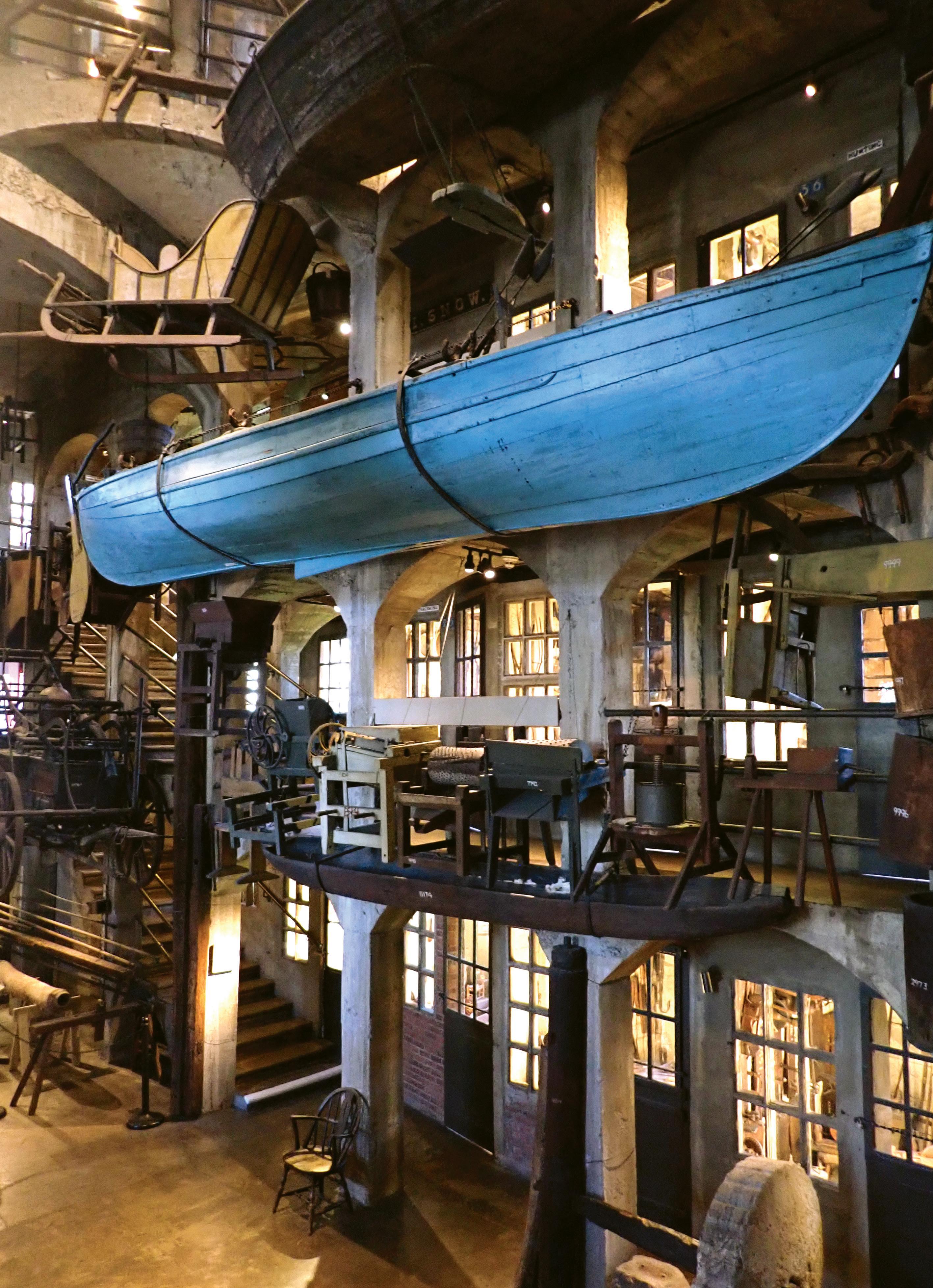 Figure 1. Central court of the Mercer Museum with whaleboat, photograph by author, March 2023.
Figure 1. Central court of the Mercer Museum with whaleboat, photograph by author, March 2023.
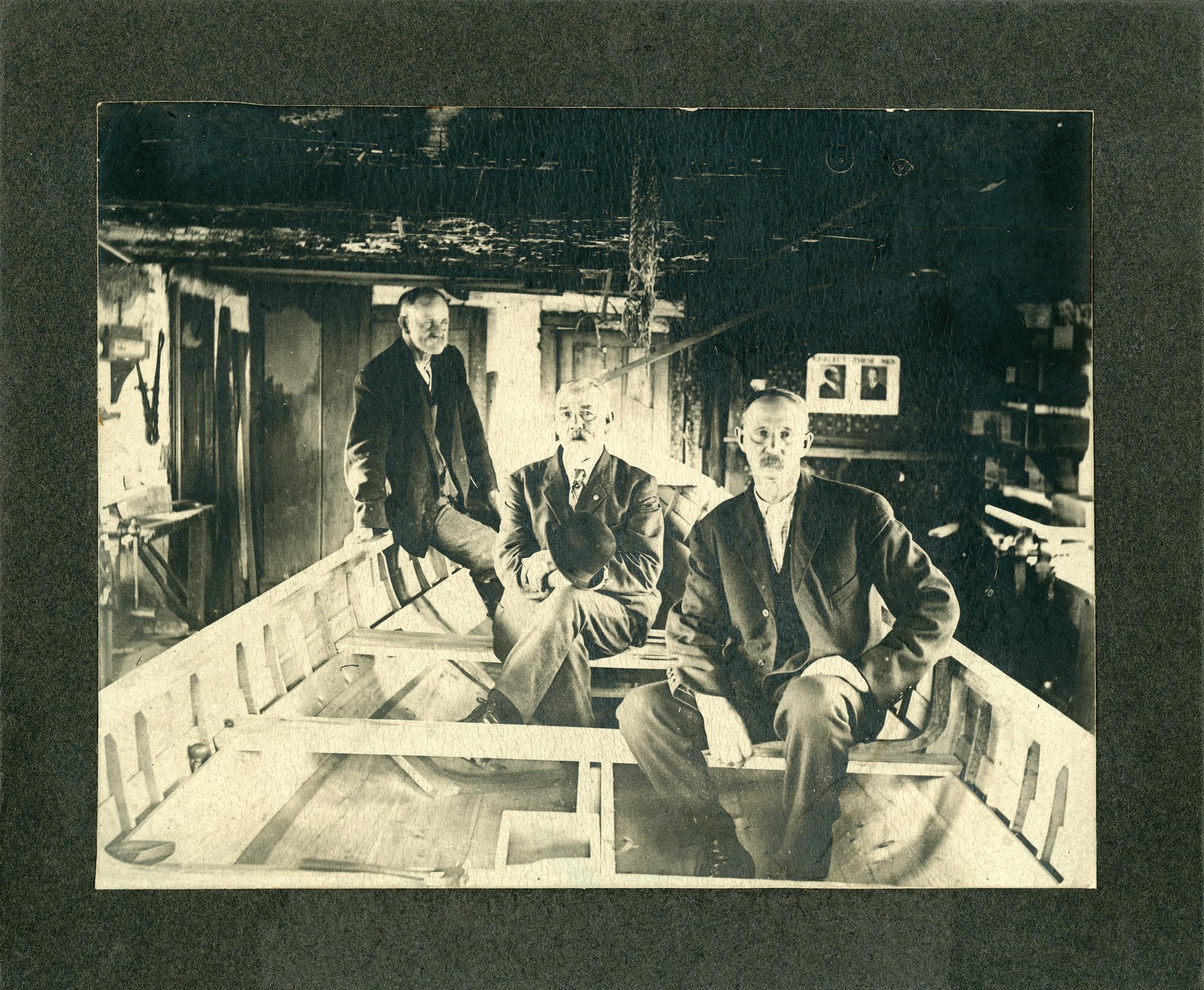
When visitors enter the central court space and see the whaleboat above their heads, they often ask about its origin. Prior to the work by the project team, staff could only explain that the boat came from New Bedford and was part of the whaling fleet owned by the J. & W.R. Wing & Co. We now have more information. While cleaning the boat the project team identified a mark “LEONARD” branded into a board at the stern.3 When a whaleboat was completed, some boat shops burned their mark into the wood at the stern or sometimes near the
bow.4 Finding this brand was an important piece of information as it confirms that this whaleboat was constructed at the boat shop of Ebenezer Leonard (1814-1891) in Acushnet, Massachusetts.5
Ebenezer Leonard was born in Taunton, Massachusetts, on April 10, 1814. In 1827, he entered the boat building trade as an apprentice
4 Ansel describes a similar brand used by Charles Beetle to burn a mark into the wood of the lion’s tongue and inside of the thigh board. Willits D. Ansel, Whaleboat: A Study of Design, Construction and Use from 1850-2014 (Mystic: Mystic Seaport, Inc. 1978; 2014 ed.), 82-83; Michael Dyer, email message to author, March 21, 2023.
3 This board, commonly termed the “lion’s tongue,” is a lateral strengthening hardwood member through which the oak “loggerhead” was mounted.
5 Michael Dyer, email message to author, March 21, 2023; “Ebenezer Leonard” in Franklyn Howland, A History of the Town of Acushnet, Bristol County, State of Massachusetts (New Bedford: published by the author, 1907), 313; “Ebenezer Leonard” Year: 1880 ; Census Place: Acushnet, Bristol, Massachusetts ; Roll: 522; Page: 13A; Enumeration District: 063. Ancestry.com.
7 | Winter 2023
Figure 2. Ebenezer Leonard with his sons Charles and Eben Jr. around 1890. Photograph, Collection of the New Bedford Whaling Museum, New Bedford, MA, 2000.100.3437.
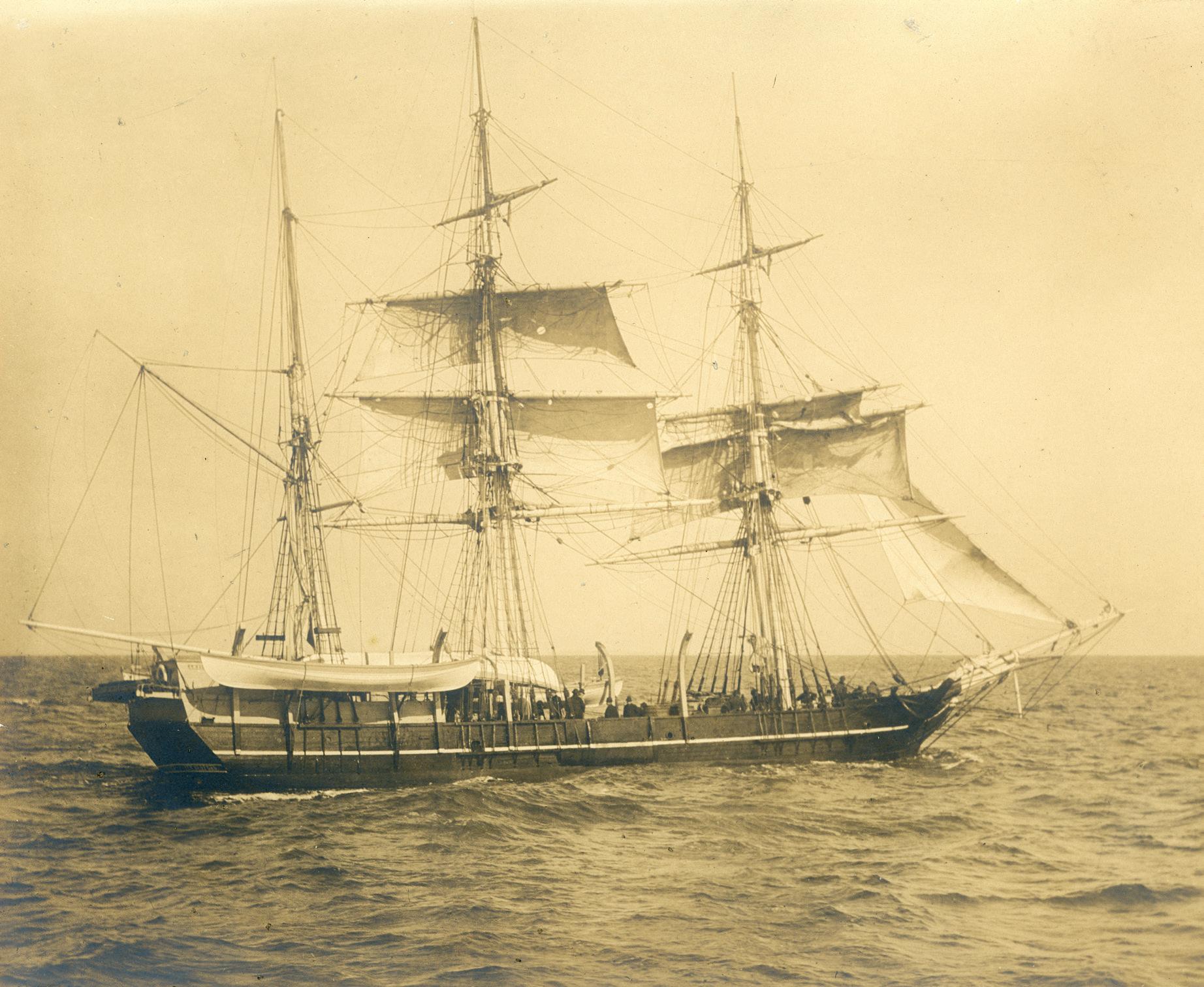
at William E. Carver’s shop at New Bedford.6 As a journeyman, Leonard worked with other New Bedford boat builders including Jethro Coffin and later, for several years, Daniel Wadsworth. In 1851, Leonard relocated to the nearby town of Acushnet, where he continued building boats until his death in 1891. Leonard’s sons Eben F. and Charles learned the trade from their father as apprentices in the shop. Following their father’s death in 1891, the sons continued the family business into the early twentieth century.7 Eben F. and Charles, who operated the boat shop from 1891 until 1907, most
6 “Acushnet” in Duane Hamilton Hurd, History of Bristol County, Massachusetts: With Biographical Sketches of Many of Its Pioneers and Prominent Men (Philadelphia: J. W. Lewis & Company, 1883), 163. Carver’s shop was located at the rear of 40 South Water St., New Bedford.
7 Hurd, History of Bristol County, Massachusetts, 163.
likely constructed this boat.8 Today the brand on the lion’s tongue is barely visible beneath layers of paint, but it is a reminder of the craftsmanship and personality invested into these boats.
The use of this boat and its equipment was ascertained after a number of objects carrying the letters “SB” were found in the collection. The two letters are an abbreviation for “starboard boat.”9 Whaleships carried several whaleboats aboard and pieces of equipment were commonly marked to indicate to which boat these objects belonged.10 A number of objects in the
8 Howland, A History of the Town of Acushnet, 313.
9 Mark Procknik, Email message to the author, March 1, 2023; Mark Procknik, Email message to the author, March 7, 2023; “Whalecraft Markings,” Whalesite.org, Thomas G. Lytle, https://whalesite.org/ whaling/whalecraft/, accessed March 3, 2023.
10 Equipment carried the initials of the boat it belonged to: S.B.B. Starboard bow boat; S.B. Starboard boat;
8
L.B. Larboard boat; W.B. Waist boat; P.B.B. Port bow boat. Ansel, The Whaleboat, 99.
Figure 3. Photograph of the A.R. Tucker, undated, possibly from her 1901-1903 or 1903-1906 voyage. Photograph, Collection of the New Bedford Whaling Museum, New Bedford, MA, 2000.100.488.
collection have these letters: Two line tub covers, a “piggin” or small pail, several short paddles, and a lantern keg. There are likely more objects in this collection marked with SB lettering which have not yet been identified. After a cursory search, the project team only found the letters SB painted, carved, or stamped on the equipment. As there were no other markings found, such as WB or LB, it is reasonable to argue that most, if not all, of the equipment in this collection came from the same starboard boat, rather than having been assembled from multiple boats.
More compelling to visitors and staff alike are markings found on two harpoons and two knives bearing the letters BK ART and B ART, along with SB, that unite this whaleboat to a particular whaleship, the bark A.R. Tucker (1851-1908). After reviewing a list of vessels owned by the J. & W.R. Wing & Co. and scrutinizing the chronology of these vessels against the date of the collection purchase, the A.R. Tucker was the only whaleship whose full name, abbreviated form, and span of life most prominently aligns. Further, the chronology of this whaleship and her voyages, discussed later in this article, is consistent with the sequence of events related to the purchase of the whaleboat. Adding further credence, no other letters were found on the whaling equipment that would otherwise indicate that the equipment and boat were removed from another whaleship. Two toggle head whale irons and two knives are perhaps the strongest material evidence that link this boat and the equipment to this particular ship.11
The project assistant consulted with Michael P. Dyer, Curator at the New Bedford Whaling Museum, about these markings on both the equipment and the boat itself. Dyer confirmed that the whaleboat was the starboard whaleboat from the bark A.R. Tucker He also suggested that the starboard boat in an undated photograph appears clean and undamaged and may possibly be the very same whaleboat subsequently acquired by Henry Mercer in 1907. Further research into the context of this photograph and the other materials in this collection may confirm this perspective.
The bark A.R. Tucker (1851-1908) was a purpose-built whaler constructed at Dartmouth, Massachusetts in 1851 at the yard of Alonzo Matthews and John Mashow. Mashow (1805-1893) was the famed African-American shipwright who was born enslaved and somehow re-located from South Carolina to Dartmouth as a youth around 1818. He went on to become part-owner of the shipyard and the builder of many famous whale ships. The A.R. Tucker was registered in June of that year to Abner R. Tucker and Thomas S. Bailey, who also served as master on her first voyage.12 The A.R. Tucker made a series of voyages during the height of the American whaling industry and, in 1861, J. & W.R. Wing & Co. bought her.13 The ship was registered as completing twenty-four whaling voyages, each of which lasted from only a few months to upwards of four years. The final voyage of the A.R. Tucker was from October 1903 to July 1906.14 In 1908, the whaleship was sold and broken up and it was during these years that Mercer acquired the whaleboat and its gear.
The A.R. Tucker was designed and built as a bark, a sailing vessel that featured three masts, in which the foremast and mainmast were square-rigged while the mizzen mast at the stern was fore-and-aft rigged.15 Barks were easier to handle, required a smaller crew,
12 “A.R. Tucker.” American Offshore Whaling Voyages: A Database, Mystic Seaport Museum, Inc. and New Bedford Whaling Museum, https://whalinghistory.org; “A.R. Tucker ” Ship Registers of New Bedford, Vol. 3 1866-1939, Survey of the Federal Archives Division of Professional and Service Projects, Works Progress Administration, 1940.
13 For a complete list of other owners and masters for the ship, from 1851-1906, see “A.R. Tucker” in Ship Registers of New Bedford, Vol. 2 1851-1865, and Ship Registers of New Bedford, Vol. 3 1866-1939. Survey of the Federal Archives Division of Professional and Service Projects, Works Progress Administration, 1940.
14 A full list of the whaling voyages for the A.R. Tucker can be found on American Offshore Whaling Voyages: A Database, Mystic Seaport Museum, Inc. and New Bedford Whaling Museum, https://whalinghistory.org, accessed March 23, 2023.
15 “Whaling History: Vessels and Terminology” New Bedford Whaling Museum, https://www.whalingmuseum.org/learn/research-topics/ whaling-history/vessels-and-terminology/, accessed March 23, 2023.
9 | Winter 2023
11 The stamp found on (#12178), MACY, indicates that this harpoon was forged by Edwin B. Macy, or his brothers, New Bedford, MA.
and became one of the most popular vessels employed by whaling fleets after the mid-1800s.16 The A.R. Tucker was recorded as being one of the smallest of the New Bedford whalers at 145 tons with a length of 92 feet.17 She carried at least three whaleboats: the larboard boat, the waist boat, and the starboard boat.
One or two extra boats were stowed on deck skids.18
To understand the context of Henry Mercer’s October 1907 acquisition of the whaleboat and whaling equipment from the J. & W.R. Wing & Co., it is important to recognize that the last years of the A.R. Tucker sequentially align with the time of Mercer’s purchase. Although the specific voyage or voyages upon which this whaleboat saw service is yet undetermined, enough is known so as to put together a rough sketch.
The final whaling voyage of the A.R. Tucker was from October 3, 1903 to July 30, 1906. Sylvanus B. Potter was the master of the ship on this final sperm whaling voyage to the Atlantic Ocean returning 300 barrels of sperm oil, having transshipped home 1350 barrels during the voyage.19 After her return, the ship was moored in New Bedford for a period of time, remaining under the management of the J. & W.R. Wing & Co.
In September 1907, Henry Mercer communicated
16 Paul Giambarba, Whales, Whaling, and Whalecraft (Centerville, MA: Scrimshaw Press, 1967), 42.
17 “A.R. Tucker” in Ship Registers of New Bedford, Vol. 2 18511865,1940; Dimensions and tonnage of the ship, recorded in 1851, were as follows: 218 5/95 tons, length 95 ft. 1 ½ in., breadth 23 ft. 1 in., depth 11 ft. ½ in.; When the ship was re-registered in 1865, the dimensions and tonnage were listed as follows: 129.95 tons, length 92.4 ft., breadth 23.2 ft., depth 11ft. In 1876, the ship was re-registered as being 145.36 tons. One newspaper article cited, “Smallest of her rig on the coast is the A.R. Tucker, a New Bedford whaler, of 145 tonnage and 92 feet in length, built in Dartmouth, Mass.” “Largest and Smallest,” The Pittsburgh Press (April 14, 1907).
18 See entries in Journal of the A. R. Tucker (Bark) out of New Bedford, MA, mastered by Asa Grinnell and kept by Alonzo Peirce, on a whaling voyage between 1861 and 1864, InternetArchive.org, accessed March 29, 2023.
19 1670 barrels sperm oil total catch of the voyage as reported on American Offshore Whaling Voyages: A Database, Mystic Seaport Museum, Inc. and New Bedford Whaling Museum, https://whalinghistory.org, accessed March 23, 2023; 300 barrels sperm returned as reported by The Whalemen’s Shipping List and Merchants’ Transcript, New Bedford, MA (April 9, 1907).
with William R. Wing about purchasing a completely equipped whaleboat. Multiple lists of whaling equipment were drawn up and correspondence shows that there was some negotiation about which objects Mercer desired and for what price. No documentary evidence has yet been found that suggests the J. & W. R. Wing & Co. publicly auctioned off equipment from the A.R. Tucker. How exactly Mercer heard about the whaleboat and equipment remains uncertain. With the transaction complete, on October 16, 1907, the boat and fittings, along with equipment used aboard the whaleship to render blubber into oil, were shipped to Doylestown, Pennsylvania, addressed to Henry Mercer. Some of the whaling equipment was crated while other tools were shipped in bundles. The whaleboat itself, weighing around 1000 pounds, was sent on a railcar.
The whaleship remained moored until she was “sold and withdrawn” from the whaling fleet on June 18, 1908.20 There are no subsequent references to the whaleship in The Whalemen’s Shipping List and Merchants’ Transcript after this date.21 By this time, at least some of the shipboard equipment and boats were sold to various parties. The managing owner, William R. Wing sold “the hull, rigging, and other parts of said vessel now attached to her as lays at Central Wharf” to New Bedford junk dealer Herbert L. Jones.22 Presumably most of the fittings and equipment were already removed from the ship.
It is not known where the whaleboat and equipment were stored when the collection first arrived in Doylestown. Over time, each object in the collection was assigned an object number and accounted for in the Bucks County Historical Society accession
20 The Whalemen’s Shipping List and Merchants’ Transcript, New Bedford, MA (June 23, 1908).
21 “A.R. Tucker” in Ship Registers of New Bedford, Vol. 2 1851-1865 and Ship Registers of New Bedford, Vol. 3 1866-1939. Survey of the Federal Archives Division of Professional and Service Projects, Works Progress Administration, 1940.
22 Mark Procknik, Email message to author, April 8, 2023; Letter, William R. Wing, June 18, 1908, MSS 35, J. & W.R. Wing & Company Records. New Bedford Research Library. See: New Bedford City Directory (Boston: W.A. Greenough & Co., 1906), for reference to Herbert L. Jones.
10
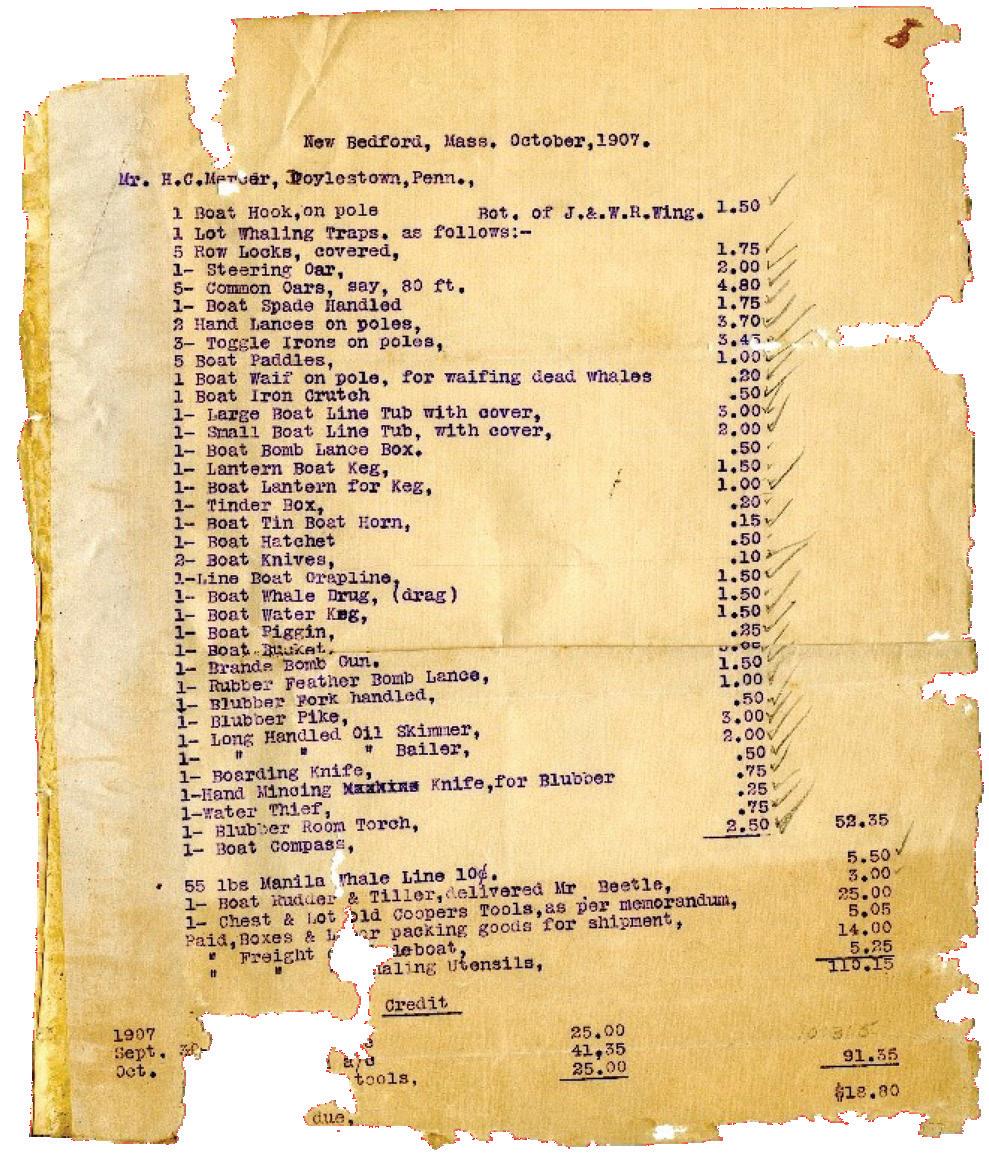
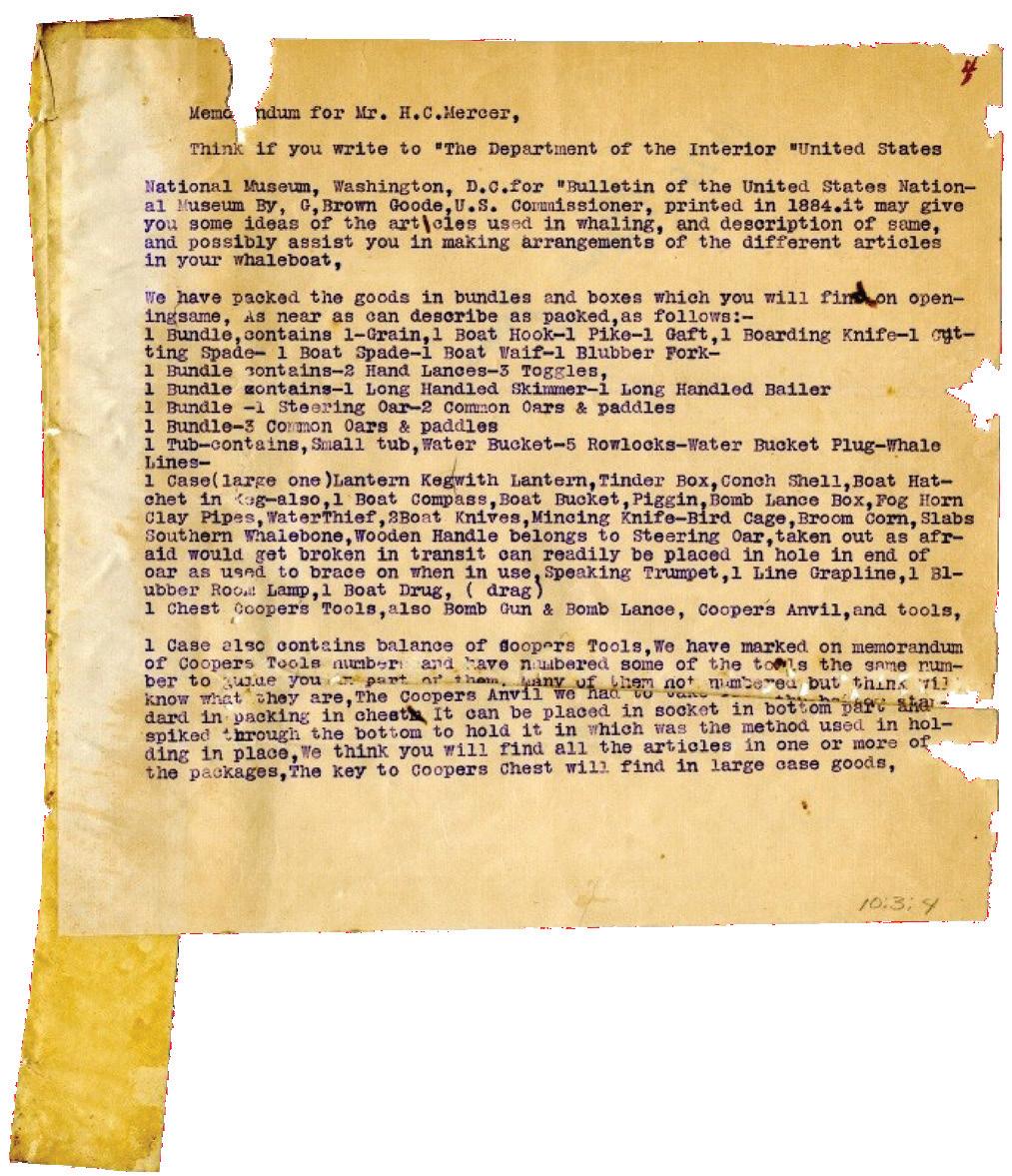
ledgers.23 In 1916, when the new museum was nearing completion, the boat was suspended from the fourth floor of the central court using block and tackle. Other large objects were added to the interior at the same time, including a Conestoga wagon and a stagecoach. Some of the whaling equipment that
23 Note that the object numbers are not sequential for the whaling collection. The whaleboat is #1945, while the killing lances are #12177 and #12180. The short paddles range from #14275#14279, and the bomb or darting gun is #8678. This indicates that the collection was accessioned in batches at a later point after arrival.
hull of the boat, while other pieces were displayed in Room 34, the maritime exhibit room.
Based on this information, a general history of the whaling collection at the Mercer Museum can now be relayed to the public. However, the specific voyage on which this boat was used remains undetermined. One possible avenue to solve this might be to examine a series of uniform notches carved into the loggerhead. The loggerhead was a round wooded post, generally a
11 | Winter 2023
Figure 4 and 5. Shipping Receipt (left) and Memorandum (right) October 1907, MSC 291 Mercer More Misc. Loose Ends/Stray, Upper Vault, Rank 62, Shelf 7, Papers Relating to Acquisition of Whaleboat & Other Items Series 10, Vol. 3. From the Collection of the Mercer Museum Research Library of the Bucks County Historical Society.
full-round trunk of a young white oak tree, mounted on the starboard side of the stern platform. The harpoon line wrapped twice around the loggerhead and was controlled as it ran out from the tubs to the bow chocks.24 There are twelve uniform notches cut into the loggerhead that indicate the completion of several successful whale hunts for the crews of this particular boat. Nine of these notches are located on the outside rim of the loggerhead, and three more notches located on the top of the post.
These notches can conceivably be used to link this boat to a specific multi-year voyage aboard the A.R. Tucker. The notches on the loggerhead are a tangible record of the number of whales killed by the boat crew and capture the imagination.25 By comparing the number of notches on this loggerhead to logbook entries of the A.R. Tucker, it might be possible to link this boat to a specific voyage or series of voyages. However, this is difficult to accomplish solely using the loggerhead notches as evidence. Current speculation is that the boat likely came from the last two voyages of the A.R. Tucker in either 1901 or 1903. Corresponding documentary evidence in logbook entries would confirm whether the notches match with an exact number of whales that this boat crew captured during a voyage.
The short lifespan of whaleboats, in general, makes it reasonable to believe that the Mercer Museum whaleboat came from a period closer to the disuse of the A.R. Tucker. The useful life of a whaleboat was determined by several factors, including the length of the voyage itself. George Brown Goode wrote of the construction and longevity of these craft in 1884, “some vessels return with the same boats they took out, which have, however, undergone many repairs during the voyage; but usually the boats are so much disabled in the service as to render substitutes imperative.”26 Although whaleboats were constructed
24 For a full description of loggerheads, see Ansel, The Whaleboat, 47.
25 Michael Dyer confirmed that similar notches were also found on the loggerhead of a whaleboat at the New Bedford Whaling Museum. Michael Dyer, Email message to author, 3/21/23
26 James Temple Brown, “Chapter 2: The Whalemen, Vessels and Boats, Apparatus, and Methods of the Whale Fishery,” in George Brown Goode, The Fisheries and Fishery Industries of the United States (Washington: The Government Printing Office, 1884), 242.
to be strong yet lightweight, they were also built to be low cost for their owners. To an extent, these boats were understood to be expendable as “most boats stood the abuse for about one voyage” which could last up to four years.27 This particular whaleboat exhibits evidence of damage to its hull in two locations and wear patterns from hard use elsewhere. At least one repair was made to the hull using a canvas patch while there is a second noticeable location where a section of hull planking is missing near the keel. It is possible that this boat survived multiple whaling voyages. However, given the demands and conditions that a boat encountered during even a single voyage, it is far more likely that this boat dates from the later voyages of the A.R. Tucker in 1901 or 1903.
The whaleboat is iconic as it dominates the central court space at the Mercer Museum. Since its opening in 1916, the Museum’s whaleboat and whaling collection have contributed greatly to the visitor’s complete experience, being a way for visitors to appreciate the cultural history of the U.S. commercial whale fishery of the nineteenth and early twentieth centuries. The material and archival evidence that contributed to the re-discovery of this collection’s provenance was neither the initial objective nor the outcome anticipated by the project team. Although significant, the research presented in this article is only a starting point. More will be done to design and implement appropriate interpretation to enhance the visitor experience while maintaining scholarly excellence and information retention. The whaling collection offers several potential paths for interpretation including the recovery of historical narratives about the individuals who built this boat, and the industry and its participants that depended upon it for their livelihoods. This whaling collection in a Pennsylvania museum emphasizes how Henry Mercer’s vision and legacy continues to shape how both visitors and staff members engage with the past.
27 Ansell writes, “whaleboats were built cheaply and quickly. It was expected that they would be used hard, become racked and battered, and be disposed of before rot or rusting fastenings destroyed them.” Ansel, The Whaleboat, 39.
12
A Record of Life and Encounter: A Hiapo from Niue
By Ymelda Rivera Laxton, Assistant Curator of Contemporary Art & Community Projects
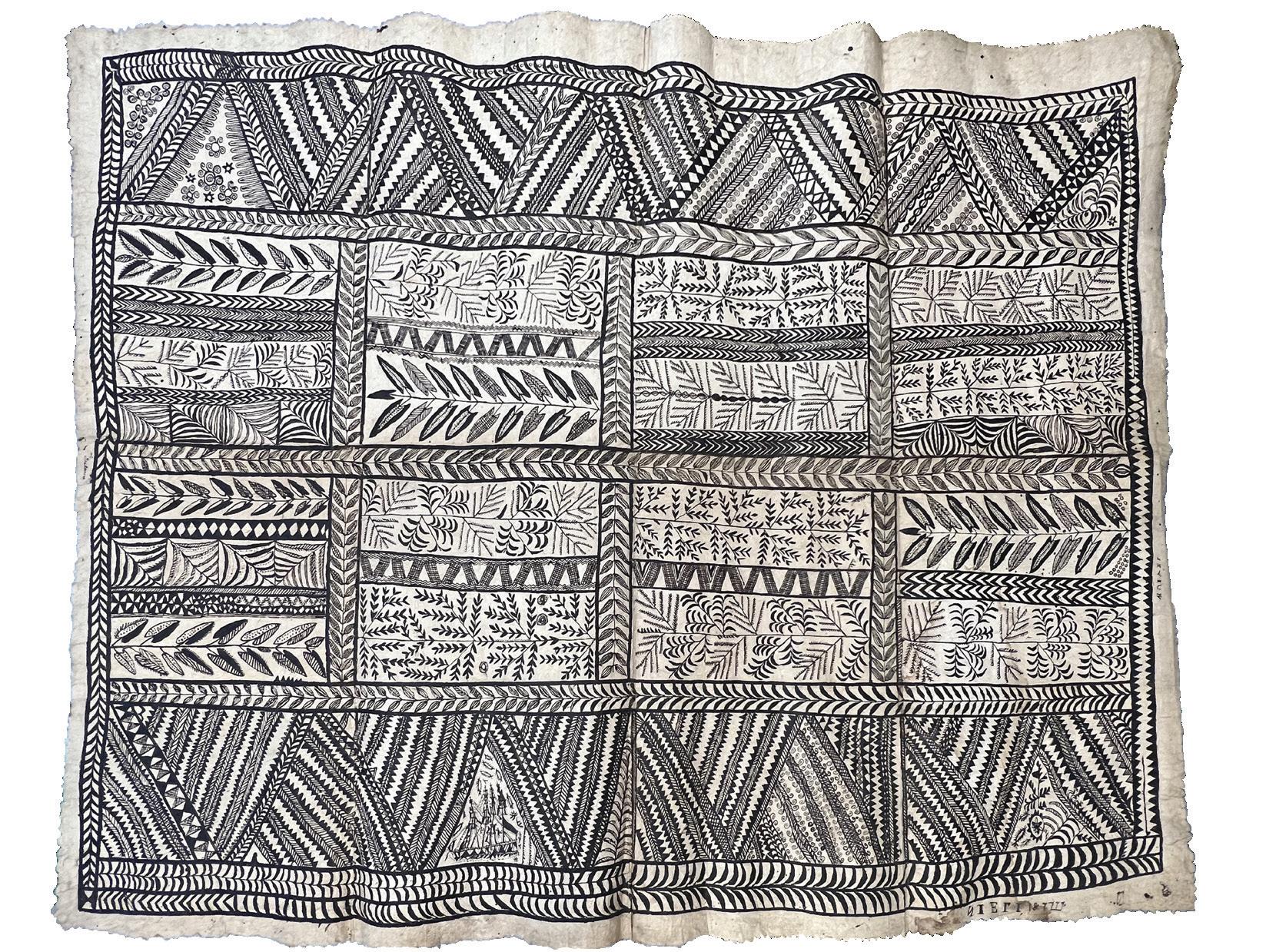
The New Bedford Whaling Museum holds some thirty pieces of decorated barkcloth from various cultures of Oceania including a superb example from the island of Niue. This cloth, commonly called tapa, is made from bark that has been softened through a process of soaking and beating. It is a versatile fabric crafted and used by communities in the Oceanic islands for clothing, mats, memorial and sometimes ceremonial purposes. The bark, harvested from several types of trees and shrubs, often mulberry and fig, is pulled off in a single sheet and the inner bark soaked to soften the material. Inks made from the soot and oil of nuts like the candleberry nut are used to paint the cloth.
Hiapo are most often created by one maker or family and are regarded as an art form historically crafted by women.1
Though tapa is the umbrella term used for decorated barkcloth across Oceania, each individual community uses their own word for the craft. In Niue, the cloth is called a hiapo. Many documented hiapo surviving today were made between 1880 and 1900.2 The bark cloth featured here was most likely made in this same time period. Niue is located in a triangle
1For reference, see: Roger Neich and Mick Pendergrast, Traditional Tapa Textiles of the Pacific (London: Thames and Hudson, 1997).
2 Nicholas Thomas email correspondence, October 2023.
13 | Winter 2023
Figure 1. Maker once known (Niue), Hiapo, 1880-1890. Handmade bark cloth, 68 x 88 inches, New Bedford Whaling Museum, 00.200.452.
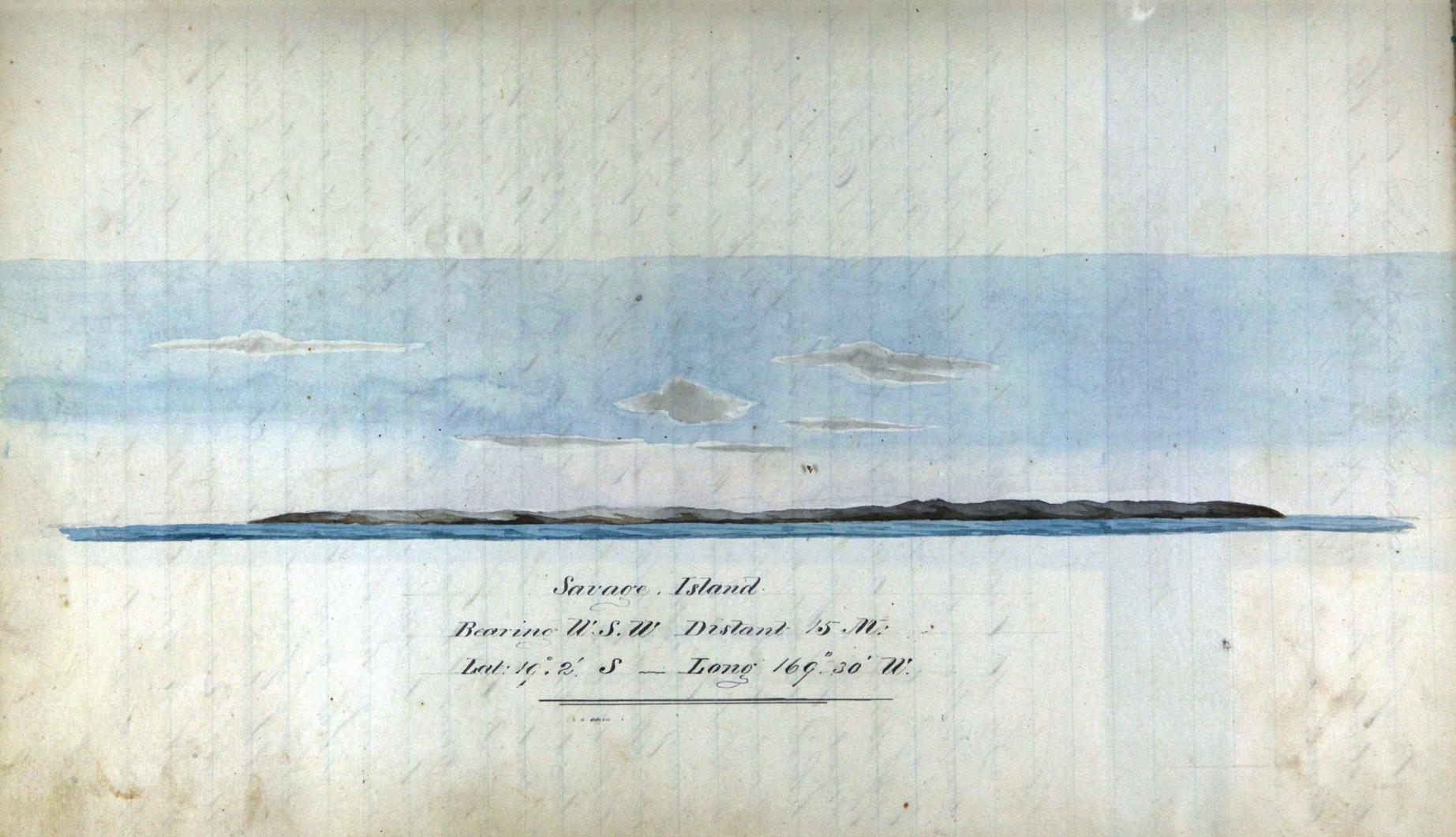
between Tonga, Samoa, and the Cook Islands and was once known as “Savage Island,” as a result of a 1774 acrimonious encounter between local people and Captain James Cook (1728-1779), during his second voyage to the Pacific onboard the HMS Resolution, 1772-1775.3 It is now called “the Rock of Polynesia,” being the largest coral atoll in the world. Niueans themselves, through their own oral tradition and histories, called their home island Niue Fekai, among other names.4
While little is known about bark cloth in Niuean culture before contact with the West, most historians credit the popularization and spread of decorated barkcloth with the arrival of Samoan missionaries in Niue in the 1830s. Samoan members of the London Missionary Society brought decorated
3 For reference, see: Margaret Pointer, Niue: 1774-1974, 200 years of contact and change (Dunedin: Otago University Press, 2015).
4 The origins of the name Niue-Fekai vary or remain undefined in different writings, translated oral stories, and accounts by visitors and Niueans alike. For reference see: Pulekula, “Appendix: The Traditions of Niue-Fekai: Ko e Tohi He Tau Tala i Niue-Fekai” in The Journal of the Polynesian Society, vol. 12, no. 1 (March 1903): 21-31; Terry Magaoa Chapman et al, Niue: A History of the Island (Fiji: University of the South Pacific, Suva, 1982); Basil C. Thomson, Savage Island: an account of a sojourn in Niué and Tonga (London: John Murray, 1902); Stephenson Percy, Niue-fekai (or Savage) Island and its people (Wellington: Whitcombe & Tombs, 1903).
barkcloth called siapo with them to Niue. They also introduced a poncho-like garment made from hiapo called a tiputa, as a form of clothing and important in the Christian conversion of the Pacific Island communities.5 The earliest extant examples of hiapo were collected by missionaries in the latter half of the 1800s. Due to this early Samoan exchange there are similarities between Samoan siapo and Niuean hiapo. Niueans decorated their hiapo with freehand painting that is similar to the Samoan style. While similar, hiapo is still distinctive in its detailed patterns that include repeating abstract and geometric designs and imagery of plants, seeds, creatures, people, and trees. The designs are often in a grid form or in concentric circles. The meaning of each hiapo belong to the maker or family that made them.
This particular hiapo includes illustrations of local identifiable plants, seeds, and patterns. Interestingly, the hiapo also includes a rendering of a Western European or American square rigged sailing ship and what appears to be people climbing rigging
5 John Pule and Nicholas Thomas, Hiapo: Past and Present in Niuean Barkcloth (Dunedin: University of Otago Press, 2005). See also: Saufa Akeli and Shane Pasene, Exploring ‘the Rock’: Material culture from Niue Island in Te Papa’s Pacific Cultures Collection, Tuhinga 22, Museum of New Zealand Te Papa Tongarewas, 2011.
14
Figure 2. From A Journal of the Lucy Ann Voyage 1841-1844 by John F. Martin, edited by Kenneth R. Martin, 2016.
on the ship. Around the ship are biological forms that may be crayfish and other similar creatures that live in tide pools around the edges of the island.6 This exceptional design is interspersed with the more traditional geometric and botanical motifs commonly seen on hiapo.
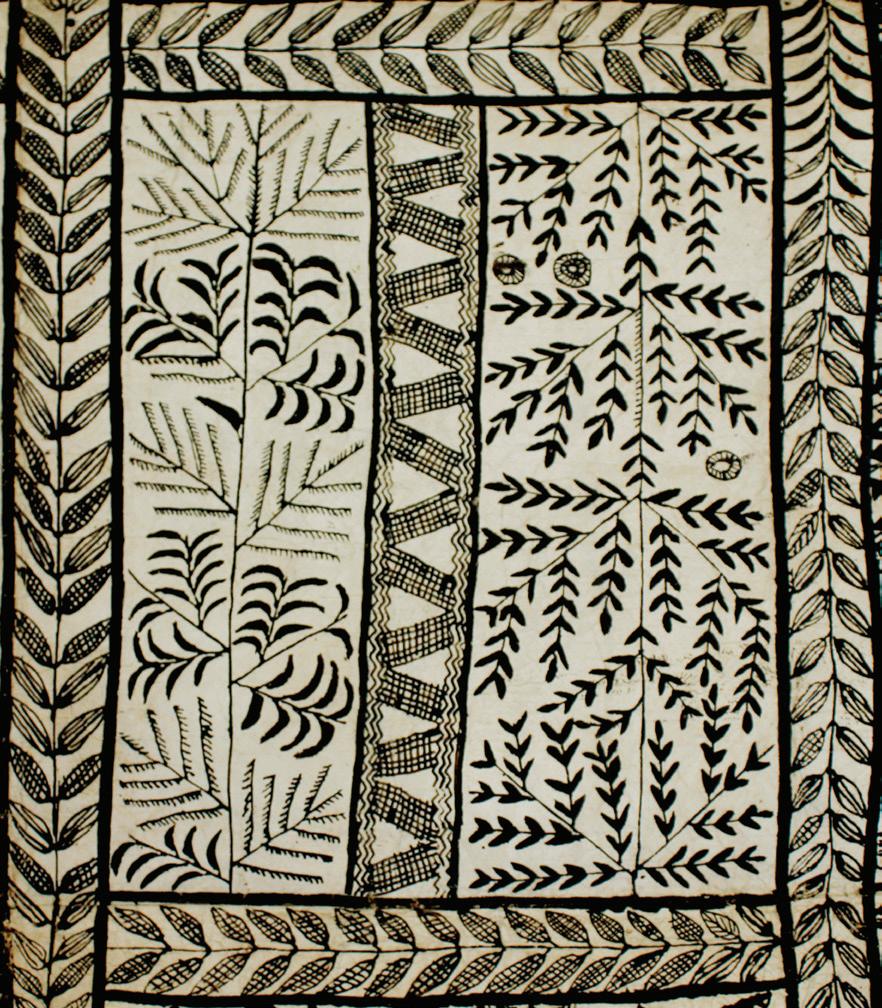
This design speaks to the cultural exchanges and relationships that developed between Niue, other Indigenous communities in Oceania, and the West. By the late 1800s, mariners, missionaries, and merchants had developed trade and shipping routes in the islands, selling and buying wares, hunting, and expanding the Christian church. The impact of the London Missionary Society was evident in the churches, clothing, and in how the communities on the island were organized. The 2005 publication Hiapo: Past and Present in Niuean Barkcloth, by John Pule and Nicholas Thomas, documents three other examples of hiapos with ship imagery. These cloths, in the Australian Museum and private collections, respectively, show smaller examples of different types of seafaring vessels.7
6 Email correspondence with artist Cora-Allan Lafaiki Twiss and author and historian Nicolas Thomas (October 2023).
7 While the hiapo documented in the Pule and Thomas publication are not available online, a handful of other examples are available to view at: https://www.tepapa.govt.nz/ and https://www.awm.gov.au/.
While the ship may represent a vessel involved in one of the foundational encounters with Western and European explorers, mariners, or missions, i.e. James Cook aboard the HMS Resolution or John Williams (1796-1839) and the London Missionary Society aboard the Messenger of Peace, we do not know for certain. What we do know is that this hiapo illustrated the changing world in Niue and is a recognition of the unfamiliar Western and European travelers and missionaries interacting with Niue. It is a tremendous example of an Indigenous perspective of the West and is a historic document of sorts, illustrating life in Niue.
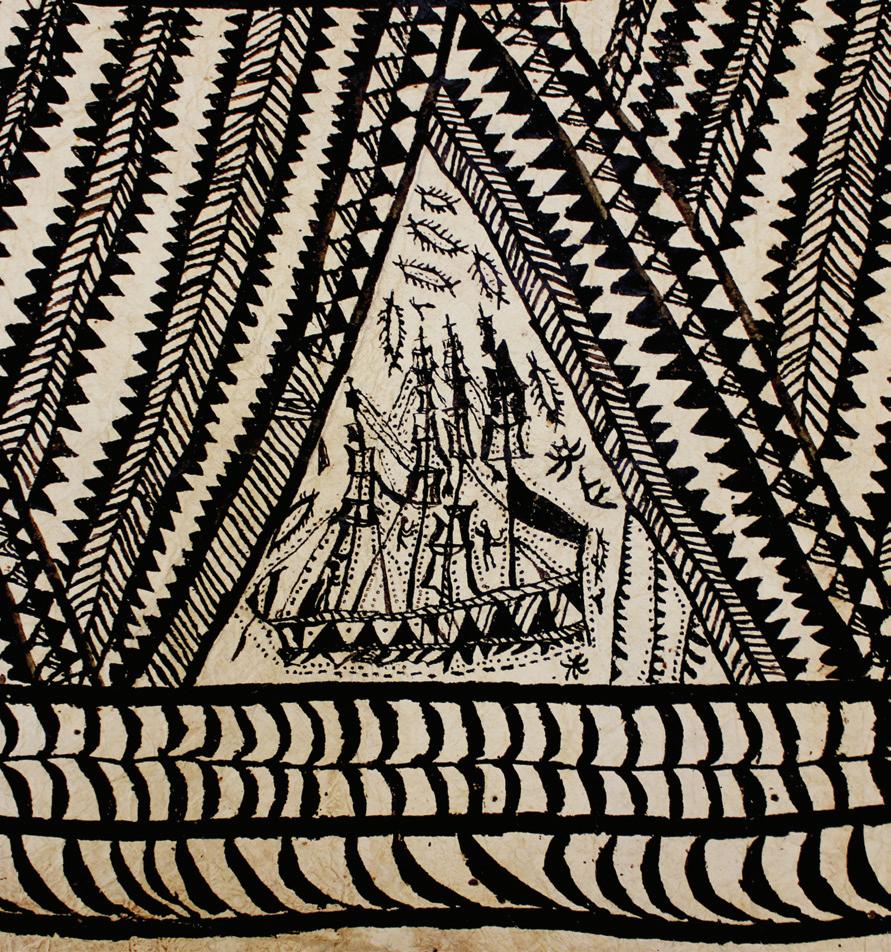
The similarity in style to other hiapo hints at a common maker, though the names of specific women hiapo makers from this time period have not been identified. While other hiapo include names of plants, places, and families, the letters and names in unique script on this cloth are, as of yet, unidentified.
The creation of hiapo in Niue decreased dramatically by 1900 with the introduction of cotton and other manufactured textiles from Europe. While the tapa tradition gained in popularity among Indigenous communities in Oceania throughout the 1900s, it is only in the past few decades that some contemporary Niuean practitioners have begun making hiapo again.
15 | Winter 2023
Figure 3. Maker once known (Niue), Hiapo detail, 1880-1890. Handmade bark cloth, 68 x 88 inches, New Bedford Whaling Museum, 00.200.452.
Figure 4. Maker once known (Niue), Hiapo detail with ship and sea life, 1880-1890. Handmade bark cloth, 68 x 88 inches, New Bedford Whaling Museum, 00.200.452.
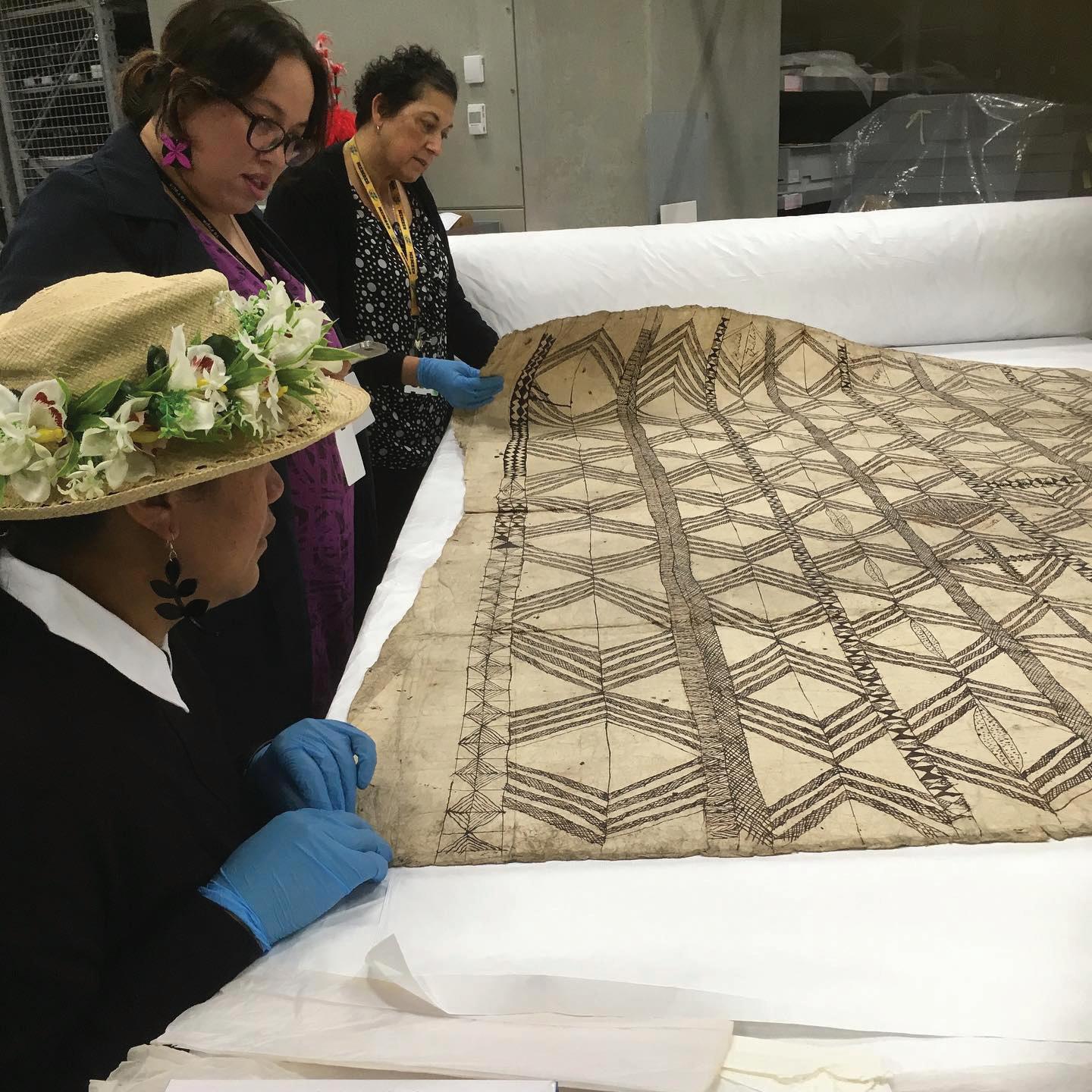
Multi-disciplinary artist and curator CoraAllan Lafaiki Twiss (née Wickliffe) (b. 1986) is a contemporary practitioner of hiapo. Twiss spent years researching local plant life and motifs on a variety of hiapos in museum collections in Australia and New Zealand. She took on the laborious art form, making the bark, creating the pigments, and painting different types of cloths with motifs from hiapo made in the 1800s and designs of her own making. She found mentorship in her craft from her Niuean grandparents and tapa practitioners in Samoa. The result of her work, influenced by fellow Niuean artist and novelist John Pule (b. 1962), is not only new works and modern interpretations of hiapo but an illustrated catalog that includes plant and animal designs and motifs in hiapos as well as personal vignettes from community members and elders about those things depicted in the hiapo cloth.8
8 Dionne Christian, “How artist Cora-Allan Wickliffe is reviving the ancient Niuean art of hiapo,” Woman Magazine, February 23, 2021, https://womanmagazine.co.nz/, accessed August 2023.
Twiss offered the following meditations about the hiapo in the NBWM collection.
Many of the hiapo pieces left the island with only one remaining from that time period at the Taoga museum in Niue. Finding hiapo in different collections around the world is exciting because it is like meeting an ancestor, a family member that you have only heard of and now finally get to meet.
When I saw an image of this hiapo I was overwhelmed by the great strength it showed not only in form after all these years but in the pattern works. When I look around at the Niue landscape I am looking at one of these hiapo. The first time I visited Niue it was like looking directly at a hiapo in colour, you could see the plants, the flowers and smell the air where these pieces would have been made.
16
Figure 5. Cora-Allan Lafaiki Twiss, visit to Te Papa Museum collections, Auckland, New Zealand, 2019. Courtesy of Cora-Allan Lafaiki Twiss.
Multi-disciplinary artist and curator Cora-Allan
Lafaiki Twiss (b. 1986)
is a contemporary practitioner of hiapo.
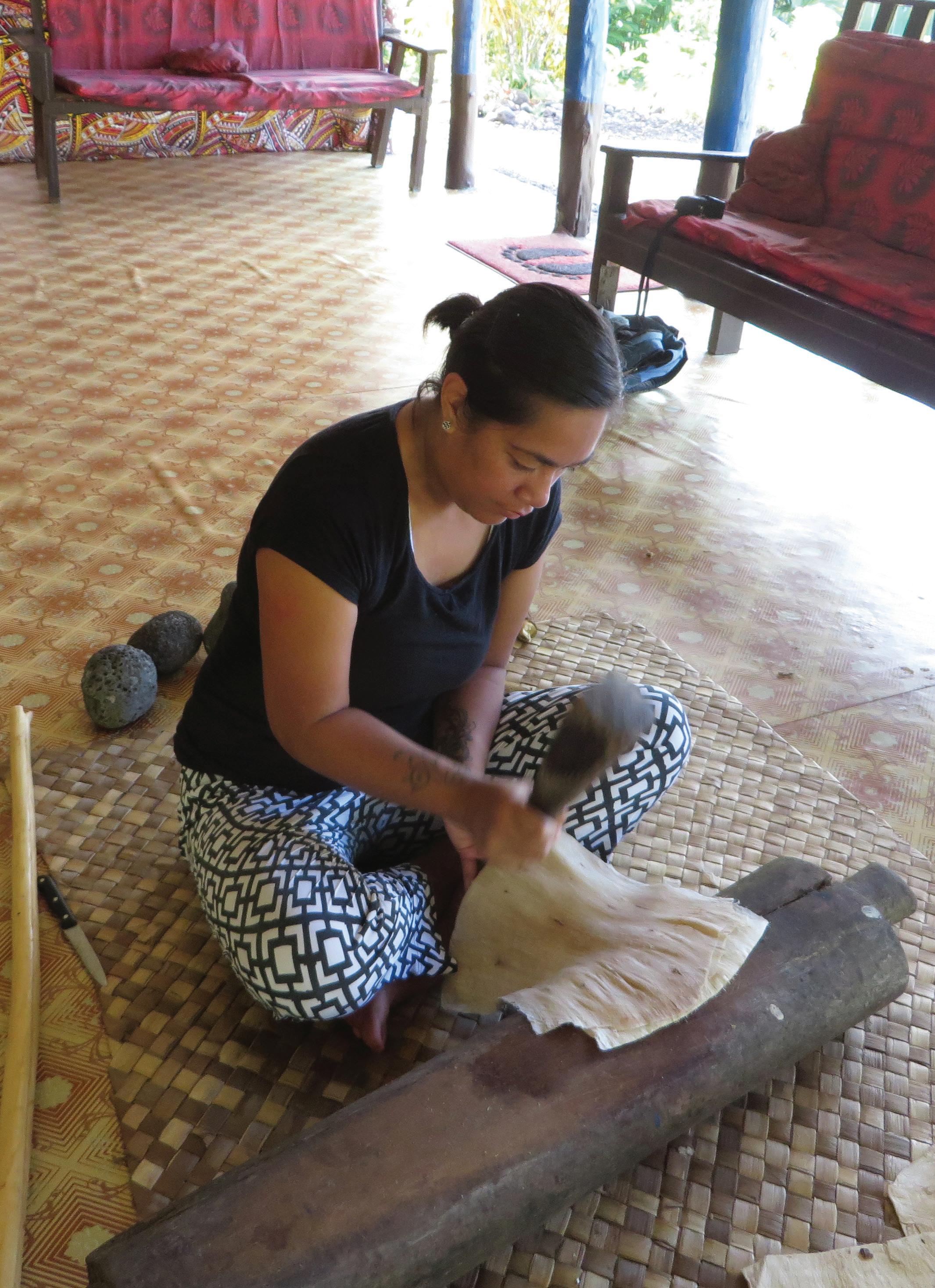 Figure 6. Cora-Allan Lafaiki Twiss making hiapo in Samoa with Fa’apito, 2019. Courtesy of Cora-Allan Lafaiki Twiss.
Figure 6. Cora-Allan Lafaiki Twiss making hiapo in Samoa with Fa’apito, 2019. Courtesy of Cora-Allan Lafaiki Twiss.
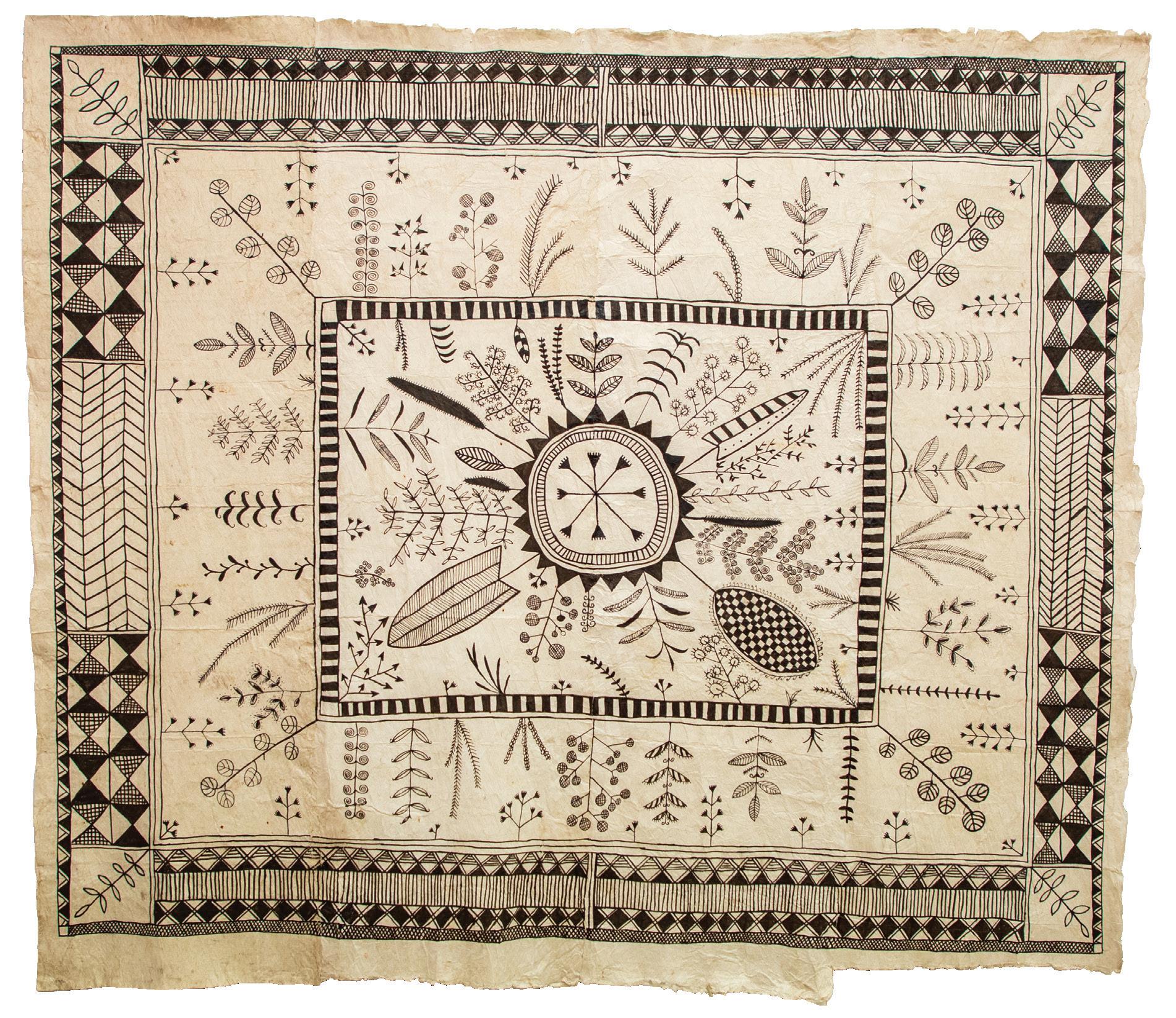
The ship in this hiapo example reminded me of how Cook tried to land on Niue but was unsuccessful due to warriors throwing stones at his crew and they were covered in blood (red banana paint) which is why Niue was named Savage Island. This interaction of people from Niue seeing a large ship would have been such a foreign experience and they acted right, they protected their land and their people during that first engagement.
The flows and forms around the ship itself are images of sea life that can be found in the many rock pools on Niue. Sea snakes, shrimps, crayfish and many different types of fish are found swimming around in the shallow and clear waters on the reef.
One of Twiss’ works and the hiapo documented in this article will be on view in the exhibition “The Wider World and Scrimshaw” opening at the New Bedford Whaling Museum in June of 2024.
While there are still many questions related to this particular hiapo, we do know that it is a tremendous example of this innovative and versatile art form and is imbued with a history and life that activates stories of Niuean culture.
18
Figure 7. Cora-Allan Lafaiki Twiss, Hiapo, 2019. On view at Vancouver Art Gallery, courtesy of Cora-Allan Lafaiki Twiss.
A Life of Courage, Integrity, and Purpose
By Samantha Santos, Interim Manager of Young Adult Programs

I’ve lived on the south coast of Massachusetts my whole life and was born right here in New Bedford. Even so, before starting work at the New Bedford Whaling Museum in 2023, I had never heard of Captain Paul Cuffe (1759-1817).
The Whaling Museum highlights this important figure in American history: a navigator, whaling master, merchant, civil rights advocate, and landowner. Curated with loans from the Westport Historical Society and Cuffe family descendants, along with objects from the Whaling Museum’s own collection, this powerful exhibition gives recognition to an often-overlooked local figure. His story is profound and one of my favorites. The exhibit is informative and moving, with interactive elements for all ages to enjoy. Of all the galleries in the Whaling Museum, I’ve found myself continuing to come back to this one, learning something new each time I walk through it.
Paul Cuffe was born on Cuttyhunk Island to a formerly enslaved father and Native American mother. He led a distinctly remarkable life. His
accomplishments include becoming one of the wealthiest African Americans of the time, a successful whaler and merchant, along with becoming one of the first African Americans to be formally accepted into the Westport Society of Friends Quaker meeting. His strong convictions are one of the things I appreciate most about Paul Cuffe. He put all possible effort into achieving what he believed in and advocated for and was by and large successful. In 1780, at 21 years old, Cuffe petitioned the Massachusetts Legislature to give African American men the right to vote, and although the petition was denied, three years later the Legislature gave all men in the state the right to vote. An outspoken anti-slavery advocate, Cuffe believed it would benefit African Americans to return to Africa and proposed the establishment of a colony in Sierra Leone, one of the first of several “Back to Africa” repatriation movements in American history. In the exhibit, you will see various objects relating to this movement. There are writings by Paul Cuffe in support of the colony and to those already settled in Sierra Leone. Additionally, there is a reproduction of the record of the families that Cuffe transported to
19 | Winter 2023
Fresh
Perspectives
Figure 1. This striking exhibit of anti-slavery memorabilia contains many objects, including shackles and a book containing a memoir of Paul Cuffe. Captain Paul Cuffe Exhibit, New Bedford Whaling Museum.
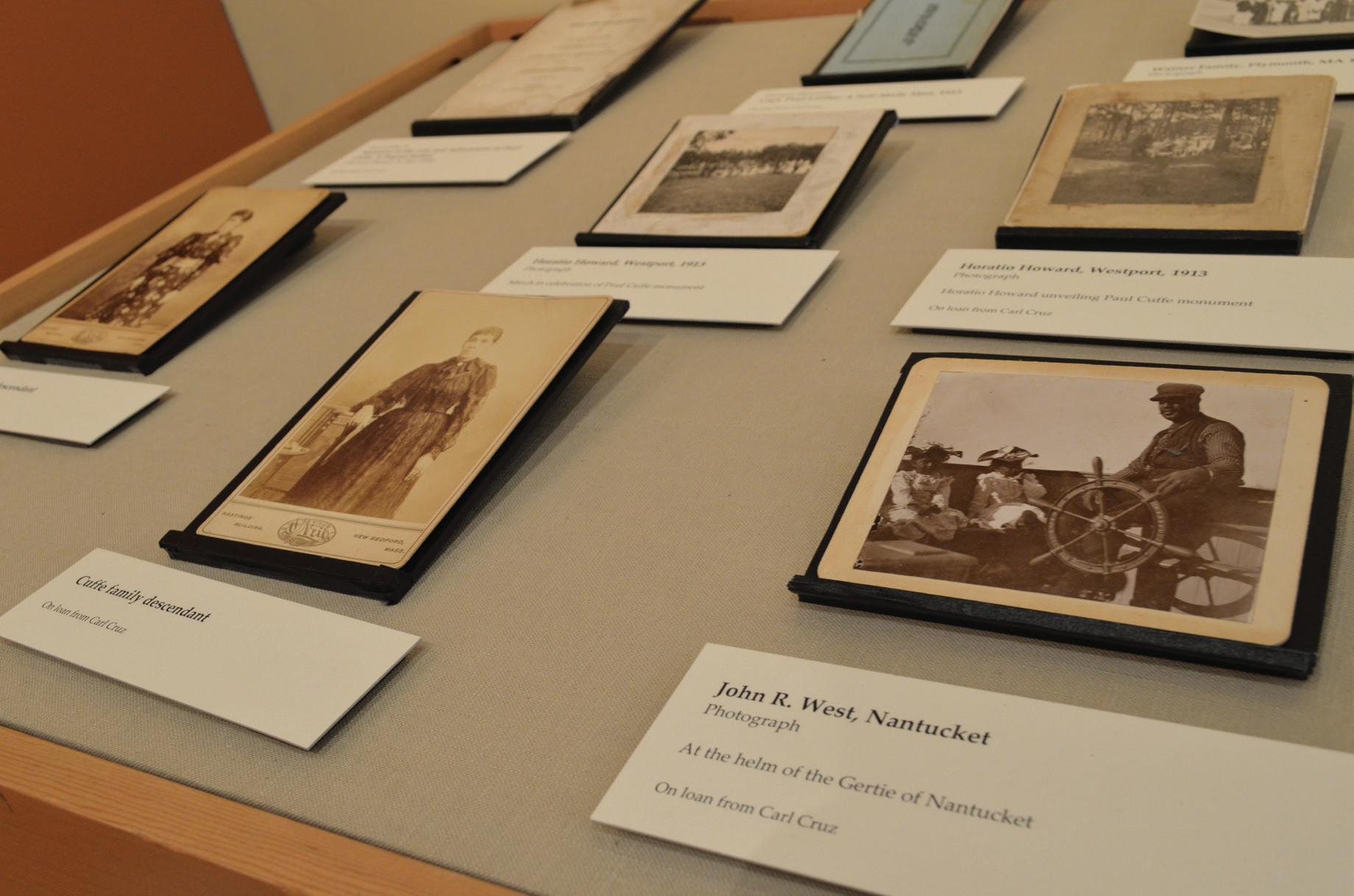
Sierra Leone in 1815. In total, 38 African Americans were brought to Sierra Leone on his ship, with the youngest passengers being just months old. I would highly recommend taking a moment to look at the names and ages of the families on the voyage. It’s likely these people were settling in a part of Africa their ancestors did not come from and they had likely never been, which further shows the racial issues of the time.
What moved me the most about his story was his meeting with President James Madison in 1812, which was a first for an African American. He sought to sit down with the President to address the seizure of his cargo ship, an incident which occurred off the coast of Rhode Island. During this historic meeting, Cuffe not only convinced the President to arrange for the return of Cuffe’s cargo, but also used the meeting as an opportunity to lobby for his proposed colony in Sierra Leone. The idea that a free man of African American and Native American descent would be welcomed to Washington D.C. by a slave-owning president truly shocked me. It is an incredibly inspiring story from a time in American history when
slavery was a major driver of the American economy and questions of racial equality were charged.
Given that there are no confirmed portraits of Paul Cuffe, likely due to the early Quaker belief that selfportraits were vain, historians and scholars only have an idea of what he may have looked like from his silhouette, the only documented likeness of Cuffe. A great set of objects on display in the gallery is a collection of photographs and possessions from Cuffe family descendants. These images of members of the Cuffe family from the nineteenth and twentieth centuries help to better envision what the influential figure might’ve looked like.
Paul Cuffe’s life was one of determination, perseverance, and activism. He never gave up on the things he set out to accomplish, and he blazed a trail for his African and Native American contemporaries. His achievements and legacy deserve our attention, and I’m certain that some part of his life will speak to you like it did to me. Next time you find yourself at the museum, take some extra time in the Paul Cuffe gallery and appreciate his unique perspective.
20
Figure 2. This exhibition shows photographs and printed materials related to Cuffe family descendants. Captain Paul Cuffe Exhibit, opened at the New Bedford Whaling Museum on September 21, 2018.
Whaling Journals as Dream Diaries
Mark
D. Procknik, Director of the Dighton Public Library, and former Librarian at the New Bedford Whaling Museum
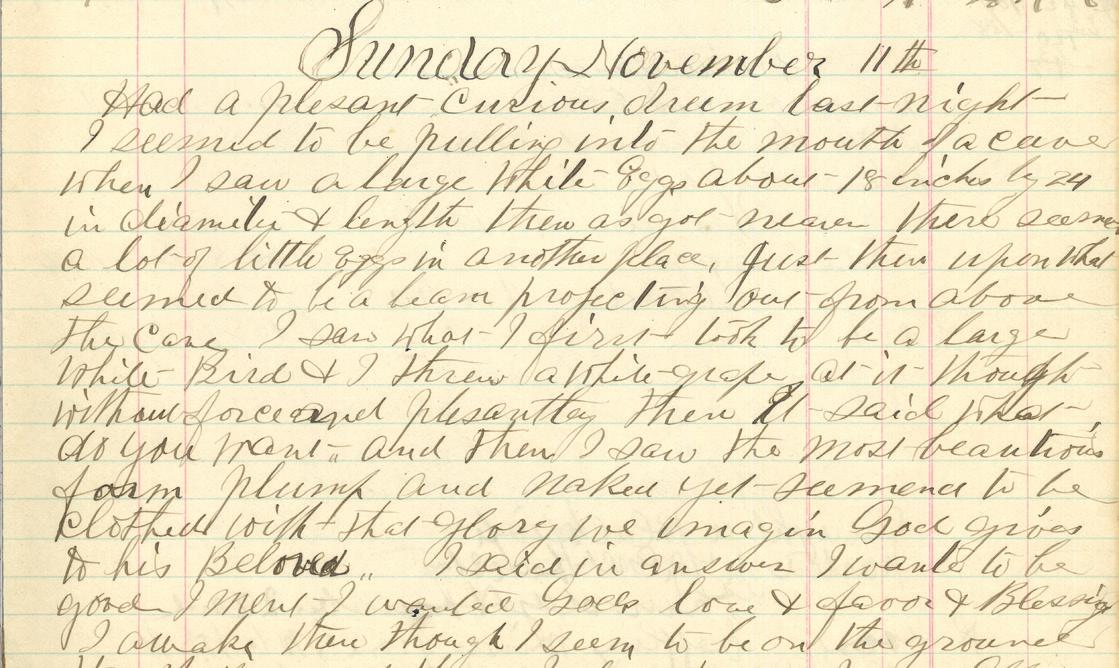
Over the years, many prominent psychologists have offered their opinions on dreams and dream interpretation. Carl Jung believed that dreams provided a vehicle for the unconscious to communicate with the conscious mind, while Sigmund Freud similarly hypothesized that dreams provided a method for the unconscious mind to express itself in ways that were not possible while a person was awake. Whatever the clinical consensus, psychology points to dreams serving as a window into one’s unconscious thoughts. While logbooks served as the official record of a whaling voyage and provide strict reporting on notable events, journal keepers could “write anything they felt like writing and often embellished or elaborated on the daily events of the voyage.”1 As a result, journals contain detailed personal reflections on a wide range of topics, including, curiously enough, the keeper’s personal dreams, which appear in a few dozen journals.
Whaleman Marshall Keith (1838-1870), kept one
1 Michael P. Dyer, “O’er the Wide and Tractless Sea”: Original Art of the Yankee Whale Hunt (New Bedford, MA: Old Dartmouth Historical Society/New Bedford Whaling Museum, 2017), 39.
such journal onboard the 1866 voyage of the ship Cape Horn Pigeon of Dartmouth, MA, which contains several references to dreams.2 Keith’s journal entries paint a detailed picture of his unconscious thoughts and desires. He writes in multiple entries that he’s dreaming of his wife Sarah, with the majority of such entries including only a sentence or two describing his homesickness.3 However, some entries contain more detailed descriptions of his dreams, including one written on September 16, 1866, where he describes entering a room, meeting a female stranger, and dancing with her until his beloved wife Sarah enters the room. Keith immediately embraces his wife and proceeds to dance with her, writing that the “door opened and in [Sarah] came when I caught [her] in [my] arms and kissed [her] and began to dance with [her]” until the dream ended.
2 Bark Cape Horn Pigeon of Dartmouth, MA, Charles H. Robbins, master, Marshall Keith, keeper, June 29, 1866-September 4, 1867, incomplete sperm and right whaling voyage to the Indian Ocean. ODHS #371.
3 Marshall Keith and Sarah Pope (1842-1872) of Mattapoisett, MA were newlyweds in 1866, the year he left on this three-year voyage.
21 | Winter 2023
Book Talk
Figure 1. Andrew J. Mosher. Journal kept onboard the bark Wave of New Bedford, 18871889, a partial sperm whaling voyage to the South Atlantic, condemned at St. Helena. NBW # 1326. Gift of Levi E. Wood.
Keith offers no interpretation of this dream, electing instead to describe the events exactly as he remembers them, but it is obvious that his wife serves as the dream’s emotional focal point. Throughout his journal, he leaves little to the imagination regarding the subject of his affections, as he pens each entry as a letter to his wife back home, who dominates his waking thoughts. Some further interpretative analysis on his part might have been fascinating in this case, as there are many unanswered questions regarding his dream’s elements. Who was the stranger, why did he dance with her, and what happened to her after his wife arrived in the room? What exactly was Keith’s unconscious trying to tell him through this dream? It may be impossible to know, as the only aspect that he appears to take from this dream is his wife’s presence.
Another journal in the collection offers a much deeper glimpse into the mind of an individual. Captain Andrew J. Mosher’s journal kept onboard the bark Wave of New Bedford, 1887-1889.4 He not only describes a dream he had during the voyage, but provides his own interpretation of it. Captain Mosher writes in his journal that he had a “curious dream” on November 11, 1888, where he entered a cave and saw a large white egg. As he walked closer, he saw many smaller eggs, but a beam of light above the cave soon caught his gaze, and he witnessed a large white bird in the air. He threw a white grape at the bird and asked the bird what it wanted. At that moment, Mosher witnessed the bird transform into a form he perceived as the “glory we imagine God gives to his beloved.” Awed at the sight, Captain Mosher immediately answers his own question and states that he “wants to be good” and “wanted God’s love and favor and blessing.”
Mosher’s journal contains one of the most detailed accounts of a dream in the collection, but his interpretations are what make this journal significant. According to Mosher, he dreamt of God, who revealed to him how to be a good person and live his life. This explanation should come as no surprise to any who have read further into Mosher’s journal, as he readily displays his religious attitudes and mindset
4 Bark Wave of New Bedford, Andrew J. Mosher, master and keeper, August 25, 1887-January 5, 1889, a complete sperm whaling voyage to the South Atlantic. NBW #1326.
in multiple entries, thanking God for blessing his voyage with sperm whales, thanking God for granting the voyage with oil after stowing down, and asking God for strength and guidance in dealing with a difficult crew. It seems no coincidence that such a deeply religious person would have such a religiously charged dream.
However, given all that Captain Mosher describes in his dream, some interpretive questions remain. What was the significance of the cave, the egg, the beam of light, the grape, and the bird? Are these all religious symbols with spiritual undertones, or did Mosher’s dream have any secular messages that his interpretation overlooked? He also does not provide any detail regarding the perceived form that he interpreted as the glory of God. Could this form, perhaps, have other significance? Given his devout mindset, it may have made sense for him to see God in his dream as his conscious mind sees God’s influence everywhere in the world. However, would an individual with a more secular mindset interpret the dream the same way?
While experts continue to theorize the meaning of dreams, the dreamer’s conscious mind might not always understand what the unconscious mind is trying to convey. Were there perhaps other meanings behind Marshall Keith’s or Captain Mosher’s dreams? There is no way to tell as only they know the intensely personal details of their dreams. Keith does not describe the female stranger in any detail. She is only somebody he danced with before his wife arrived, and once his wife appeared in the room, she then became his emotional focus and the primary subject of the dream. Perhaps Captain Mosher, given his religious predispositions, would have interpreted Keith’s stranger as an angel or an angelic being, while Keith may have interpreted the unknown form that appeared to Captain Mosher as his beloved wife Sarah. Without intimate knowledge of Keith’s and Mosher’s unconscious thoughts, a detailed analysis of their dreams is impossible. However, their journals offer a unique window into their minds, as their thoughts and experiences remain preserved in the Museum’s logbook and journal collection.
22
Spreading the Word
From the Page: Transcription Stories
Naomi Slipp, Crocker Endowed Chair for Chief Curator & Director of Museum Learning
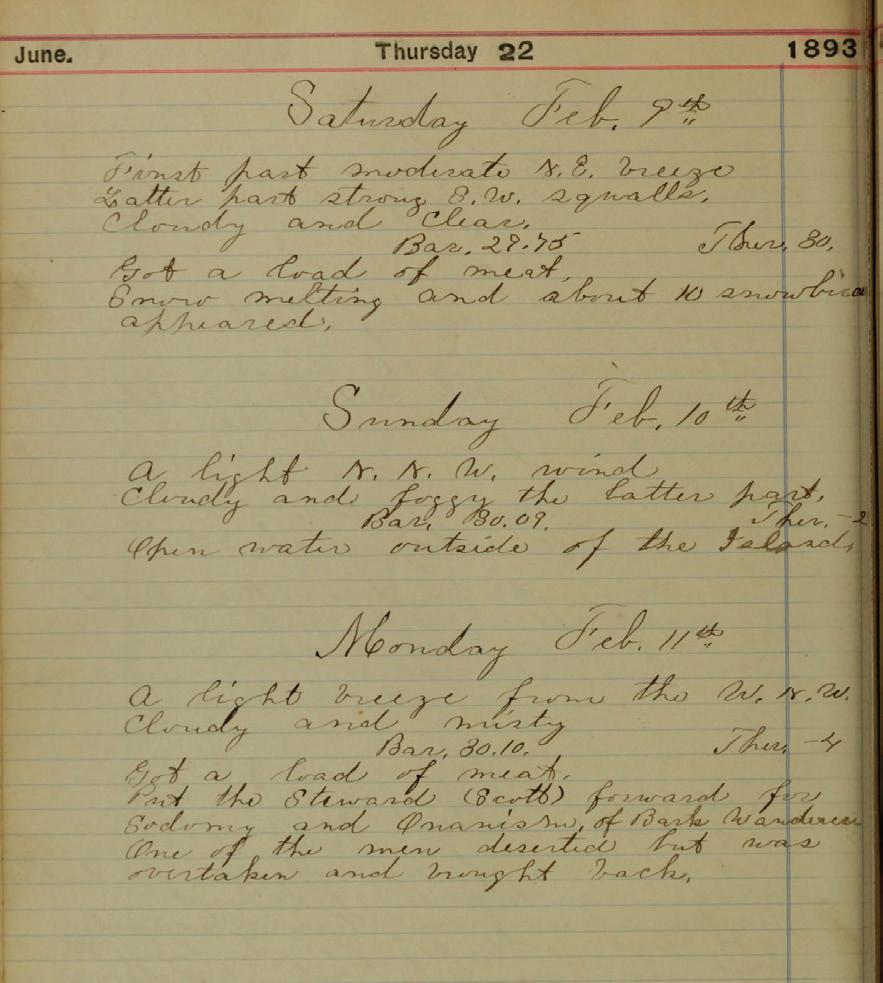
The Museum houses a staggering array of rare books, manuscripts, and archival collections, estimated at about 800,000 individual items and including over 2,500 whaling logbooks and journals.
As an institution dedicated to the promotion of scholarly inquiry, we have begun to consider how the standardized keywords and cataloguing terminology that we employ may not have caught up with the research interests of today. Indeed, what terms related to objects or manuscripts in our collection should we be including in indexes to help scholars find relevant materials and answer certain historical questions?
Over the past five years, the Museum has taken measurable strides in recording women’s history related to whaling and to documenting the diversity of the whaling industry. However, when it comes to the queer histories of whaling, we have work to do. This conversation began when Joe Quigley, a volunteer transcriber, shared that they had discovered reference to sodomy and onanism (self-pleasure) in one of our whaling logbooks.
From the log of the Newport (Steam barkentine), of San Francisco, California, mastered (in the following order) by William P. Porter, James Tilton, Hartson H. Bodfish, and G.B. Levitt, kept by Hartson H. Bodfish, on a whaling voyage from 1 June 1892 to 26 September 1898:
Monday Feb 11th (1895)
A light breeze from the W.N.W. / Cloudy and misty / Bar. 30.10. Ther. -4 Got a load of meat.
Put the Steward (Scott) forward for Sodomy and Onanism, of Bark Wanderer.
One of the men deserted but was / overtaken and brought back.
In this brief entry (Fig. 1), the keeper records that a formal charge was made against the steward of the Bark Wanderer for sodomy and onanism, both charges that, at the time, would have implied sexual acts between men. What are we to make of this?
Intimacy and romantic love between men on shipboard is implied in sources ranging from Moby Dick to the many historical studies on this topic
23 | Winter 2023
Figure 1. Entry of log of the Newport (Steam barkentine) for February 11, 1895.
related to piracy and the Royal Navy, respectively.1 The average whaling voyage lasted between 3 to 5 years. On these voyages, an average of 20 men were closely confined at sea.
Despite this, few historical records related to whaling history document instances of romantic love or sexual acts between men on shipboard or at port (Fig. 2). In most cases, when these stories are recorded, it is for disciplinary or legal purposes and framed as illegal or amoral. This raises a number of questions:
1) did period censorship of personal journals or historical sources intentionally erase such histories?
2) did captains overlook such activities to keep the peace, or avoid the headache of a formal charge?
3) could individuals reasonably hide such relationships at sea and avoid being caught?
1 For further reading, see: Cecil Adams, “Rum, sodomy, and the lash,” The Straight Dope (Sept 2, 2008); B. R. Burg, Sodomy and the Pirate Tradition (New York: New York University Press, 1995); Briton Cooper Busch, “Whaling will never do for me”: The American Whaleman in the Nineteenth Century (Lexington, KY: University Press of Kentucky, 2009); Kyle Dalton, “Homosexuality in the Royal Navy,” British Tars, 1740-1790 (January 15, 2018); Arthur N. Gilbert, “Buggery and the British Navy, 1700-1861,” Journal of Social History 10:1 (1976), 72–98; Shane McMurray, “Sailors and sexuality: searching for LGBTQ+ histories in the Royal Navy,” Royal Museums Greenwich (Feb 1, 2023); Suzanne J. Stark, Female Tars: Women Aboard Ship in the Age of Sail (Annapolis, MD: Naval Institute Press, 2017).
4) did such relationships go unrecorded out of prurience or a reluctance to name the act? 5) how common were tender, loving consensual relationships between whalers?
We may never know how Scott self-identified, the context of this charge, who he had a relationship with, or what happened to them after this event. The logbook makes no other references to Scott.
We can, however, think about sexuality in whaling history, and consider what tools we, as an institution, are providing to researchers who are interested in studying this topic in relation to our collections. Moving forward, we will be surveying the subject tags that we use to identify the contents of our manuscript collections to be as broadly inclusive as possible. Finding references to individuals like Scott in the historical record point to potential maritime histories that have yet to be fully explored or told.
Curious what other collections-based maritime histories relate to gender and sexuality on shipboard? Visit the Museum’s newest temporary installation, curated by Photography Collection Curatorial Fellow Marina Wells (PhD candidate, American & New England Studies, Boston University), to learn more about this topic.
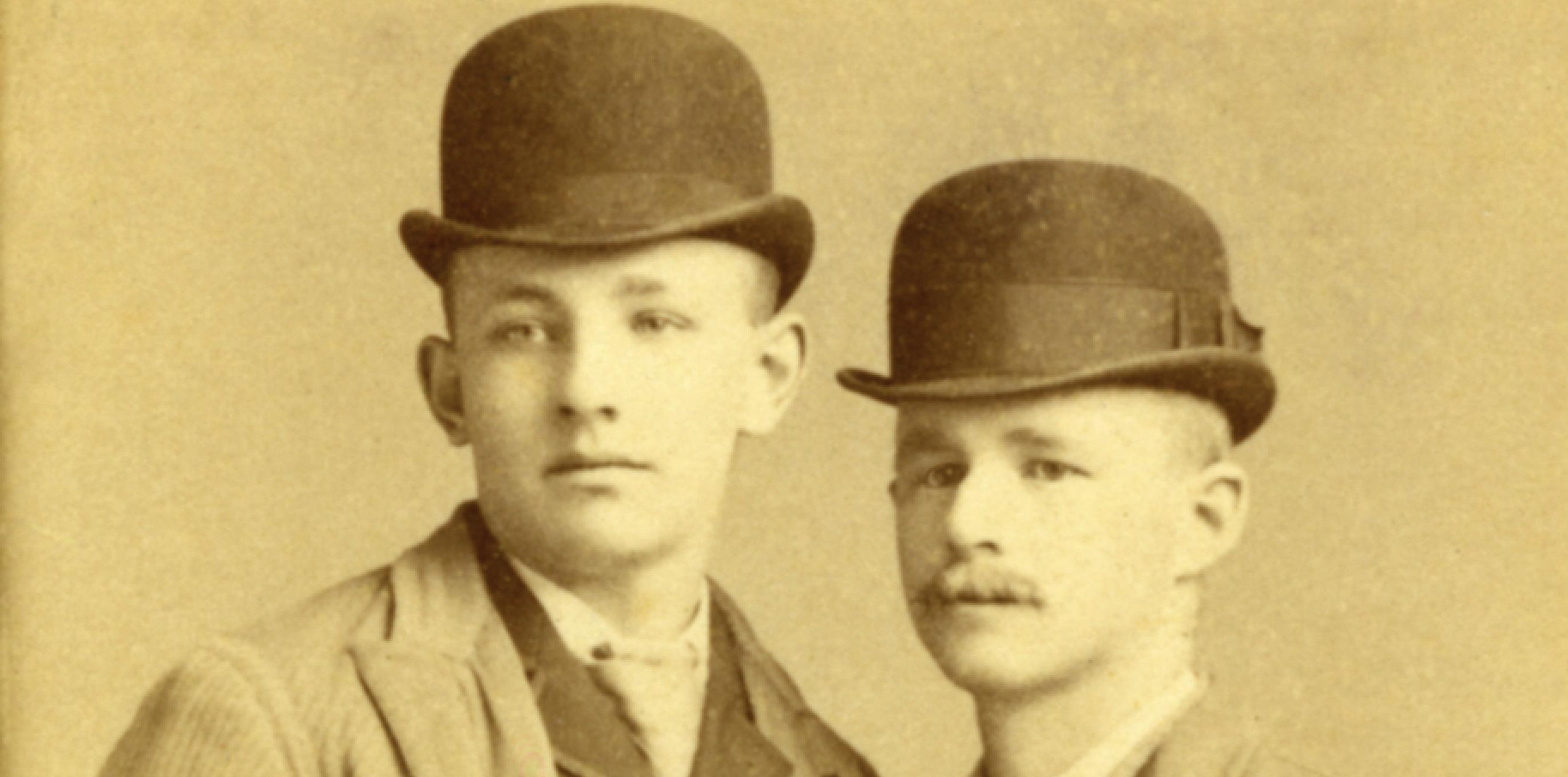
24
Figure 2. O’Neil Studio, New Bedford, Mass., “Portrait of two unidentified young men,” c. 1880. Carte-de-visite, NBWM 2009.6.19.
Exhibit Preview
The Wider World & Scrimshaw
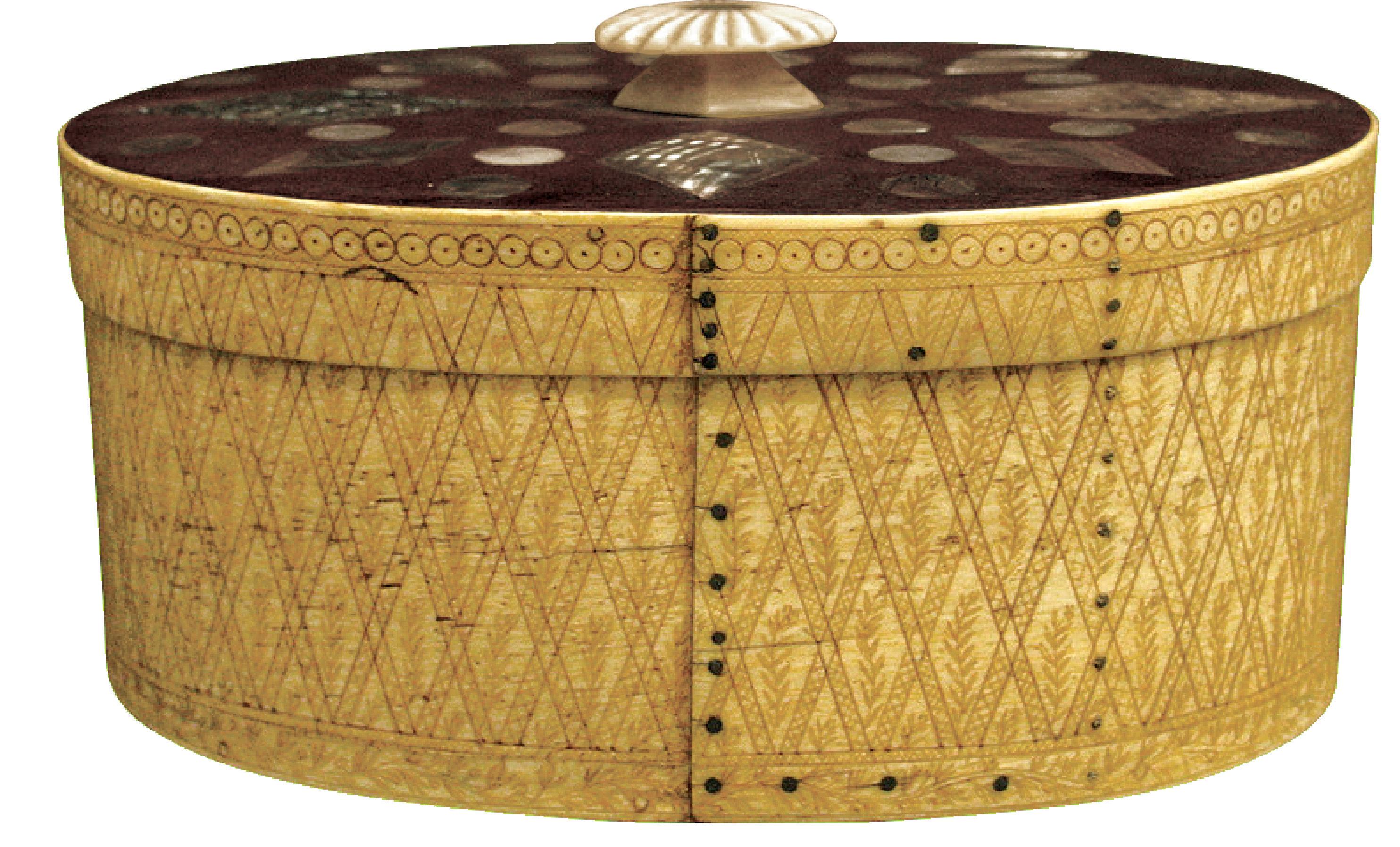
In June 2024, the New Bedford Whaling Museum will open the major exhibition The Wider World & Scrimshaw, which takes the Museum’s scrimshaw collection (objects carved by whalers on the byproducts of marine mammals) and places it in conversation with carved decorative arts and material culture made by Indigenous community
members from across the Pacific Rim and Arctic. Native communities across Oceania, the Pacific, and Arctic had cosmologies related to whales, distinctive maritime traditions involving marine mammals, and vibrant carving styles. They were also impacted by commercial whaling ventures, and the external pressures from colonialism and Western exploration.
25 | Winter 2023
Maker once known, Scrimshaw box, c. 1860. Red cedar, whale skeletal bone, green abalone, and mother of pearl, 7 x 53/8 inches, NBWM, 2001.100.1087
This interdisciplinary, community-driven, and collections-focused project engages questions about identity, place, and material, and considers how exploration and whaling impacted the production of material culture in this diverse region between 1700 and today. The exhibition showcases over 300 objects, paying particular attention to ones that indicate cultural and material exchanges. How did Pacific Rim communities encounter whalers and influence items produced, and how did whaling (internal or external) impact these communities and their unique art forms?
Open-ended questions probe visitor expectations about different cultural products from Oceanic material culture and Arctic carvings to engraved sperm whale teeth, and explore issues related to trade, markets, taste, and patterns of popular consumption; assumptions about materials (coconut shells, whale teeth, walrus ivory, human hair), their circulation, and animal agency; differences between cultural and commercial value systems; disciplinary hierarchies related to craft traditions, folk-art, anthropology, and “fine” art; and gender roles, for making and consumption.
This oval scrimshaw ditty box demonstrates the dynamic circulation of Indigenous Pacific materials utilized by whalers to make and decorate scrimshaw while on shipboard whaling in the Pacific. The body of the box is made of whale skeletal bone elaborately engraved with a repeating geometric hatching pattern, inset with a leafy sprig or feather. The lid of the box (see centerfold) is made of western red cedar wood (Thuja plicata) inlaid with diamonds and dots shaped from richly iridescent green abalone shell (Haliotis fulgens) and paler iridescent dots made of nacre (mother of pearl) from the nautilus shell (Nautilidae). The materials used to make this box are consistent with the geographical regions along the coast of California, Oregon, and Kodiak Island, where gray whales (Eschrichtius robustus) were commercially exploited in the 1850s through 1870s. How did the whaler who made this box acquire these geographically specific materials? Who did they meet when trading, and what forms of cultural expression informed the design, style, and construction of this box?
These questions are just some of the rich considerations that come to the fore in Wider World. We are working with a diverse advisory board to explore the rich cultural traditions, carving forms, and material exchanges that emerged and were shaped by cultural contact across the Pacific Rim in this period.
The Wider World & Scrimshaw is open June 14 to November 11, 2024 at the New Bedford Whaling Museum.
Native communities across Oceania, the Pacific, and Arctic had cosmologies related to whales, distinctive maritime traditions involving marine mammals, and vibrant carving styles.
26
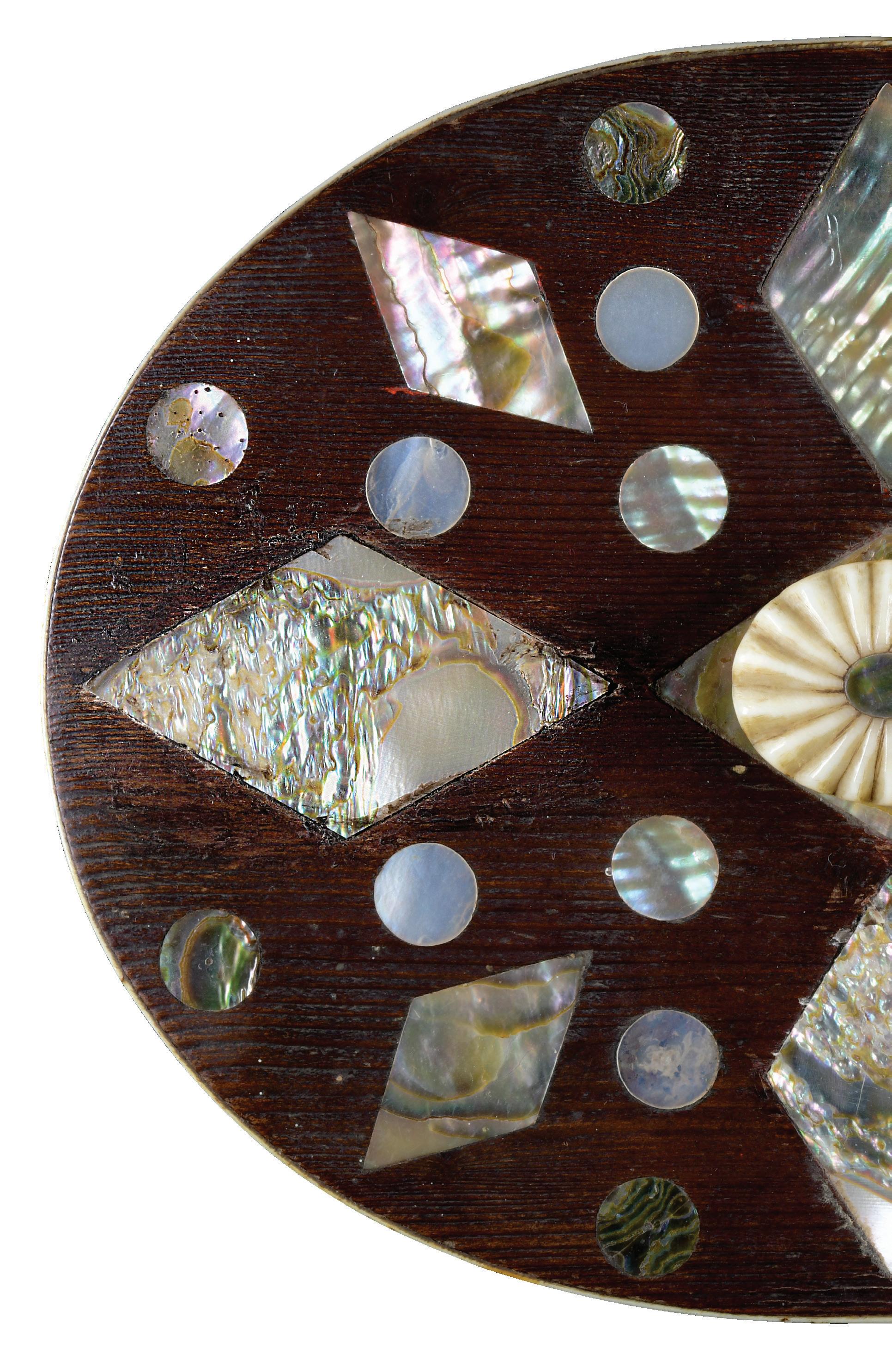
27
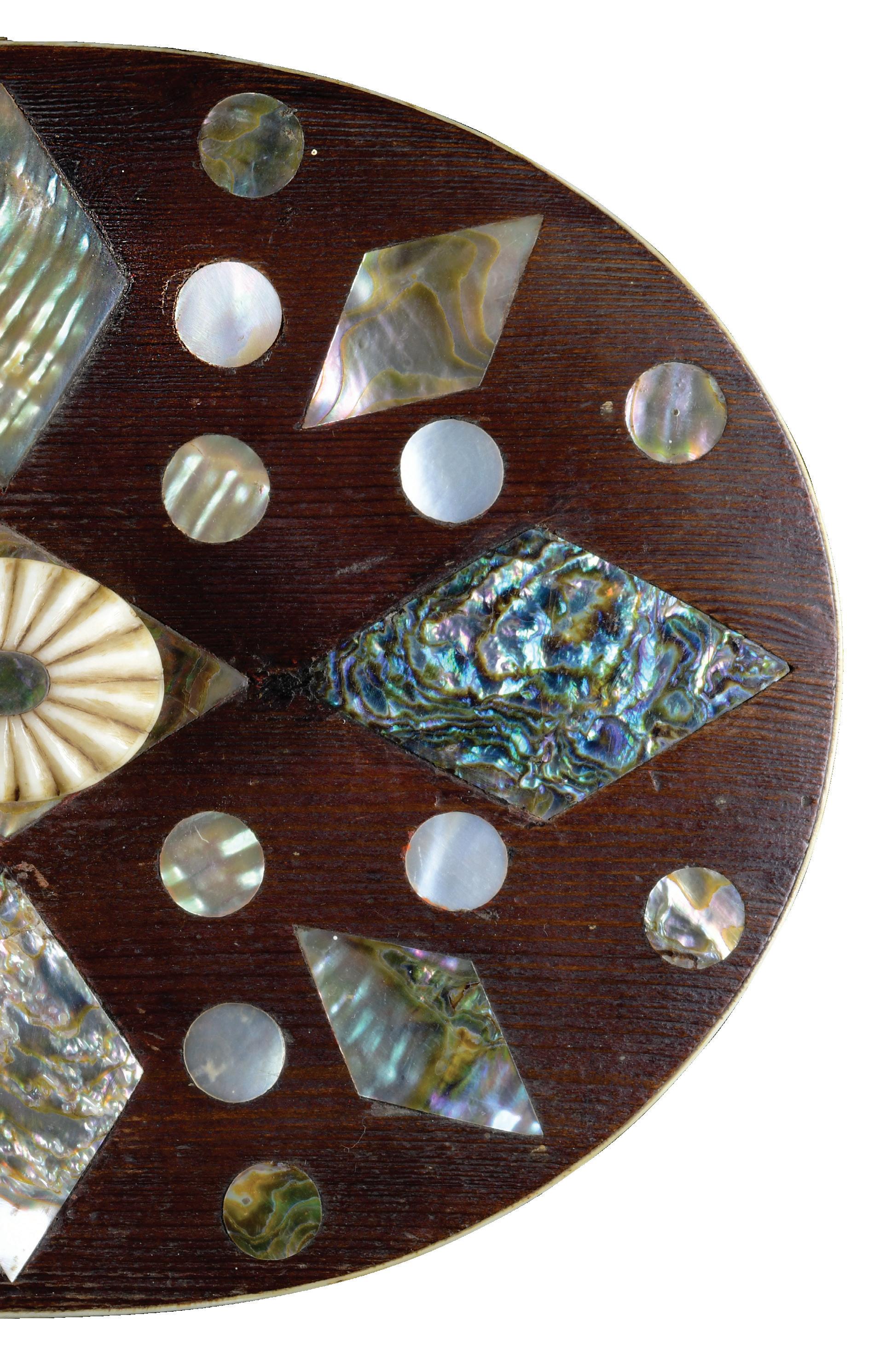
28
From Our Fellows
The Daguerreotype and Ambrotype in New Bedford
Marina Dawn Wells, Photography Collection Curatorial Fellow
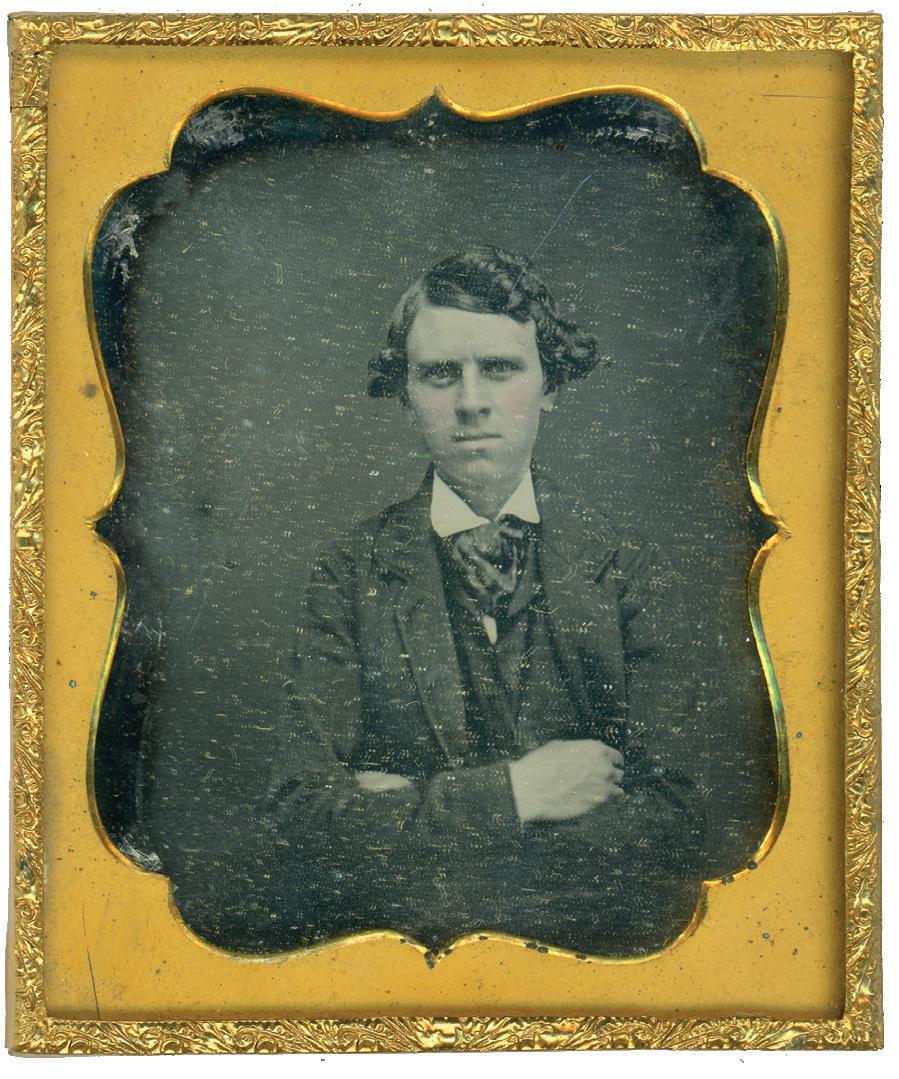
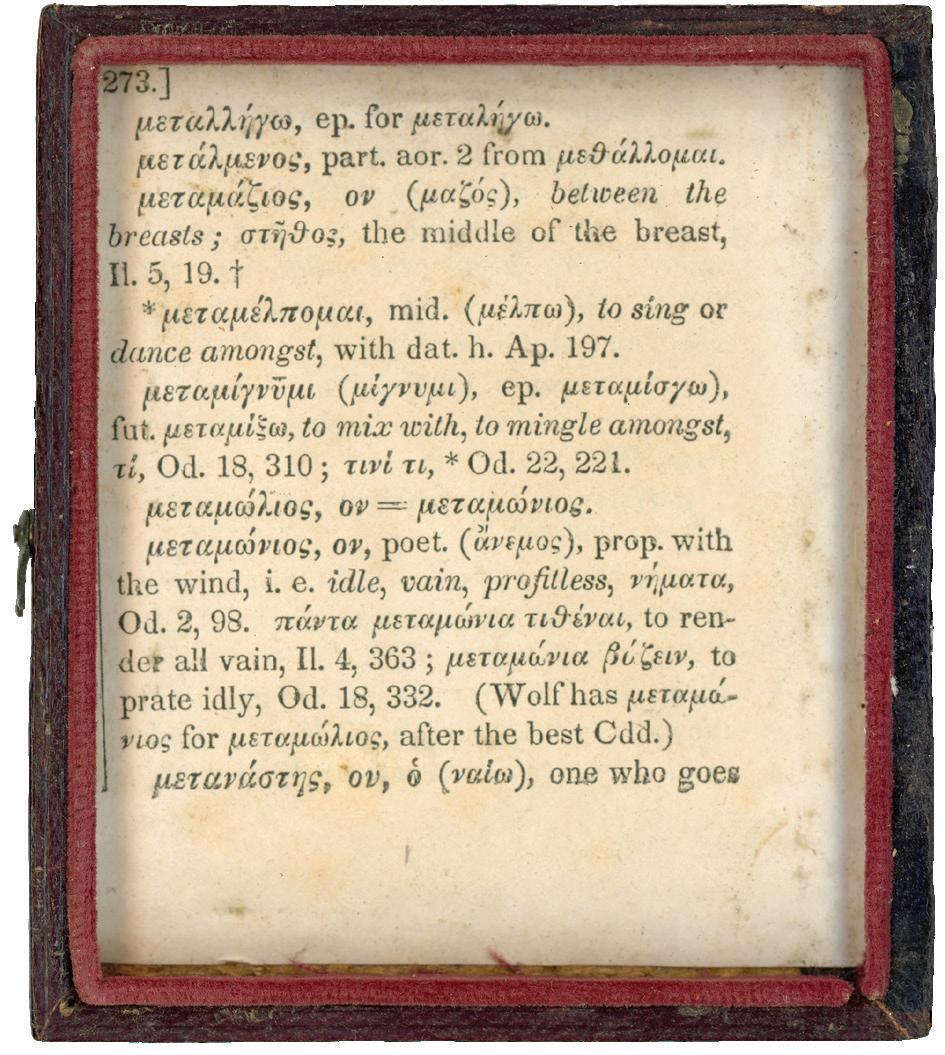
The New Bedford Whaling Museum/ Old Dartmouth Historical Society holds somewhere around one million pieces in its collection; tens of thousands of three-dimensional objects including ship models, scrimshaw, natural history specimens, tools, dolls, textiles, prints and paintings, maps and charts, ships plans, books of all kinds, and ream upon ream of manuscript material. However, about 200,000 items comprise an important but lesser-known area of the collection: photography. Since September of 2022, I have worked as the
Photography Collection Curatorial Fellow, where I have studied, catalogued, and generally gained a broad understanding of this unique segment of the Museum’s collection. My primary focus has been to survey and assess the earliest works in this group, comprising tens of thousands of images made before 1900 and representing the output of hundreds of photographers.
At the second annual meeting of the Old Dartmouth Historical Society in 1905, members agreed to
29 | Winter 2023
Figure 1. Maker once known, Portrait of Thomas Almy and the excerpt from a Greek-English dictionary that hid behind it, undated. Sixth plate daguerreotype, NBWM 2018.23.54.
Almy was a Rhode Island-born seaman who became a master’s mate on the U.S. Navy steam-sloop USS Wachusett. Almy died during the Civil War in battle at City Point, Virginia in 1862. The corner of the dictionary’s page lists such Greek translations as “between the breasts,” “to sing or dance amongst,” “to mix with, to mingle amongst,” and “idle, vain, profitless.”
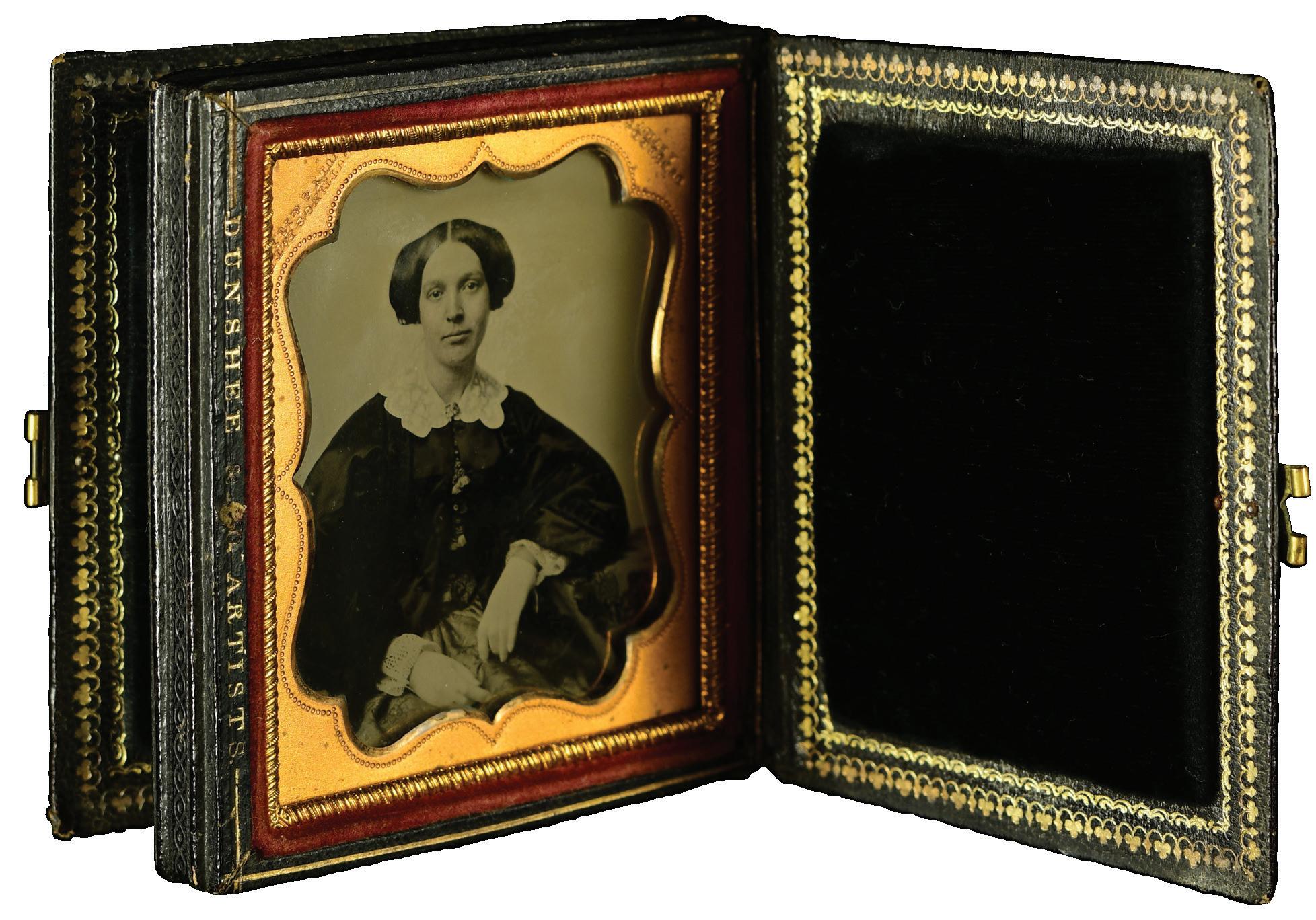
This cased ambrotype was likely taken at the same time as Captain McKenzie’s portrait in the collection (2000.100.1830), either before his departure as first mate on the whaling bark Mars (1856-60) or as captain of the whaling bark Cherokee (1860-64). It is possible the McKenzies exchanged portraits before the captain’s time at sea. Looking closely at the edges of the brass mat, it is possible to discern a parallel mat behind the one pictured. This example is reversible and shows the extent to which ambrotypes were transparent. Because an ambrotype was actually a negative image, it required a black backing to make the negative image appear to be a positive one.
allocate funds and space to support the collecting and exhibition of photography.1 Over a century later, the collection now spans nineteenth-century tintypes to present day digital photographs. Within this diverse array of photographs are hundreds of daguerreotypes and ambrotypes, some of the very first types of photographs invented. Daguerreotypes were introduced to the United States from France in
1839, and glass ambrotypes followed in the 1850s.2
Both excited the American public and emerged as accessible forms of portraiture for people voyaging in and out of New Bedford’s bustling whaling port at
1 “Proceedings of the Second Annual Meeting of the Old Dartmouth Historical Society at the Rooms of the Society, New Bedford,” Old Dartmouth Historical Sketches 9 (March 17, 1905), 4.
2 Historians of photography generally credit Louis-Jacques-Mandé Daguerre (1787-1851) and William Henry Fox Talbot (1800-1877) with the two first photographic inventions that occurred about simultaneously in 1839. Daguerre created silvered copper plates called daguerreotypes, and Talbot created salt prints called calotypes or talbotypes. Daguerre’s invention became more widespread in its commercial accessibility, in standardized sizes and cases that the ambrotype would later adopt. James Ambrose Cutting (1814-1867) patented the ambrotype in Boston in 1854, although it had already been in use after Frederick Scott Archer (1813-1857) published in England about the wet collodion process in 1851. As is evident from the daguerreotype and talbotype, these figures often gave eponymous names to their inventions—and it is said that ambrotype may have come from Cutting’s middle name, derived from the Greek for “immortal.” See, for example, Mary Warner Marien, Photography: A Cultural History (London: Lawrence King, 2010 [2002]).
30
Figure 2. Edward Sidney Dunshee, Portrait of Susan A. McKenzie, wife of Scottish-born whaling captain James H. McKenzie, undated. Sixth-plate ambrotype, NBWM 2000.100.1831.
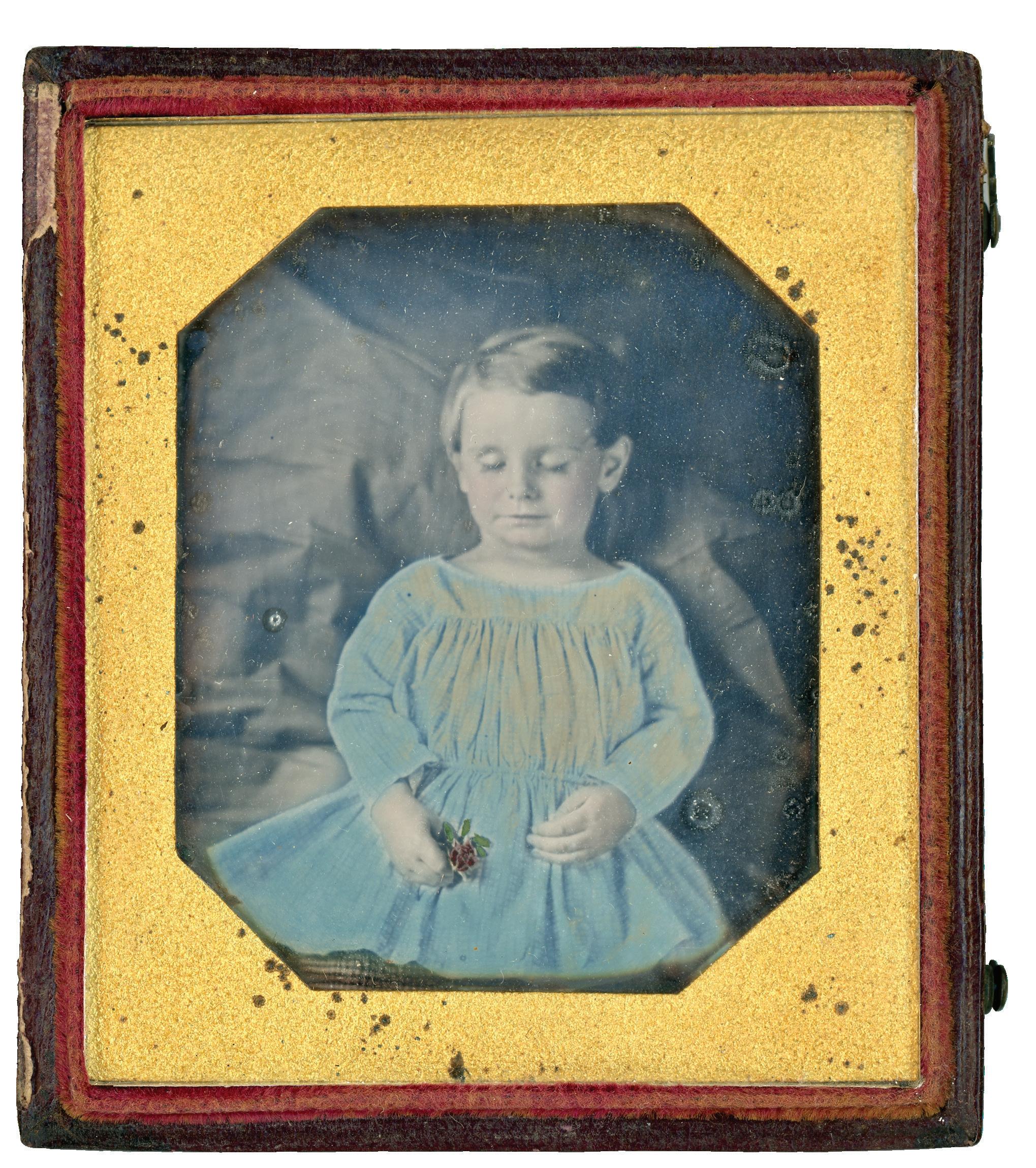
An advertisement behind the plate, glass, and brass preserver reads, “Made by William Shew, corner of Court & Howard Sts, Boston.” Shew was a case maker, daguerreotypist, and dealer of daguerreotype materials from 1844 to 1850.
midcentury. Examining roughly 500 of these studio portraits in the NBWM collection has helped piece together a clearer picture of how photography first developed in nineteenth-century New Bedford.
In the 1840s and 1850s, photography was a combination of artistry and chemistry. Daguerreotypists captured light on polished copper plates that they protected in folding cases, with paper lining on one side of their metal surface, and a pane of glass and brass mat on the other. In 1841, itinerant photographers “Messrs. O’Brien and Faxon” were the first to create these material composites in New
Bedford.3 They would have arrived on those cobbled streets with various materials in tow: silvered copper plates that would capture the images, chemicals like
3 According to the New Bedford Mercury on July 9, 1841, O’Brien and C. Faxon performed their work at number 7 Cheapside, now Purchase Street. They advertised taking on potential pupils for the few days they would be in New Bedford, and remarked that they copied the practice of “Professor Morris of New York.” They would also travel to Springfield, Massachusetts, to set up a studio at Masonic Hall the following September and October, according to the Springfield Gazette. See also Nicholas Whitman, A Window Back: Photography in a Whaling Port (New Bedford, Mass.: Old Dartmouth Historical Society, 1994); Chris Steele and Roland Polito, A Directory of Massachusetts Photographers 1839-1900 (Camden, ME: Picton Press, 1993).
31 | Winter 2023
Figure 3. William Shew, Hand-colored daguerreotype of a deceased child holding a flower, 1840s. Sixth plate daguerreotype, 2000.100.1782.
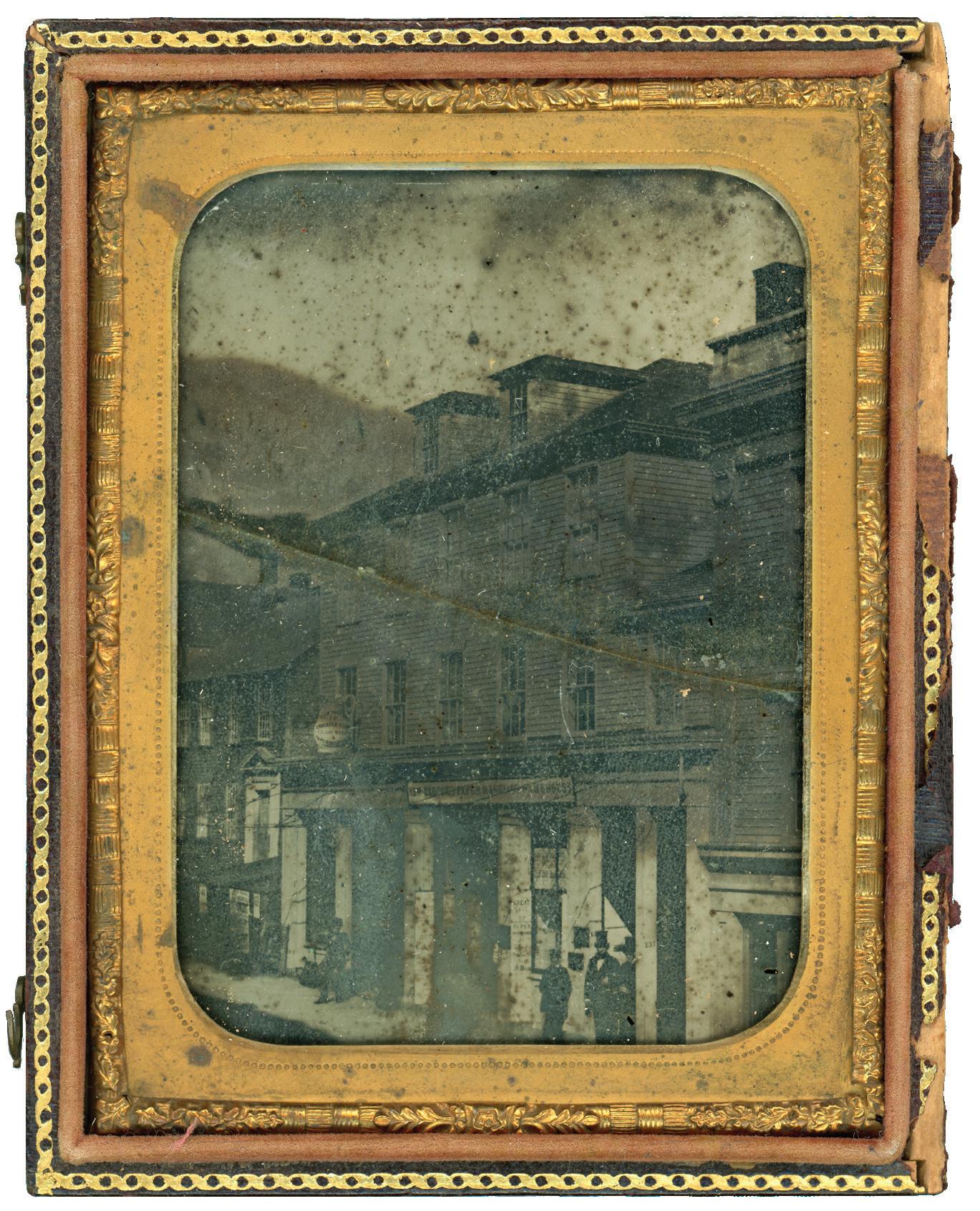
iodine and mercury to sensitize and develop them, and bulky wooden cameras that honed light through their brass-mounted lenses. This chemistry served to fix images on plates of standardized sizes: sixth plates measured 2 ¾ x 3 ¼ inches, and ninth plates just 2 x 2 ½––with rarer whole plates rendered on 6 ½ x 8 ½ inch pieces of metal. To expose the sensitized silvercopper surface, customers sat in front of the camera for lengthy exposure times. Locating a studio on the upper floors of a building gave access to better light and often shortened the amount of time a sitter had to remain in one position. In the 1850s, photographers captured portraits in a similar way using an even
lower-cost process to make ambrotypes. While ambrotypes look much like their daguerreotype cousins, they are actually glass collodion negatives. Photographic workers would paint the reverse of the glass black, or line the case with black velvet to make the image positive. The earliest photographs were complex processes combining concentrated thought, material manipulation, and entrepreneurial intent.
After the complexities of mechanical and chemical development, workers in photographic studios assembled daguerreotypes and ambrotypes into presentation cases standardized for easy assembly.
32
Figure 4. Maker once known, Hillman and Osgood, dealers in crockery and glass-ware, at 143 Union Street, 1859. Quarter-plate ambrotype, NBWM 1994.24. The business is listed in the New Bedford Directory in 1859, providing the ambrotype with an approximate date.
This process involved lining the case with paper so that the plate did not directly rest upon the rough wood interior. Some studios used cases pre-lined with advertisements for either the case maker or photographer, while others used blank scrap paper or paper cut from publications. After all, there was little reason to expect a customer might look at anything beyond the portrait itself.
In one cased example at NBWM, a daguerreotype of Thomas Almy held behind it a corner of a Greek–English dictionary page. In another, lifting the portrait of a bespectacled Quaker man revealed a shard of the 1841 Edgar Allen Poe story “Never Bet the Devil Your Head.” Others sometimes hold material added after the sitter left the studio. One ambrotype of ship owner and whaling merchant Charles W. Morgan was held in a case with a perfectly preserved leaf inside. It also included a note, likely written by Morgan’s daughter to his sister: “For Sue with her Cousin Emily’s love + wishes for a happy New Year – Jan. 1st 1860.” If the gifted portrait preserved the industrialist’s likeness, the case also protected the sentimentality and materiality of the note and leaf inside it.
The Museum’s early photography collection represents a snapshot (as it were) of the materials, local photographers, and—of course—various sitters captured in the 1840s and 1850s. In contrast with artwork made with brush or pencil, these types of photographs were available for a significantly lower cost (and in significantly less time) for anyone who wanted their portrait taken. All manner of people stepped into studios for this purpose—affectionate friends and newlyweds, white folks and people of color, wealthy merchants and young mariners on the verge of shipping out. As early as 1841, sailors were a noted audience, as Philander Bryant (18031863) advertised in the New Bedford Mercury. Bryant established himself shortly after O’Brien and Faxon—perhaps one of their students, and the first photographer to settle in New Bedford—and catered to “Seamen… who are about to depart on long voyages.”4 Just as sailors gifted scrimshaw or locks of hair to their loved ones, they also offered portraits to
4 New Bedford Mercury, August 20 1841.
preserve their memory or carry another’s with them to sea. Popular ambrotypist Edward Sidney Dunshee similarly advertised about his wares in 1859, “They are a durable picture for carrying to sea, and will not change even under water. They are secured in such a manner as to be excluded from air, therefore will last ages.”5 Surely it was a selling point for sailors that ambrotypes were impervious to salt and spray, since it was the memory of their photographed loved ones that they really sought to preserve during their months or years at sea.
Meanwhile, sailors were not the only people who employed this commemorative function of these “mirrors with a memory.”6 Other examples preserve the faces of the young, the elderly, and even the deceased. Daguerreotypes in the NBWM speak to this impulse, including one hand-colored daguerreotype depicting a child, deceased, holding a flower. As art historian Anne Verplanck has argued, daguerreotypes elicited deep emotional responses due to how faithfully they conjured the likeness of loved ones, especially in their absence.7
Consumers were evidently eager to preserve individual lives via portraiture with these newly accessible photographic forms––a priority that explains some of the lack of outdoor photography in this early era. The oldest known photograph of New Bedford’s landscape is a daguerreotype thought to be by Morris Smith (1803-1886; the original is now lost and only lives on in reproductions). The Museum’s oldest original outdoor photograph of New Bedford is an ambrotype view of 143 Union Street made in about 1859, which depicts the crockery and glassware business of Roland L. Hillman and Alfred
5 Advertisement in The New Bedford Directory (New Bedford, Mass.: Charles Taber & Co., 1859).
6 Oliver Wendell Holmes used this famous phrase in “The Stereoscope and the Stereograph,” in the Atlantic Monthly, June 1859. Reprinted in On Photography, A Source Book of Photo History in Facsimile, ed. Beaumont Newhall (Watkins Glen, NY: Century House, 1956).
7 Anne Verplanck, “‘The Shadow of Your Noble Self’: The Reception and Use of Daguerreotypes,” West 86th (2017): 47-73.
33 | Winter 2023
M. Osgood.8 Outdoor views like this were not as commercially viable until after the Civil War when albumen printing expanded beyond portraiture. It was at that point that local enterprises like the Bierstadt Brothers and Stephen Fellows Adams sold albumen prints of the New Bedford cityscape, mostly as stereoviews for widespread entertainment.
In the late 1850s and early 1860s, after just two decades in New Bedford, photography shifted again. Stereoviews and other emerging photographic forms, like tintypes, glass plates, and albumen prints, made new visual technologies increasingly accessible to a broad audience. About ten daguerreotypists worked in New Bedford at some point in the 1840s. By the time the Civil War broke out over fifty artists had worked in the city—that number doubled again by 1870 to over 100 photographers. By the turn of the century, over 200 photographers had entered in and out of the town that had grown into a city, and many have left their marks scattered throughout the Whaling Museum’s collection. Given how unexplored this history has been, untold numbers of photographers, sitters, and materials are waiting to come to light.
8 The New Bedford Directory (New Bedford, Mass.: Charles Taber & Co., 1859). Meanwhile, NBWM 50105 may be the oldest outdoor photo in the collection, a daguerreotype with a case produced by a manufacturer dated between 1848 and 1850, but the image depicts a post office that does not belong to New Bedford. It is also possible the Whaling Museum boasts the oldest photographs of whaleships, 2000.100.1824 and 2008.12, taken in Hawaii around 1857. Other instances of early non-portraiture include ambrotypes of a horse drawn cart (2000.100.3359), a horse carriage on a landscape (2000.100.3757), as well as an image of Niagara Falls almost certainly by Platt D. Babbitt (00.175.15). Reproductions of early outdoor photographs of New Bedford also exist in our collection as UN.37, 1995.28.4, and in the Benjamin Baker Collection, and are resources that deserve significant future attention to understand early outdoor photography in New Bedford.
Within this diverse array of photographs are hundreds of daguerreotypes and ambrotypes, some of the very first types of photographs invented. Daguerreotypes were introduced to the United States from France in 1839, and glass ambrotypes followed in the 1850s.
34
An Institute of Museum and Library Services (IMLS) Grant
Improves Collection Preservation and Access
Michael P. Dyer, Curator of Maritime History at Mystic Seaport Museum, and Former Curator of Maritime History at the New Bedford Whaling Museum
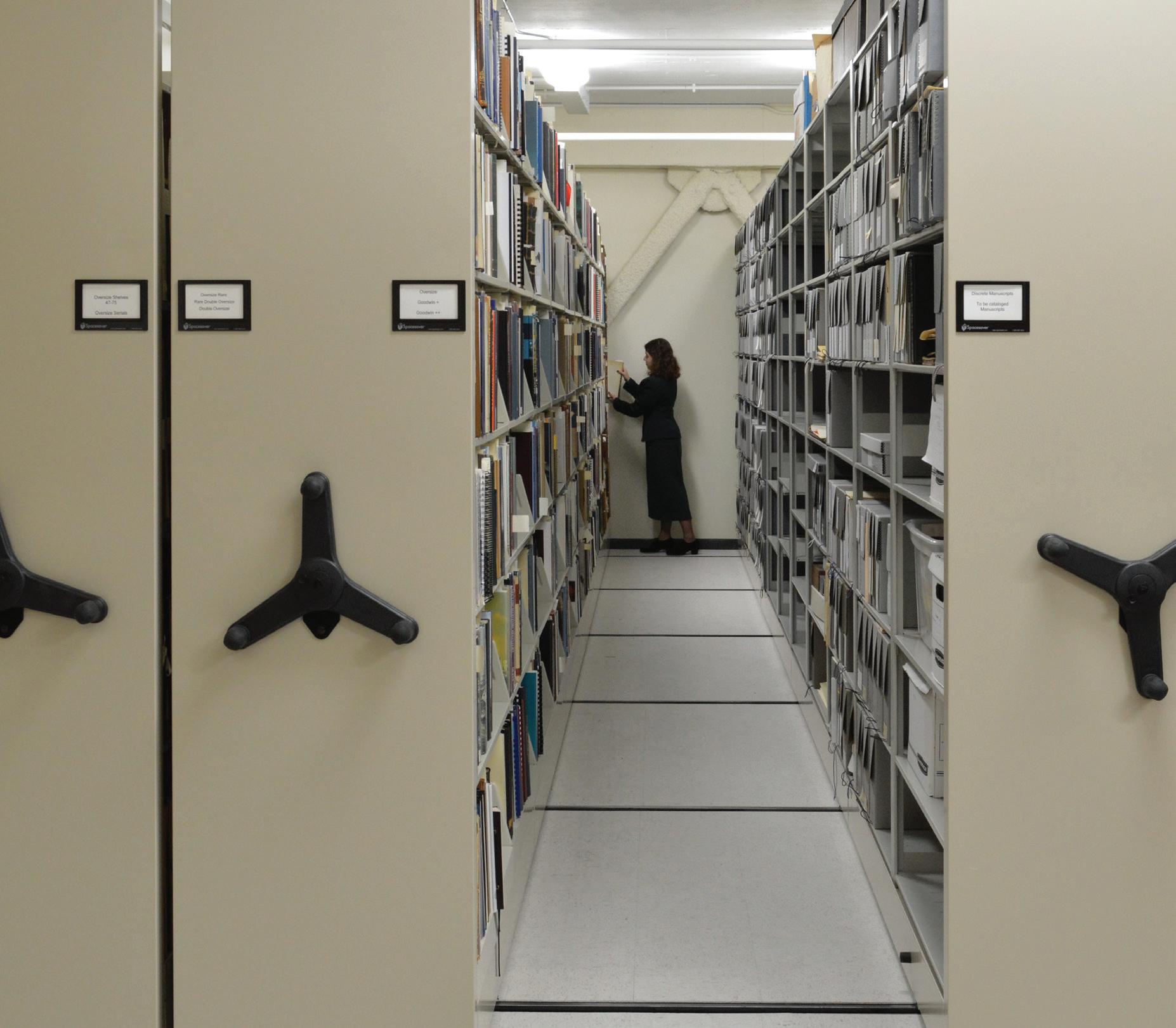
35 | Winter 2023
All About stuff
Fig. 1. Curatorial Assistant Emma Rocha selects a book from one of the newly installed compact storage units funded through the IMLS grant.
Acommon refrain in any discussion of increased investment in museum storage equipment and infrastructure is that such back-of-the-house projects are generally hard to fund. Poured concrete, windowless HVAC tempered spaces filled with locked doors, steel shelving, fire-proof filing cabinets, archival boxes, folders, envelopes, buffered tubes, linen tape, inert corrugated plastic, Mylar, and the other arcane accoutrements necessary to the long-term viability of collections can be a yawn. To folk like curators, collection managers, archivists, and registrars, however, such improvements are the staff of life for two simple reasons: preservation and access. Those two words are the Holy Grail. Fortunately, federally supported organizations like Institute of Museum and Library Services (IMLS), the National Endowment for the Humanities (NEH), state and community cultural councils, community foundations, and some private foundations offer competitive grant funds for worthy infrastructure projects. The question remains: to what end, exactly, are such storage improvement efforts aimed?
In August 2022, the Museum was awarded an $86,000.00 grant from IMLS through the Museums for America program for the design, purchase, and installation of compact shelving for the collection storage area dedicated to rare books, manuscripts, archives, reference books, special collections, and photography. The new layout would better utilize the existing space. The actual award reads as follows:
The New Bedford Whaling Museum will improve the care of its collections of regional history by increasing its existing storage space. Museum staff will work with contractors to move the collection and install new shelving. The museum will hire a curatorial assistant and a photography fellow to assist in cataloging, processing, and housing the collections. The project will also address a backlog of cataloging and processing work, and new shelving will allow for adequate space to create a dedicated area for processing materials. The project will protect and increase access to collections for the benefit of local residents, regional tourists, digital visitors, as well as students and scholars.
Compact shelving is a great invention. Unlike traditional stacks of shelving standing on either side of aisles, compact shelving units roll tightly together and can be rolled apart when something needs to be retrieved. This reduces the footprint of a storage facility dramatically. Such a practical consideration has obvious advantages especially when considering the needs of institutions with budget and space constraints, which, when it comes to museums and libraries, would include most, if not all, of them.
Preservation of and access to objects are counterpoints, held in tension within the museum and often contradictory. The preservation of objects, art works, manuscripts, rare books, and the like, collected under the umbrella of an institutional mission, seems straight-forward as an obvious and laudable goal. Medieval intelligentsia, the clergy, and royalty so valued material objects and books that they carefully guarded them. Books were made to last for centuries, and were expensive and rare items. Artisans stitched parchment or paper quires with twine, pressed stacks of stitched leaves tightly together, bound quires into boards of wood covered in animal hide and glued down and tooled the leather, sometimes studding the covers with gems and gold leaf. Once all that was done, owners chained them to bookshelves. These were not “circulating collections.” Preservation and access were built-in, literally. Access was limited to those with worthy credentials, and preservation was ensured by the chain. This method was largely effective as several medieval chained libraries remain today, collections intact. Other libraries would shelve books behind locked doors where only the curator or librarian could access them.
Public collections — including museums and libraries — aim to exhibit, store, and safeguard objects in perpetuity and make them available for researchers and publics. While there were libraries of a sort for over 2500 years, they were limited in scope and not commonly accessible to the general populace. The open stack public library, where patrons can freely browse, became a common civic institution in the mid-1600s in England, and the mid-1800s
36
most everywhere else.1 Public museums followed a similar trajectory and were formed by a collector or group, sometimes with a firmly articulated intent, and sometimes simply as a display space for natural and artificial “curiosities.”2 The notion of quality access to information and ideas as a public good, has persistently survived, and museums have embraced that central idea.
The intent to display is an important component of a museum. Today, museum collections in storage often far outnumber collections on exhibit; the average museum only exhibits about 10% of its collections in its galleries. Innovations like “visible storage” have emerged as a fundamentally practical solution to the problem of where to put stuff.
When the Old Dartmouth Historical Society was formed in 1903 its mission was to collect art, historical artifacts, natural history objects, photographs, books, and manuscripts, and to use those collections to document and exhibit the region’s history, or at least as much of it as those collections reflected. This was an enormous commitment, many people took it seriously, and in many ways, it was necessary, and not simply as the collective whim of a few elite parties.
During its colonial settlement in the 1700s, Southeastern Massachusetts developed as a maritime culture with shipbuilding, whaling, artisanal skills, and trade at its core. America’s whaling fleet, centered in this region, eventually helped to define the scope of American national hegemony in the Pacific and Western Arctic. It impacted ocean environments in ways perhaps still not entirely understood. It made investors an enormous amount of money which they subsequently invested in large-scale landbased manufacturing requiring profound shifts in population demographics to fulfill the needs of factory labor. Immigrants often did that work, and it’s a big and important story. Preserving that story
1 Many public and school libraries simply facilitate access to almost any type of reading material, periodicals, music, films, puzzles and games, internet databases, and other types of materials.
2 See, for example: Paula Findlen, “The Museum: Its Classical Etymology and Renaissance Genealogy,” Journal of the History of Collections 1, no. 1 (1989): 59–78.
is necessary, and making it accessible to the world has been the ongoing challenge of the institution for well over a century.
Initially, the institution was given a historic building by a single wealthy donor; the Museum would grow (with several gifts from generous individuals) over the next century to encompass an entire city block. Despite this, maintaining adequate space for storing and exhibiting collections is always a challenge.3 Being a dynamic organization with a large story to tell, collections have grown considerably. If the ODHS initial collections largely reflected the lives of colonial Western European settlers and affluent nineteenthcentury Americans, its maritime collections, intentionally or not, reflected a huge scope of world history. Diversity, equity, and inclusion are themes endemic to that history. In the case of this institution, collecting has been a beneficial imperative enabling important conversations, scholarship, and exhibitions on a host of topics that continue to grow and evolve with the perspective of time.
From its earliest inception, the ODHS published historical monographs and scholars have always utilized the collections. However, the documentation, care, and preservation of those collections has evolved over time. Working in a museum as a profession emerged in the mid-twentieth century. ODHS hired its first professionally trained curator in the 1970s, its first professional librarian in the early 1980s, and its first professional archivist shortly thereafter. With the assistance of Federal grants, as well as generous private donations, those individuals oversaw the construction of a new facility, dedicated to the preservation and storage of collections and a systematic description of the object collections. This work reflected larger national and international trends, as more and more communities built historical societies and museums, newly professional registration and cataloging methods evolved in the latter twentieth century, and more of the world’s collections became accessible. Access to museum and library collections, of course, is a prism. The colors that emerge may not be those
3 The history of philanthropy in the growth and maintenance of this Museum is a fascinating tale unto itself with great benefaction over the years toward new buildings and other infrastructure projects throughout its history.
37 | Winter 2023
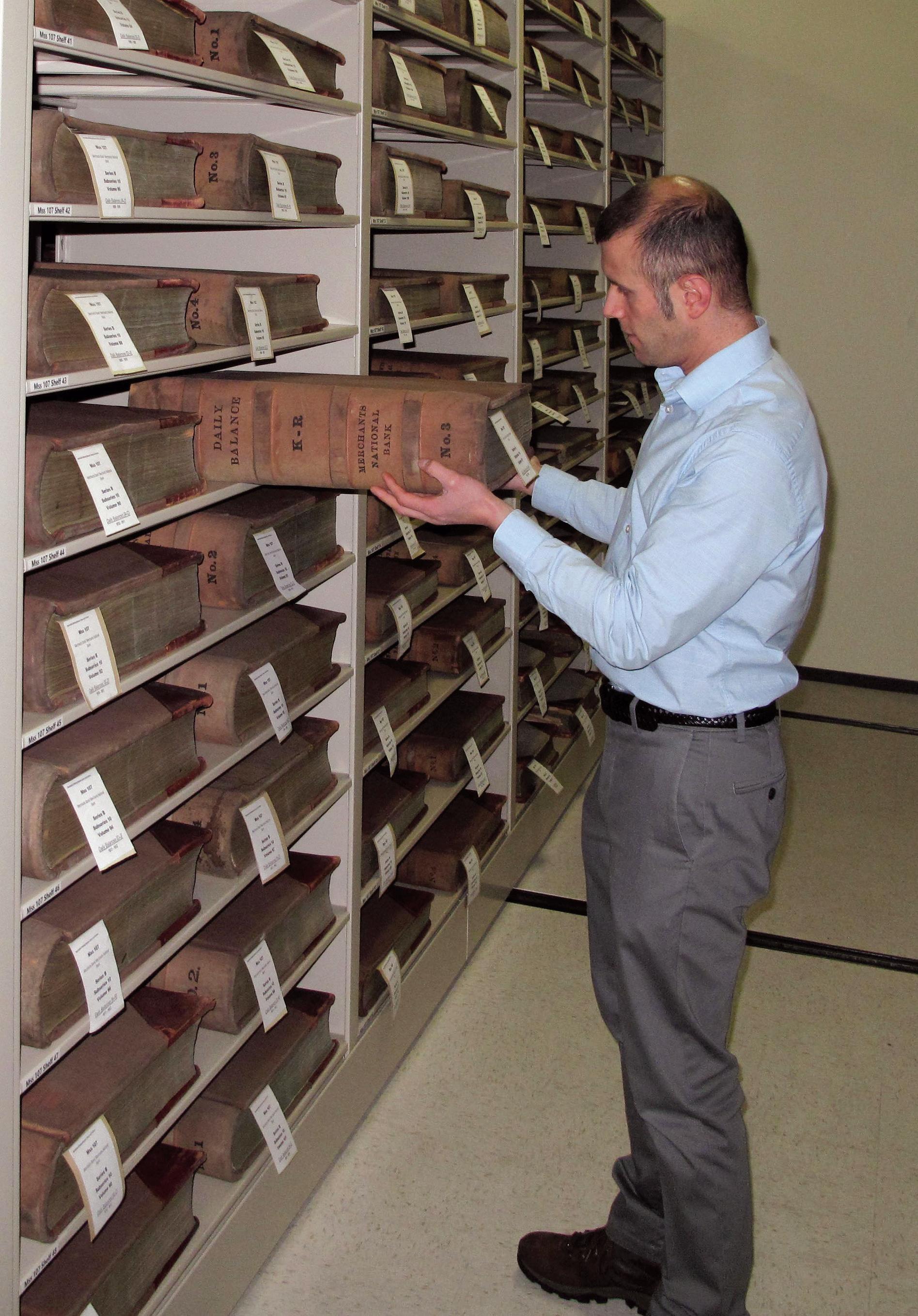
38
Fig. 2. Former librarian Mark Procknik shelves a massive “Daily Balances” accounting volume from the Merchants Bank/Merchants National Bank collection on the newly installed reinforced compact shelving.
that shine in; they only reflect collections that are properly housed, catalogued, and made publicly accessible.
The Museum has seven permanent collection storage spaces organized by medium, material, and size or scale. The recently completed IMLS-funded compact shelving project establishes a new benchmark for the ongoing function of the Museum’s collecting activities around rare books, manuscripts, and works on paper. In one secure storage space, the Museum houses approximately 28,000 printed books, 800,000 manuscript items, over 700 maps and charts, more than 2,500 original whaling logbooks and journals, and over 200,000 photographs, negatives, and postcards. Thanks to this recent substantial storage improvement project, the Museum added 900 linear feet of new compact shelving units, 600 linear feet of new and refurbished compact shelving units, 200 linear feet of refurbished compact shelving units, and gained approximately a 60% increase in open shelving. This expanded areas for processing, object examination, and cataloguing, and improves access and preservation to these collections.
All the collections in this area now have more shelving space, which, in the case of rare books, as one example, is physically beneficial to their wellbeing. Strengths in this area include incunabula, rare books and pamphlets, newspapers dating to the late 18th century, art reference, local history reference, government documents, children’s books, and special collections. Manuscripts span primary resources for local history, such as late 17th-century property deeds and indentures; mercantile investments and business records; church records; personal papers; firefighting history; and banking records, and the global history of whaling.
Indeed, important collections that have been positively impacted include MSS 107, the Merchants Bank/Merchants National Bank Collection, 18251939. These 1063 volumes, some of which weigh thirty pounds, constitute the single largest extant and intact collection of banking records in the world. Acquired in 2008 and processed with a grant from the National Endowment for the Humanities, the effective storage of this mammoth archive presented
a major challenge until now. The largest and heaviest volumes are stored on customized compact shelving and the long runs of yearly ledgers and other accounting volumes are stored on customized static shelving in linear chronology – an elegant and long-term solution.4 Another collection that has gained space is the Melville Society Cultural Project, a long-term partnership between the two institutions dedicated to the preservation and access of an important collection of Herman Melville first editions and scholarly books and periodicals. Finally, large portions of the photography collection that were temporarily shelved now have permanent shelving locations and are actively being catalogued, processed, and assessed for condition.
The organization of these significant collections, while not radically different from their previous storage configuration, has been greatly enhanced through this grant-funded project, creating improved efficiency for staff, which translates into better cataloguing, preservation, and public service. The reduction of the overall footprint of free-standing shelving has enabled other relevant collections to be safely stored in closer proximity, creating better physical and intellectual control overall.
As we move firmly into the twenty-first century digital age, books alone now number in the hundreds of millions, and bookshelves in some of the world’s largest libraries are measured in miles. Books, physical volumes, and collections of all kinds, take up a lot of space, and they weigh a lot, and generations, whole armies, of collections professionals have systematically developed and maintained rigorous standards by which these miles of materials can be cared for and made available in specialized preservation and access facilities.
Like the medium itself, professions have evolved. With digitization, e-books, and other electronic formats, the physical footprint of the Museum has changed, as has the ability of a broader swath of humanity to access materials in the absence of (or even, in spite of) a physical library or museum building. Likewise, 3-D photography, high resolution
4 These new shelving units were customized with reinforced steel to support the weight of these books.
39 | Winter 2023
imaging, and other technological innovations have radically changed the way that art and objects can be visualized and even displayed to large numbers of people via remote access. Despite the necessity of technological innovation, however, the physical object retains its irreplaceable value. Much can be learned from physical objects that may be missed with electronic surrogates. To be successful, we should strive for both.
In August 2022, the International Committee on Museums (ICOM) published a much-contested new definition of what a museum is and does:
A museum is a not-for-profit, permanent institution in the service of society that researches, collects, conserves, interprets and exhibits tangible and intangible heritage. Open to the public, accessible and inclusive, museums foster diversity and sustainability. They operate and communicate ethically, professionally and with the participation of communities, offering varied experiences for education, enjoyment, reflection and knowledge sharing.5
Last updated in 2007, this new definition points to the increasing emphasis for public-facing institutions on community engagement, knowledge sharing, and accessibility.
Preservation and access go hand-in-hand for a museum. Better space enables more careful storage and handling of collections. That, in turn, enables more efficient and better cataloging, digitization, and photography, which, in turn creates better access. Access is defined by the end-user: the researcher, enthusiast, scholar, donor, descendant, student, even the museum curators themselves. They can access significant quantities of materials and analyze, publish, exhibit, and discuss them, before putting them safely back where they belong for the next individual to use. If a staff member can easily provide a user with quality requested materials — either in an analog or digital format, while ensuring that there is room
5 Sarah Cascone, “After Years of Debate, Leading Experts Have Finally Decided What Defines an Ideal Museum. Did They Not Go Far Enough?” Artnet (August 25, 2022), https://news.artnet.com, accessed November 28, 2023.
for more such materials in the future, then funding organizations like the IMLS move well past merely enabling pedestrian infrastructure improvements. It, and funding agencies like it, become integral to a better understanding of the world around us.
The organization of these significant collections, while not radically different from their previous storage configuration, has been greatly enhanced through this grant-funded project, creating improved efficiency for staff, which translates into better cataloguing, preservation, and public service.
40
The Conservation of Charles Sidney Raleigh’s Panorama of a Whaling Voyage
Jordan Berson, Director of Collections
Named “pano-rama” – meaning all view – by public entertainer Robert Barker in the 1790s, panorama paintings were large, immersive paintings of landscapes, battles, or cityscapes. Moving and static panorama paintings were a form of popular entertainment in the United States starting in the 1840s. They traveled the country and were exhibited to public audiences for a small ticket fee. Often accompanied by dramatic music, stage dressing, and narration, panoramas engaged the imaginations of diverse audiences and offered an exciting experience in the days before cinema.
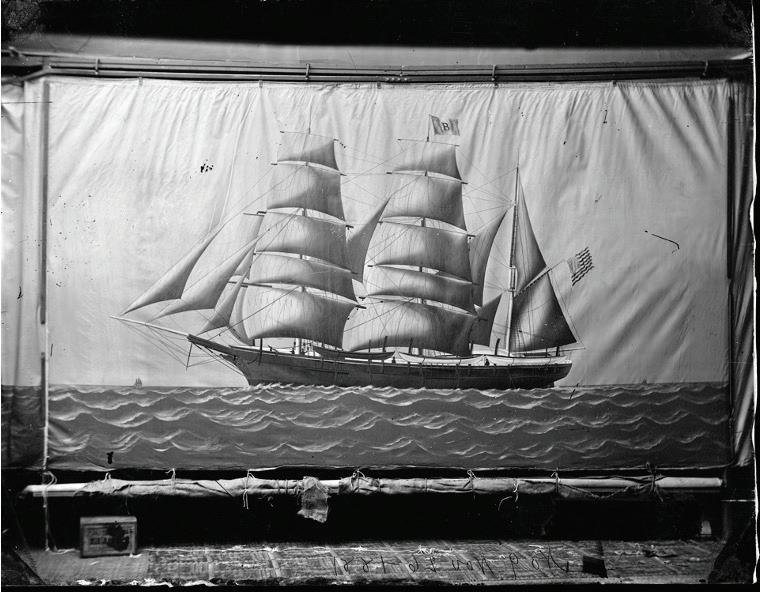
By the 1900s, panorama paintings were being supplanted by kinetoscopes and then moving pictures. They fell out of fashion, and existing panoramas were shoved into closets, left to deteriorate in barns and attics, or sliced up and sold as individual paintings. Today, there are eight known panorama paintings in public collections in the United States. The New Bedford Whaling Museum owns two: Benjamin Russell and Caleb Purrington’s 1,275-foot-long Whaling Voyage ‘Round the World, ca.1848, conserved and subsequently exhibited in 2018, and Charles
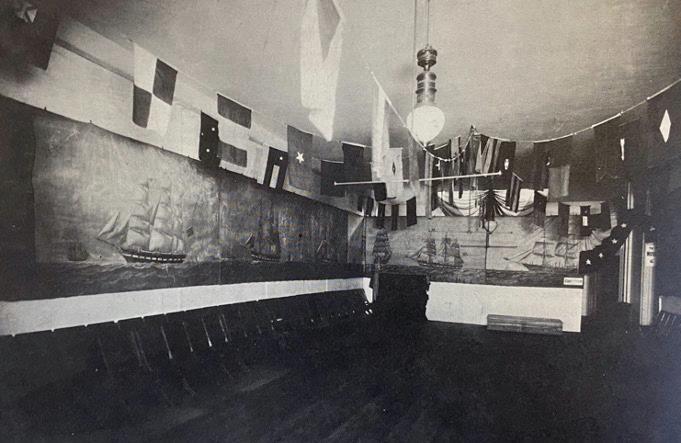
Sidney Raleigh’s 275-foot-long Panorama of a Whaling Voyage, painted between 1878-1880.
The NBWM holds eighteen extant sections of a twenty-two-scene panorama painted by Charles Sidney Raleigh (1830-1925) in the 1870s. This series of signed views illustrate an 1870-1874 voyage of the whaleship Niger out of New Bedford, documenting its travels along the way. The panorama was originally painted on a single expansive sheet of thin muslin cotton that was later cut down into individual scenes, each measuring about 6 1/2 by 11 1/2 feet. Seventeen of the original twenty-two scenes have been held at the museum since at least 1918. An eighteenth panel was purchased by the museum from a dealer in 1976. The whereabouts of the remaining four sections are unknown – perhaps removed from the larger work long ago, and subsequently sold or otherwise redistributed.
By 1957, the panorama was in a deteriorated state. Over the course of the 1960s, the museum undertook a major conservation initiative with Boston painting restorer Gustav D. Klimann and funded by Mrs. Alfred I. Dupont. According to Mr. Klimann’s treatment report surface dirt was carefully removed
41 | Winter 2023
Figure 1. Charles Sidney Raleigh’s Panorama of a Whaling Voyage, 1878-1880. Photograph of the panorama on exhibition, c. 1881.
Figure 2. Charles Sidney Raleigh’s Panorama of a Whaling Voyage, 1878-1880, at the New Bedford Masonic Building, 1904.
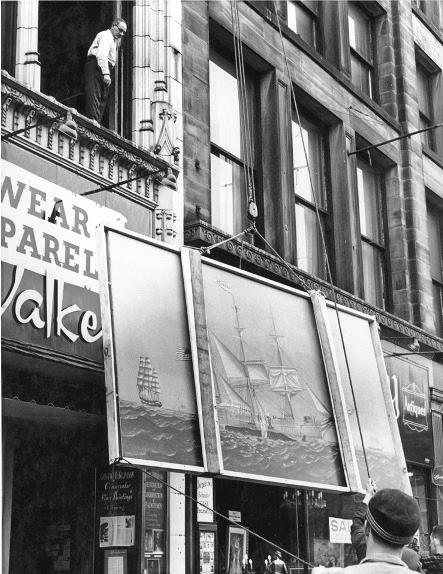
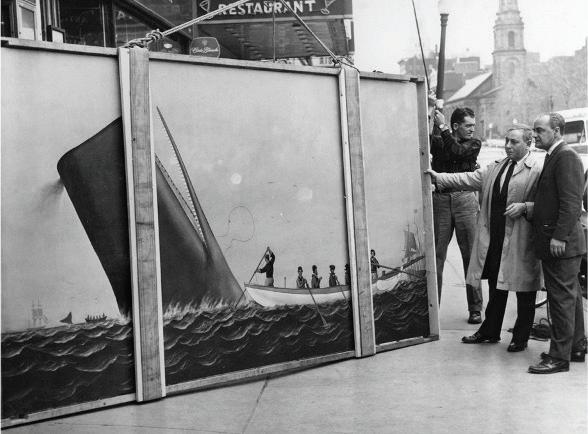
from the reverse sides of the panels and then each one was lined with wax-coated-cloth. The wax served as a moisture barrier as well as an adhesive. The panels were subsequently lined with sheets of airplane-grade aluminum to stabilize them, using a sandwiched interleaf of muslin impregnated with resin and hot wax for adhesion. Restorative inpainting was then done, followed by the application of a proprietary acrylic fixative over the paint layer, which was then coated in a mist of beeswax dissolved in Toluol for protection. The technique, which Klimann patented, was developed in response to concerns about how paintings were affected by non-climatized museum environments. While this approach effectively served to protect the panels, it also made them extremely heavy and unwieldy at over 250 pounds each. The paintings lost their luminosity, and the natural movement of the canvas was gone, replaced by a flat, rigid aesthetic.
Six decades on, the canvasses were again exhibiting signs of deterioration. The areas Klimann inpainted had darkened considerably and visually detracting
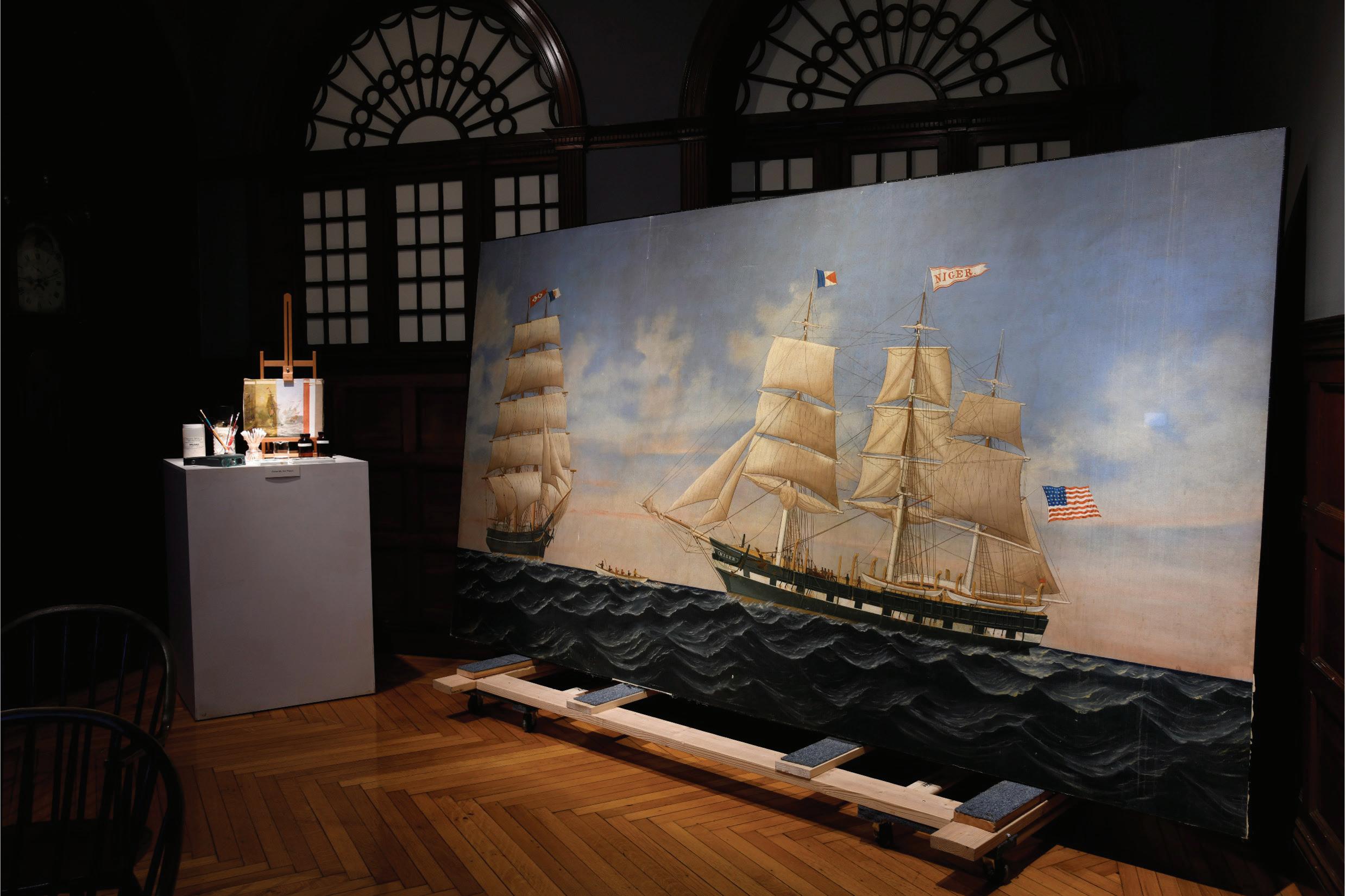
42
Figure 3 and 4. Sections of Charles Sidney Raleigh’s Panorama of a Whaling Voyage, 1878-1880, being delivered to Gustav Klimann’s Boston studio, c. 1960s.
Figure 5. Exhibition photograph of “UNVARNISHED: Conservation of Charles Sidney Raleigh’s Panorama of a Whaling Voyage, 18781880,” New Bedford Whaling Museum, December 12, 2021-March 6, 2022.
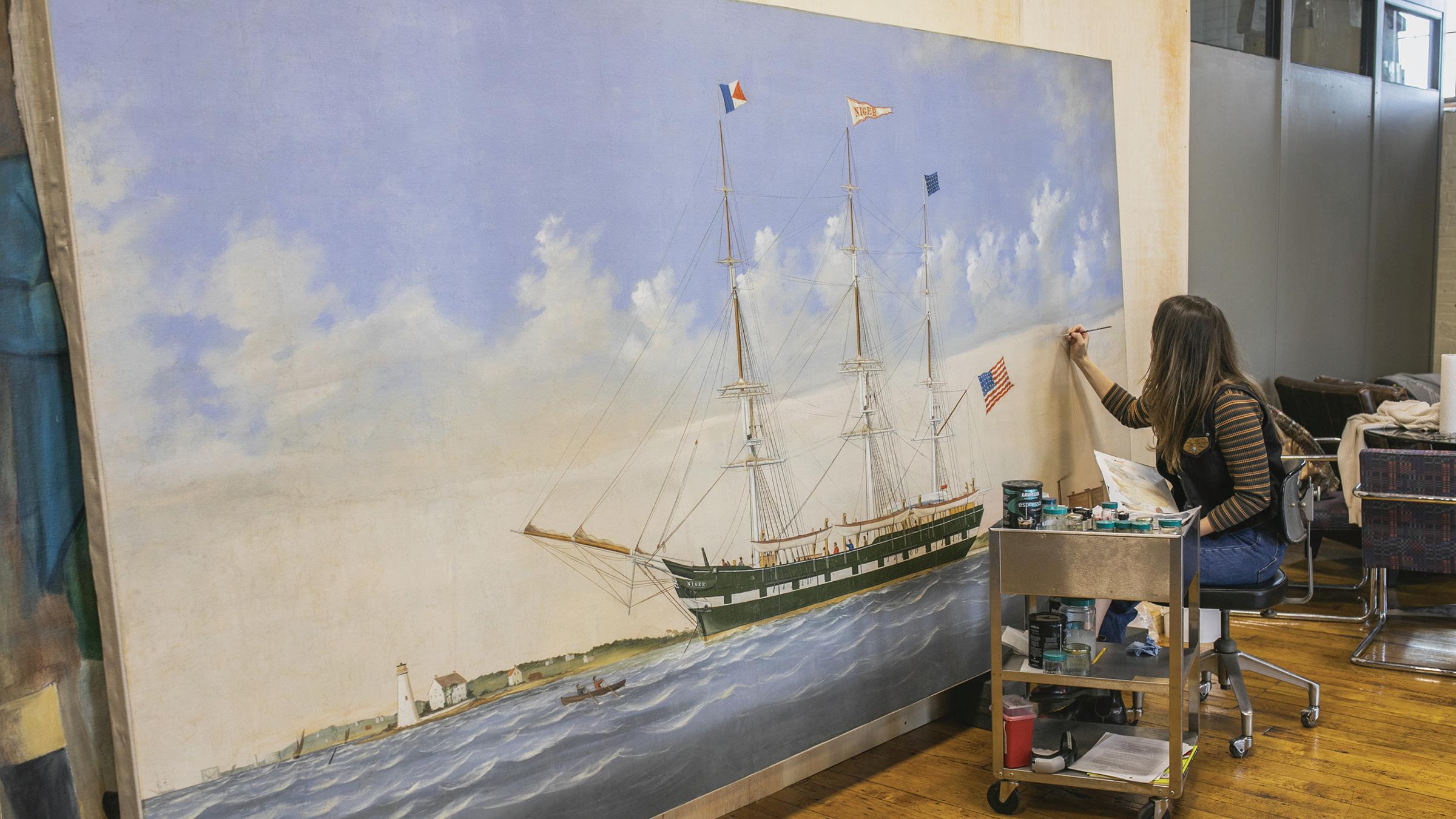
dirt and surface abrasions needed to be addressed. With their weight, the paintings were also challenging to store, move, and hang. In 2021, the museum staged the exhibition “UNVARNISHED: Conservation of Charles Sidney Raleigh’s Panorama of a Whaling Voyage, 1878-1880,” to draw attention to these paintings and stage a conversation about the challenges of safely stewarding large artifacts and works of art. The museum invited leading conservators to visit the exhibition and submit proposals on how to replace the heavy aluminum backing structure with more modern, lightweight materials.
In 2022, the Museum was awarded a competitive national grant from the “Save America’s Treasures” program, a National Park Service grant program in collaboration with the Institute of Museum and Library Services, the National Endowment for the Arts, and the National Endowment for the Humanities, to conserve the first panel, Sailing Day, off Palmer’s Island, New Bedford, Ship NIGER. The museum commissioned Boston-area Gianfranco Pocobene Studio to execute this ground-breaking conservation project. It turns out that many paintings from Boston-area collections received Klimann’s aluminum sheet interleaf backings between the
late 1950s and 1970s. Over the past five years, Pocobene studio had been practicing similar treatments successfully. However, the Raleigh project would be the largest aluminum panel reversal ever attempted. Their pilot approach to the treatment of this 250-pound painting had to be carefully planned out and executed.
Over the course of 2023, conservators at Gianfranco Pocobene Studio brought Sailing Day back to life. The conservation team began by cleaning the painting of old coatings and reported a significant improvement in luminosity. Testing was then done to determine how to remove the canvas safely and efficiently from the aluminum backing panel. The conservation team learned that this panel did not include the impregnated muslin interleaf, and that the wax bond was weak. This was a welcome discovery as it afforded the team an easier time than expected separating the canvas from the aluminum support. Next came the more time-consuming process of removing the wax-resin adhesive from the reverse of the canvas slowly by hand, a little bit at a time. The painting was then relined onto a linen canvas support and placed on a new wooden stretcher. Finally, a stable synthetic varnish (Acryloid B-72) was sprayed over the painting before final inpainting was performed.
43 | Winter 2023
Figure 6. Sailing Day, off Palmer’s Island, New Bedford, Ship NIGER (1878), being conserved at Gianfranco Pocobene Studios in 2023.
The entire process required over 380 hours of work to complete and establishes a precedent for large aluminum panel reversals.
The result of this major conservation project is a more vibrant, airy, and vivid work with bright coloration and an effect closer to the artist’s original
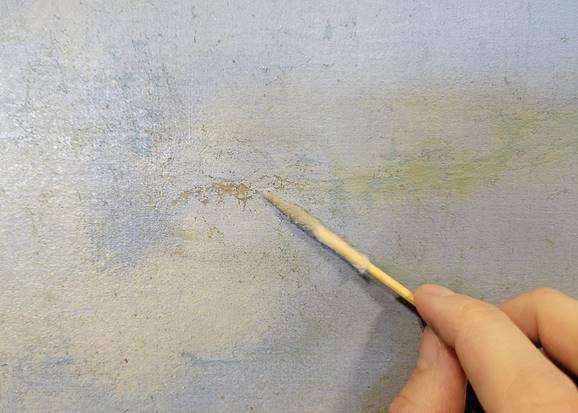
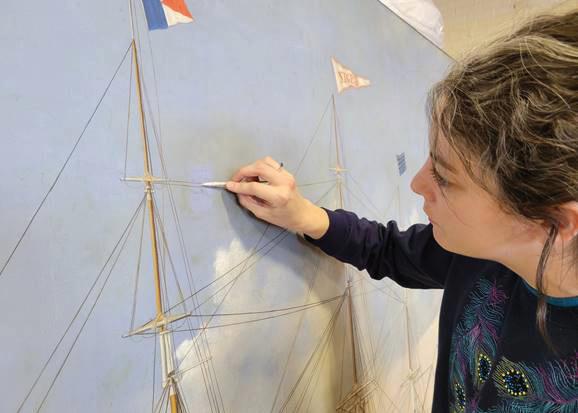

intent. The treatment also reduced the weight of the painting from several hundred pounds to a mere sixty, substantially improving the museum’s ability to store and handle the large painting. For the first time in many years the painting is now both beautiful to look at, and far easier to exhibit.
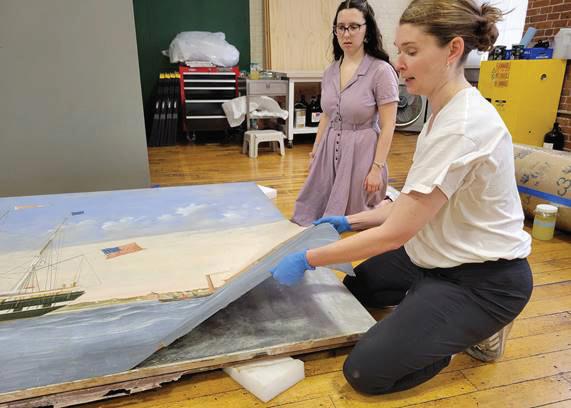
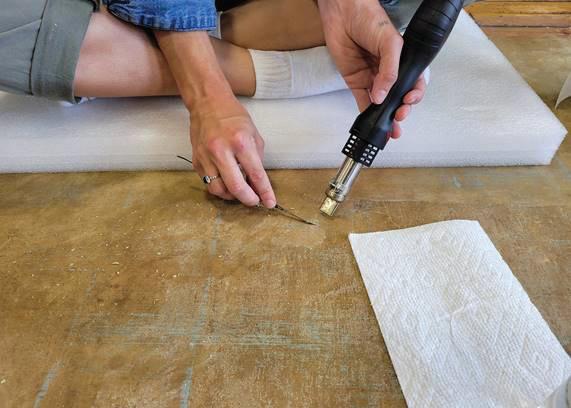
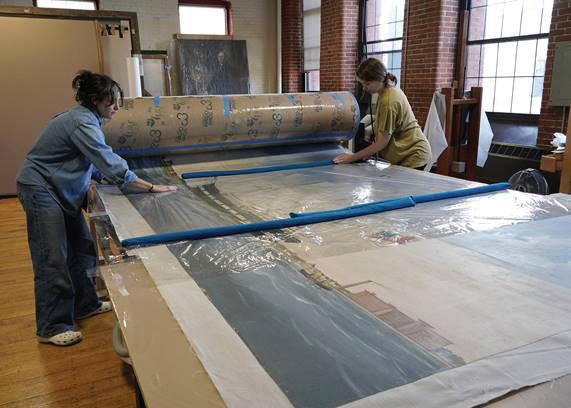
Often accompanied by dramatic music, stage dressing, and narration, panoramas engaged the imaginations of diverse audiences and offered an exciting experience in the days before cinema.
44
Figures 7-12. Sailing Day, off Palmer’s Island, New Bedford, Ship NIGER (1878), being conserved at Gianfranco Pocobene Studios in 2023.
The Complex Stories of Seals and Society
Andrea Bogomolni, Chair, Northwest Atlantic Seal Research Consortium Adjunct Faculty, University of Massachusetts Boston, School for the Environment, Boston MA
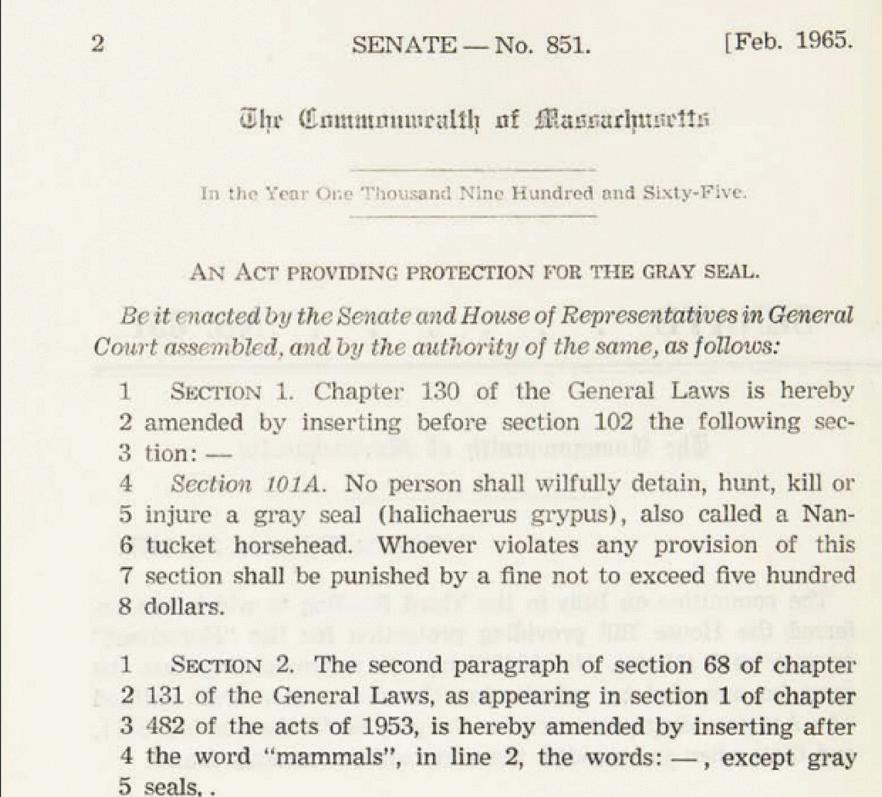
Living along the coastline of the northeast United States, and on Cape Cod in particular, it is easy to forget that we live on the edge of a wilderness, where you can step into a world of endless expanses of sand dunes and, on a crisp clear day, look out onto the ocean for miles as you walk along the seashore. Along the eastern seaboard, you can embark from one of the many bustling working waterfronts, with nothing but blue ahead of you. We live at the edge of an ocean that surrounds us, that feeds us, and that inspires us.
As beautiful as this wilderness is, this wilderness isn’t without controversy. Human activity is also a part of this ocean wilderness and creates challenges with marine wildlife including marine mammals. Humans utilize marine resources, use coastline habitat for
recreation and energy needs, as well as build homes on shores now impacted by climate change. Conflicts and controversy with marine mammals occur at the ocean’s edge and are not new to us.
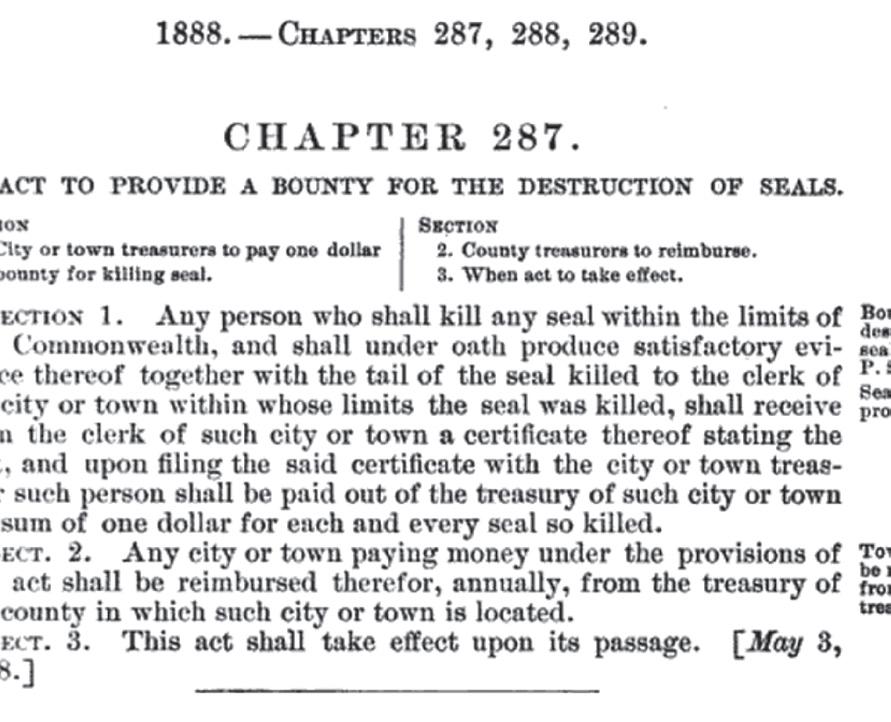
Seals are part of this complex relationship and have been living with humans for thousands of years.1 Yet, during an era of exploitation of marine resources in the 1800s, harbor seals (Phoca vitulina vitulina) and gray seals (Halichoerus grypus atlantica) nearly disappeared from our waters. As the great whales were hunted and fisheries were declining due to overharvest, seals were also impacted by these exploits.
1 Bonnie Newsom; Robert C. Ingraham, Donald Soctomah, Emily Blackwood, and Jason Brough, “Indigenous Archaeologies, Shell Heaps, and Climate Change: A Case Study from Passamaquoddy Homeland,” Advances in Archaeological Practice 11, no. 3 (2023): 302-313; Robert C. Ingraham, Brian S. Robinson, Kristin D. Sobolik, and A. Sky Heller, “‘Left for the tide to take back’: specialized processing of seals on Machias Bay, Maine,” The Journal of Island and Coastal Archaeology 11, no. 1 (2016): 89-106.
45 | Winter 2023
Animal Issues
Figure 1. “An Act Providing Protection For The Gray Seal,” Massachusetts State Library, 1965 Chap. 0129. http://hdl.handle. net/2452/3109
Figure 2. “An Act To Provide A Bounty For The Destruction Of Seals,” State Library of Massachusetts, 1888 Chap. 0287. http:// hdl.handle.net/2452/83944
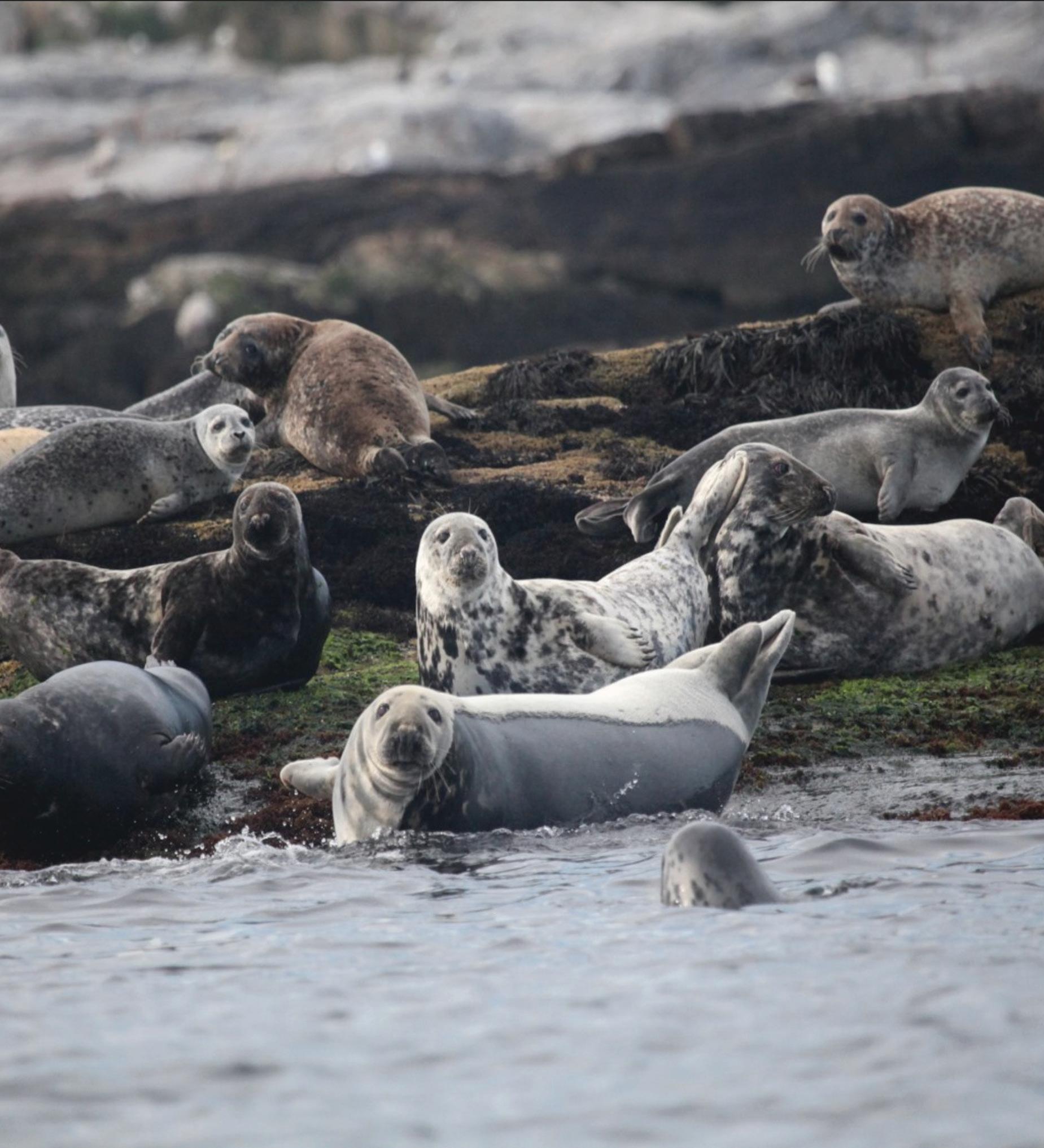
Between 1880 and 1962, gray and harbor seals were targeted in legal seal bounty hunts across Maine and Massachusetts due to a perceived competition with commercial fisheries. State-sanctioned bounty hunting (fig. 1) led to the local extinction of seals from our coastal waters by the 1950s. Towns would pay $1 to $5 per seal nose and records kept by towns were used to estimate that between 72,000 and 135,000 gray and harbor seals were killed during
this period.2 Gray seals were extirpated from U.S. waters and only a few hundred harbor seals remained.
A call for legal protection, including state protection in Massachusetts in 1965 (fig. 2), and Federal protection in 1972 through the Marine Mammal
2 Barbara Lelli; Stephanie A. Wood, David E. Harris, and AbouElMakarim Aboueissa, “Seal bounties in Maine and Massachusetts, 1888 to 1962,” Northeastern Naturalist 16, no. 2 (2009): 239-254.
46
Figure 3. Harbor seals and gray seals resting at the Isle of Shoals, Maine. (NOAA LOC 25751)
Photo A. Bogomolni
Protection Act (MMPA), allowed seals to recolonize historical pupping grounds along the New England coastline.3 The MMPA not only provided protection for marine mammals, it was the first U.S. law to use ecosystem based management as the guiding principle for protection.4 It has taken 50 years of dedicated conservation efforts to see a recovery. The return of seals (fig. 3) and other marine mammals has had ripple effects through entire ecosystems including allowing for a critical top predator, the Atlantic White Shark, to return to our region.5
Despite this conservation success story, conflict has re-emerged, as seen in the numerous media articles reflecting a temperament beckoning to the past century, with the spread of misinformation and calls to cull the population. Although, seals are endemic to the region, for three generations seals were rarely present. Their return to New England after decades of near-absence has created a new ecological and psychological baseline for New Englanders.
While encouraging, this new reality, this rewildling also means very few in living memory have actually seen what a healthy, productive Northwest Atlantic looks like. Now, with seal populations rebounding, we are again discovering what it means to share the coastline with other large animals that also call this place home. Many people come to visit our shores specifically because they hope to see seals

3 Stephanie A. Wood, Kimberly T. Murray, Elizabeth Josephson, and James Gilbert, “Rates of increase in gray seal (Halichoerus grypus atlantica) pupping at recolonized sites in the United States, 1988–2019,” Journal of Mammalogy 101, no. 1 (2020): 121-128.
4 MMPA. 16 U.S.C. §§ 1361 et seq. H.R. 10420.
5 Gregory B. Skomal, John Chisholm, and Steven J. Correia, “Implications of increasing pinniped populations on the diet and abundance of white sharks off the coast of Massachusetts,” Global Perspectives on the Biology and Life History of the White Shark’ .(Ed. ML Domeier.) pp (2012): 405-417.
in the wild.6 While fear and frustration has grown, thousands of visitors make their way to places like the Cape Cod National Seashore to experience natural beauty, including seals.
Different ways of knowing and understanding how we value our natural world are needed to understand this complex relationship in the past and present and to consider how we are to live in a world with rebounding marine mammal species. This includes cultivating an awareness of Indigenous values, trusting experimental scientific principles and explorations in natural history, and trusting all branches of the humanities. Indigenous values, including the belief that non-human beings and the land are important members of the community, give us a view on past and present relationships.
Social science and human dimensions of wildlife conflict research, specifically, is a tool to obtain the empirical data needed to understand perceptions, as well as help educate and address misperception and misinformation. From genomic diversity to diet analysis to how seals promote ecosystem stability, experimental science gives us a means to find answers to hypothesis driven research. Natural history accounts from fishermen and
6 Rachel Bratton, Jennifer L. Jackman, Stephanie A. Wood, Seana Dowling-Guyer, Jerry J. Vaske, Andrea Bogomolni, Megan V. Winton, Melissa A. Sanderson, Owen C. Nichols, and Lisa Sette, “Conflict with rebounding populations of marine predators: Management preferences of three stakeholder groups on Cape Cod, Massachusetts,” Ocean and Coastal Management 244 (2023): 106800; J. Jackman, R. Bratton, L. Sette, S. Wood, A. Bogomolni, M. Sanderson, O. Nichols, M. Winton, M. Long, S. DowlingGuyer, S. Sykes, C. Wigren, A. Rutberg, D. Baseman, C Cummings, V. Bramante, & V. Kako, “Human Dimensions of Rebounding Populations of Seals and Sharks on Cape Cod,” (2022), https:// seagrant.whoi.edu/sealshark/
47 | Winter 2023
Figure 4. Billy Komoneseok, Walrus Tusk Cribbage Board with Scene of Seals, 1911. Walrus ivory. Gift of Mrs. Edgar R. Lewis. NBWM 1935.68.31.
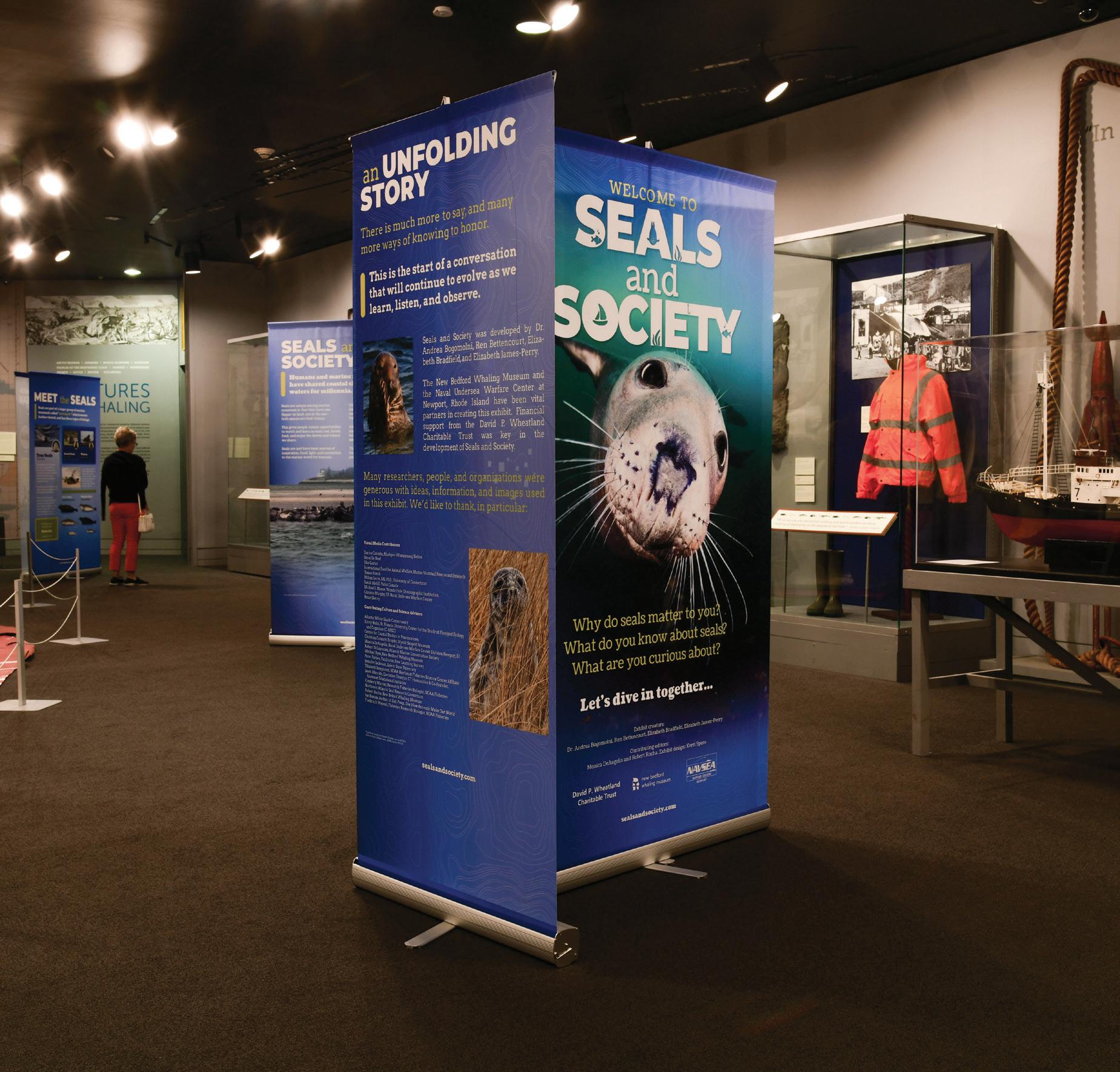
whalers about where seals were present at sea are equally valuable data points today.
All ways of knowing are needed for seals and society to coexist and to understand the many values that people hold. The New Bedford Whaling Museum plays a critical role in relaying more than natural history of species. It is the stories of people and place, past and present, that will help shape future understanding of the role seals have in our world.
The traveling exhibition, Seals & Society, was created by Dr. Andrea Bogomolni, Ren Bettencourt, Elizabeth Bradfield and Elizabeth James-Perry, with Robert
Rocha, NBWM Associate Curator of Science and Research, and Monica DeAngelis, Marine Mammal Biologist at NUWC. The multi-panel exhibition dives into the daily lives of these specially adapted animals, with a focus on harbor and gray seals, and is currently traveling to coastal education and marine science centers throughout New England. To learn more, visit: www.whalingmuseum.org/exhibition/ seals-and-society/
48
Figure 5. Installation view of premiere of Seals & Society traveling exhibition at New Bedford Whaling Museum, March 2023.
The Stars That Guide Us:
Roy Rossow’s Inspiration
By Emily Reinl, Common Ground Project Coordinator New Bedford Whaling Museum
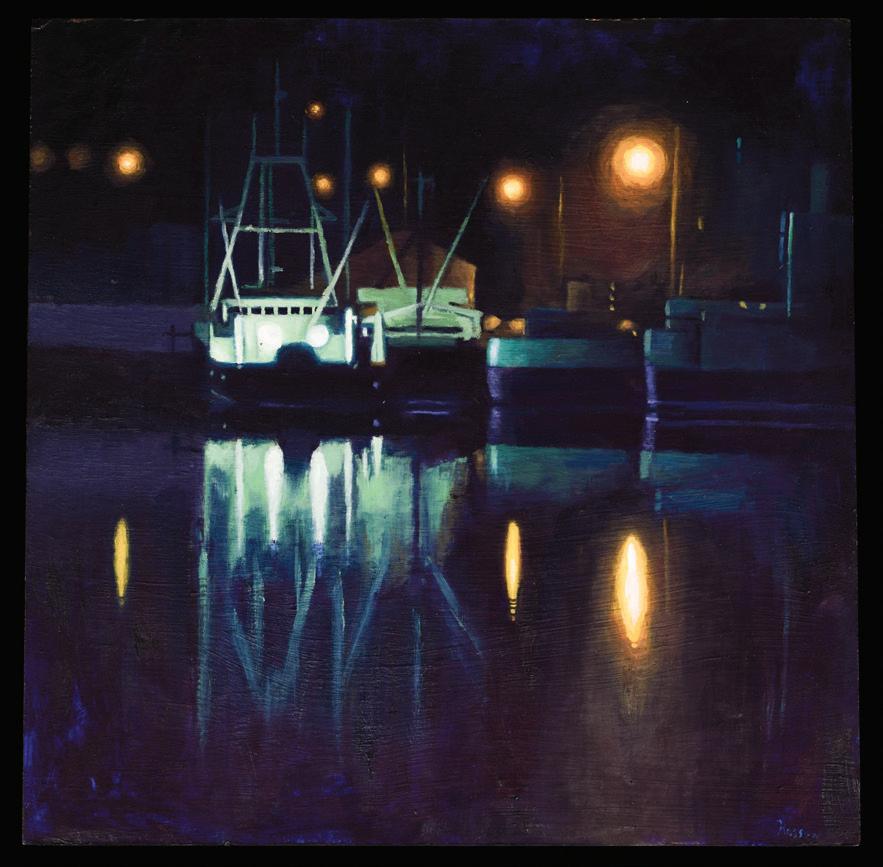
From 2018 through 2023, the New Bedford Whaling Museum collected stories of local residents through the oral history project Common Ground: Community Stories. One of our Common Ground storytellers, painter Roy Rossow, currently has an exhibition of his work on display at the New Bedford Whaling Museum. In his story, recorded through our partnership with the SouthCoast Artist Index and excerpted below, he discusses how a life-long love of nature and astronomy, as well as an appreciation for the New Bedford waterfront, inspires his work:
I just love the night and I love the quietness and just the serene quality of just being by the water…
and being connected with nature…I grew up in Ellington, [Connecticut], so I was surrounded by nature. My mom was a huge influence on me because she was big into nature and kind of taught me a lot about how important our environment is…We spent a lot of time camping too. So that kind of plays into it too…
And I think the other part too is the light. I’m really fascinated by natural light and manmade light. And so, in my studio location…I’ve spent a lot of time up at night, just looking. Just watching the changes of the light, especially in the morning-time when the sun is coming up. I’m just so fascinated by…that moment…when the sun comes up over the horizon, when it goes from these dark blues to light oranges to red… I love having a dark canvas. I usually start out with a dark canvas with my mixing of ultramarine blue and alizarin crimson to create a nice ‘black,’ but it’s not just black where there’s nothing there. There are hints of some reds and blues that you can still see in there. And I love bringing the light out of that…
So when you look at my paintings, like one of the recent ones I did of a boat, a fishing boat, that’s departing, it’s really dark scenery. I just love the intricacy of, if you look at it really closely, you can just see little bits of light and it becomes almost abstract…
The other thing to add into that too is when you look at some of the paintings I’ve done, you’ll see a lot of little light globes all around. And the other thing that I was really into growing up is space
49 | Winter 2023
Exhibit Highlights
Figure 1. “Emerging from the serene night, the waterfront is transformed by glowing orbs of light to a mysterious landscape of shapes.” Roy Rossow (b. 1975), Nocturne Verde, 2015. Oil on panel, 12 x 12 inches (30.48 x 30.48 cm), NBWM 2022.4.1.

and the universe and constellations. We used to go outside and look at a lot of stars and the moon and stuff and so I was big into NASA Space Shuttle exploration. I used to make a lot of models of that. So these paintings that I do kind of mimic constellations. So I have a vision of where my work is gonna evolve, what I want it to evolve to, but you know things always change, you can’t really control it, but I want to go from a realism of boats and the scenery that’s around me, almost elevating up to stars and constellations and stuff. I have a huge appreciation for abstract art. I see it as the epitome of art. I haven’t gotten there yet, but I’m hoping that my work will evolve to something like that…
I love the water. When I first moved [to New Bedford], I went out in my chair, just getting to know the area and I just loved that waterfront.
It’s just so alive and just so fascinating and [there’s] just so much to see. It’s just like a feast for the eyes. I remember when I was driving through with my sister Susan one time, she was just fascinated by all the…masts and all the wires and all these angles that you could see from a distance, but you couldn’t really see the boats…I used to go down there in the morning, midday, I would even go down there like at two in the morning just to see what’s going on…I just love this area so much and…hope I can stay here for a long time.”
Roy Rossow’s show, The Stars That Guide Us, will be on display through April 21, 2024 at the New Bedford Whaling Museum. You can discover more Common Ground oral histories, including ones collected through the SouthCoast Artist Index, by visiting https://www.commonground.whalingmuseum.org
50
Figure 2. “The lights and colors reflecting on the night water are even more captivating in motion.” Roy Rossow (b. 1975), Night Departure, 2015. Oil on panel, 9 x 8 inches (22.86 x 20.32 cm), NBWM 2022.4.1.
"Harboring Hope": the Importance of Multiple Perspectives
By Karissa Walker, Education Programs Registrar at the Roger Williams Park Zoo, and former Special Events Coordinator at the New Bedford Whaling Museum
“The very ink with which all history is written is merely fluid prejudice.”
— Mark Twain, Following the Equator (1897).
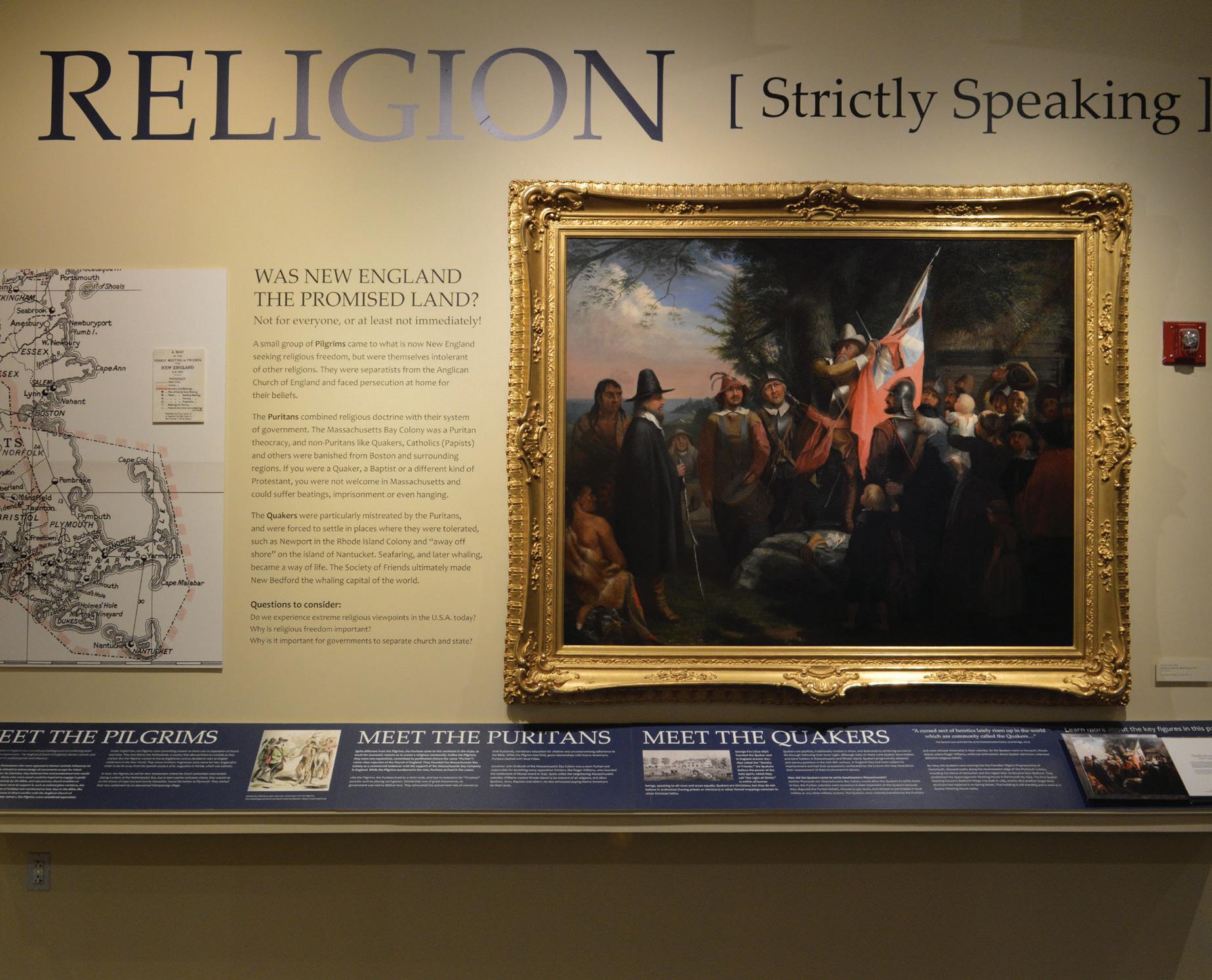
51 | Winter 2023
Figure. 1. Section of Harboring Hope highlighting the religions of the settlers.
Who writes history and does history change with different points of view?” Visitors encounter this quote as they explore the Harboring Hope exhibition in the New Bedford Whaling Museum. The exhibit focuses on the Old Dartmouth region of southeastern Massachusetts, from its earliest settlement by Europeans until the early nineteenth century. At its start visitors are introduced to the figure of Bartholomew Gosnold (1571-1607). He was an English explorer who made several voyages to the New World. In addition to his explorations of the coastal northeast, he was also an instrumental figure in the founding of the colonial Jamestown settlement. Being an explorer of the shores of the “New World,” he published a narrative of his experiences that was broadly read.1 Gosnold was just one of the many settlers who encountered Indigenous tribes upon landing. It is at this point in the exhibit that visitors are introduced to the Wampanoag Tribe. The exhibit addresses the government organization of the tribe, the language spoken, and the surrounding tribes. Projected maps define the tribal boundaries, traveled pathways, and language patterns. In a case of artifacts, there is a map and text panel that details the pivotal events of King Philip’s War (1675-1676), and how it affected the region. At this point the question posed above, “who writes history and does history change with different points of view,” comes under scrutiny.
The question asks the visitors to think critically and look at the exhibit in a new light. It forced me to take the information I just read and think about it differently. Exploring the exhibit with this idea in mind, I made some observations. On my second walkthrough, I found that this portion of the exhibit is told to the visitors through the colonizer’s perspective. We, the audience, are introduced to the Wampanoag Tribe through Gosnold and his accounts. After the “questions to consider” portion of
1 John Brereton, A briefe and true relation of the discouerie of the north part of Virginia being a most pleasant, fruitfull and commodious soile: made this present yeere 1602, by Captaine Bartholomew Gosnold, Captaine Bartholowmew [sic] Gilbert, and diuers other gentlemen their associats, by the permission of the honourable knight, Sir Walter Ralegh, &c. Written by M. John Brereton one of the voyage; Whereunto is annexed a treatise, of M. Edward Hayes, containing important inducements for the planting in those parts, and finding a passage that way to the South sea, and China (Londini: [Printed at Eliot’s Court Press] impensis Geor. Bishop, 1602).
the exhibit, visitors are led back to the life of Gosnold and other settlers. In a section entitled “Meet the Pilgrims, Puritans, and Quakers,” the lives of these groups are documented in detail. In an interactive part of the exhibit, there is a book that allows people to learn more about key figures in a large oil painting by New Bedford Quaker painter William Allen Wall (1801-1885) titled “Endicott and the Red Cross.” The painting is an interpretation of the Nathaniel Hawthorne short story by the same name that appeared in his collection of short stories, Twice-Told Tales (Boston, 1837). The painting shows historical figures like Massachusetts governor John Endicott (c. before 1600-1665) and Rhode Island colony founder Roger Williams (c. 1603-1683), along with a supportive crowd of onlookers and a couple of Native American men. The painting depicts Puritan zealot John Endicott cutting the cross out of the English flag in vehement protest to his perception of the influence of the papacy in the court of Charles I and its subsequent influence upon the Separatist colony in Massachusetts.2 This painting (and its interpretive booklet) demonstrates the relationship between Native Americans of the region and settlers, as well as the relationship between the settlers themselves. Looking at the painting, Endicott and his followers are the primary focus. The Native Americans in the painting are off to the side behind the figure of Roger Williams.
In the interpretive booklet, there is a page discussing why the painter included the Native Americans. The tribes of the region were a diverse group of people that included the Pequot, the Mohegan, the Nauset, the Wampanoag, the Narragansett, and others, but their limited presence in the painting suggests a token representation of their actual presence and importance in the region. As Hawthorne described it: “Their flint-headed arrows were but childish weapons compared with the matchlocks of the Puritans, and would have rattled harmlessly against the steel caps and hammered iron breastplates which
2 This actual event took place in Salem in 1634. While many settlers agreed with him that Catholic or near-Catholic influences upon the colony were unwelcome, it was considered an act of rebellion by Endicott which could potentially result in the revocation of the Massachusetts Bay Colony Royal charter. For these reason Endicott was rebuked by then-colonial governor John Winthrop, and forbidden to hold office for one year.
52
inclosed [sic] each soldier in an individual fortress.”3 These accounts are from the settler’s perspective with very little mention of the Indigenous peoples’ feelings or perspective, suggesting they were mere spectators. Until 2023, within this exhibition, the tribe’s perspective was not highlighted as much as the settlers. The only history that was shown was of the colonial period, effectively defining many Indigenous tribes by their past.
In 2023, a new portion of the exhibition was added. The opening text panel is entitled “Naming and Native Territory Today.” This new addition allows much more of the Indigenous perspective to shine through and reveals their present-day lives. It demonstrates that in New England Indigenous people represent living, vibrant cultures, and are not merely historical relics. There is one piece of artwork that caught my eye during my visit. “Whale Peace Offering” is a painting created by Mashpee Wampanoag artist Nelson Andrews. The painting depicts a whale lurking within the depths of the water under a boat carrying an Indigenous person. The unique aspect about this piece is that the artist didn’t use regular canvas. Instead, Andrews painted on an 1877 map of Mashpee, Massachusetts. This painting is just one of the many new additions that highlight a different point of view concerning Indigenous history. It is a different viewpoint than the one seen within the other artifacts in the first portion of the exhibit described above. The two narratives complement each other. It is important for visitors to see that the same history can be told in different frameworks. This expansion of knowledge allows visitors to draw their own conclusions about history while keeping in mind how different groups felt and still feel. History is not stagnant.
The new additions combined with this notion of evolving historical perspectives has made me think about the role museums have in showcasing history. The question remains: “who writes history?” This question does not simply apply to books and school lessons, but to the interpretive choices of museums and other cultural institutions as well. The visitors should be asking who created this exhibit and why 3 Nathaniel Hawthorne, Twice-Told Tales (New York: The Modern Library, 2001), 341.
did they include some history or viewpoints and not others? The bias of curators is an aspect that every museum faces. They display artifacts in a narrative that they deem valuable. Harboring Hope was originally about the Old Dartmouth Region and the colonial settlement there. While the local Indigenous people were included within the exhibit, that was not its main focus. This narrative has now shifted with this newest addition to learning about the Native Americans that lived and still live on this land and their perception of their community. That said, the exhibit lacks historical interpretation done by Indigenous people. It is commendable that the Museum is not shying away from this sort of critical thinking but rather embracing it. The Museum prompts visitors and employees to look at the exhibitions and question what they are exploring. An exhibit, or museum in general, should be looked at from different viewpoints and be criticized and praised for its work.
The Whaling Museum, like many others, showcases history through their exhibitions but sometimes an exhibit is not enough. Public programs can add context to the subjects showcased within their walls. For instance, in March of 2023, David Weeden held a presentation and discussion at the Whaling Museum called “Wampanoag Lifeways.” Weeden has been a part of the Tribal Historic Preservation Department for the Mashpee Wampanoag Tribe for eight years, a Tribal Councilman, Chair of the select board for Mashpee, and a Native American representative to the Assembly of Delegates, Cape Cod Commission. His talk provided a comprehensive perspective on Wampanoag life throughout different time periods. Instead of strictly interpreting Wampanoag past history, Weeden took a broader approach. His discussion highlighted many key pieces of history that can be seen within Harboring Hope, such as the previous form of Native government and the day-today life in the colonial period. He also highlighted the vital efforts at keeping the Wampanoag language alive and advocating for legislation to benefit the tribes today. As I said earlier, Weeden’s program adds context to the themes of the exhibit. History is a discipline that evolves depending upon the perspective of the narrator. If you would like to watch the full discussion, visit the New Bedford
53 | Winter 2023
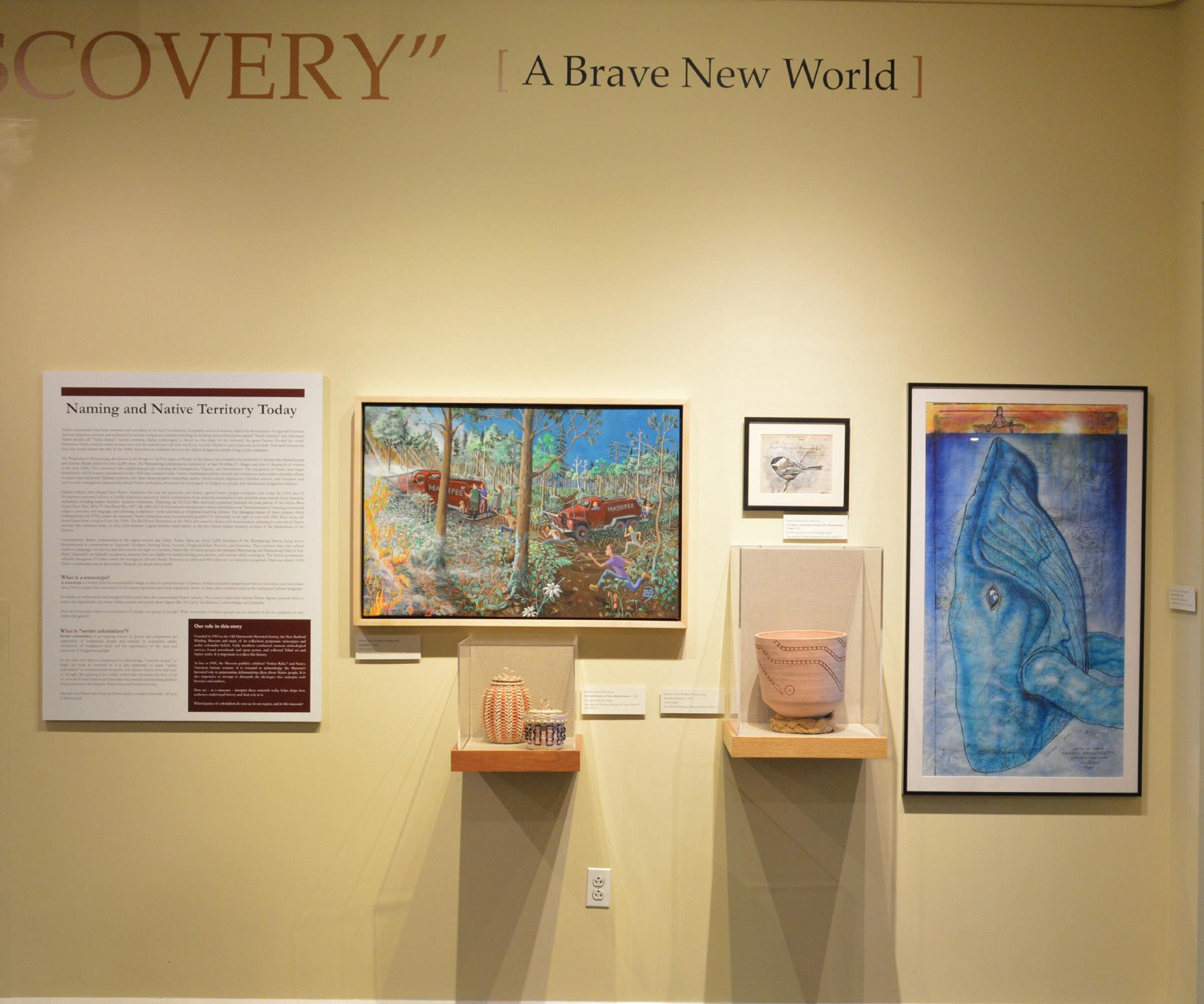
Whaling Museum’s YouTube page to find past public programs.
Once again: “Who writes history and does history change with different points of view?” Harboring Hope is a perfect example of how historical perspectives shift depending on who is recounting
them. There were only a few years between the initial opening of Harboring Hope and the new additions, but there remains much to compare. Audiences are encouraged to think critically about the information they are absorbing and how to be mindful of the narrator. Presenting varying points of view gives a wider understanding of a subject.
54
Figure 2. Newly installed section of Harboring Hope highlighting the lives and culture of Native Americans in the region.
Looking Back
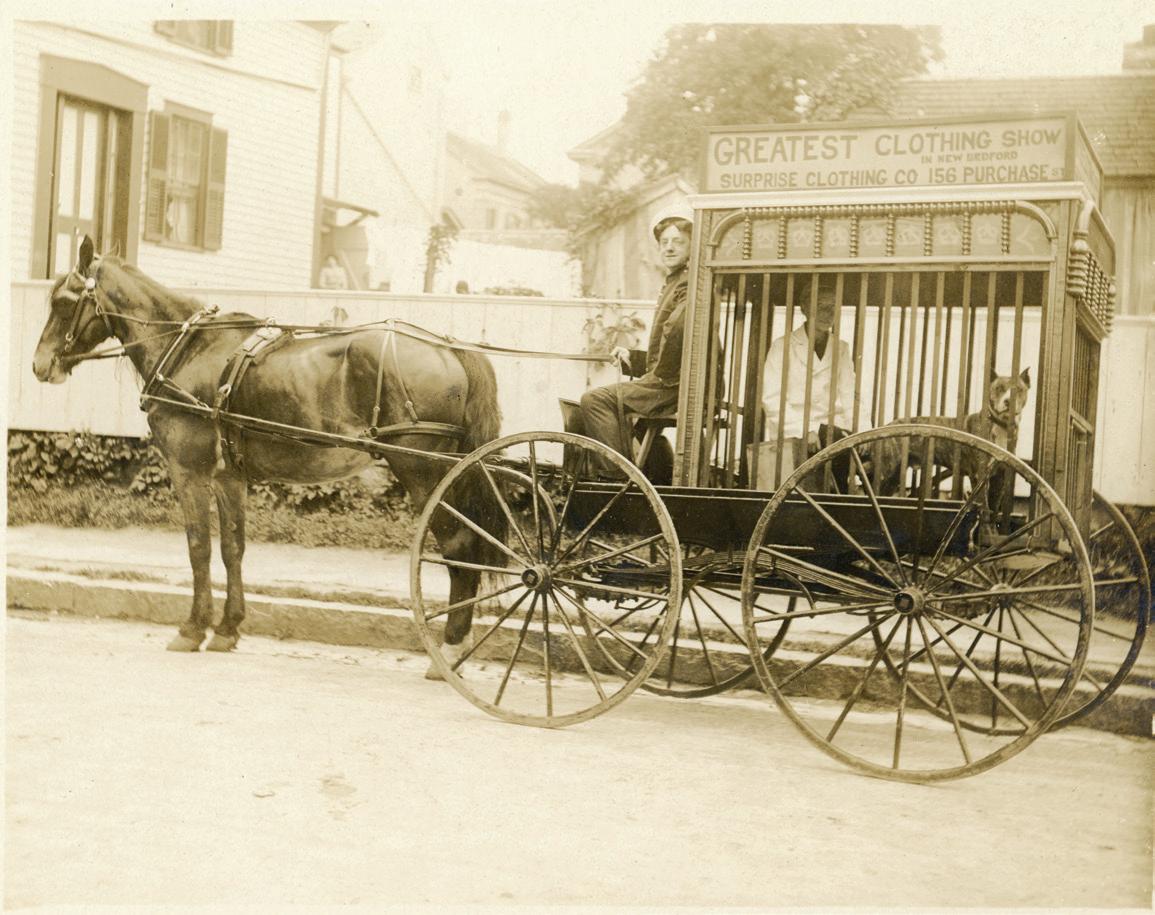
Harry Blumenthal, a.k.a. Harry Bloomingdale (1873-1962), was born in Philadelphia where, as a youth, he worked for his father, a Russian immigrant cloth merchant named Louis Blumenthal (1854-1954). Later, Harry traveled the East Coast working for clothier H & D. Daniel of Springfield, MA and Hartford, CT, as the firm acquired other companies going out of business. The Daniel firm specialized in high-powered marketing with catchy slogans, window displays, and other advertising schemes at the forefront of early twentiethcentury American mass-consumer merchandizing. They were early supporters of organized labor and advertised clothing with the Union Label.
At some point in his career, Harry changed his name to “Bloomingdale,” evidently both a disguise for his Jewish heritage, as well as affording the convenient name recognition of the pioneering New York retail clothing firm of Joseph and Lyman Bloomingdale. Bloomingdale’s of New York started out selling whalebone hoop skirts in 1861, and grew into a major retail department store by the end of the century. Whether that had any influence on Harry’s moving to New Bedford to open a clothier remains an open question. However, he did just that in 1901, opening
a clothier at 156 Purchase St., that by 1905 was named Surprise Clothing Co. The store later moved to a location at 142 Union St.
By all accounts, Bloomingdale was a character with award-winning window displays, parade floats, and other dynamic public marketing techniques, including photography. This photograph appears to fall into the latter category. It shows a horse-drawn wagon with a circus cage containing a young boy and a bull terrier dog. The sign above the cage reads: “GREATEST CLOTHING SHOW/ IN NEW BEDFORD/ SURPRISE CLOTHING CO/156 PURCHASE ST. The driver appears to wear a ringmaster’s suit.
Bloomingdale was clearly referencing the well-known language of the circus with his advertising gimmick. P.T. Barnum coined the phrase, “The Greatest Show on Earth” in 1879 when his circus merged with the Bailey Circus. Similarly, the Ringling Bros. used the promotional phrase “World’s Greatest Shows.” While we may never know what the greatest show was or the surprise Bloomingdale’s clothing company offered, this photograph gestures toward mercantile competition in New Bedford at the turn of the century.
55 | Winter 2023
Harry Bloomingdale, Greatest Clothing Show in New Bedford, circa 1905-1912. NBWM, 1981.33.10
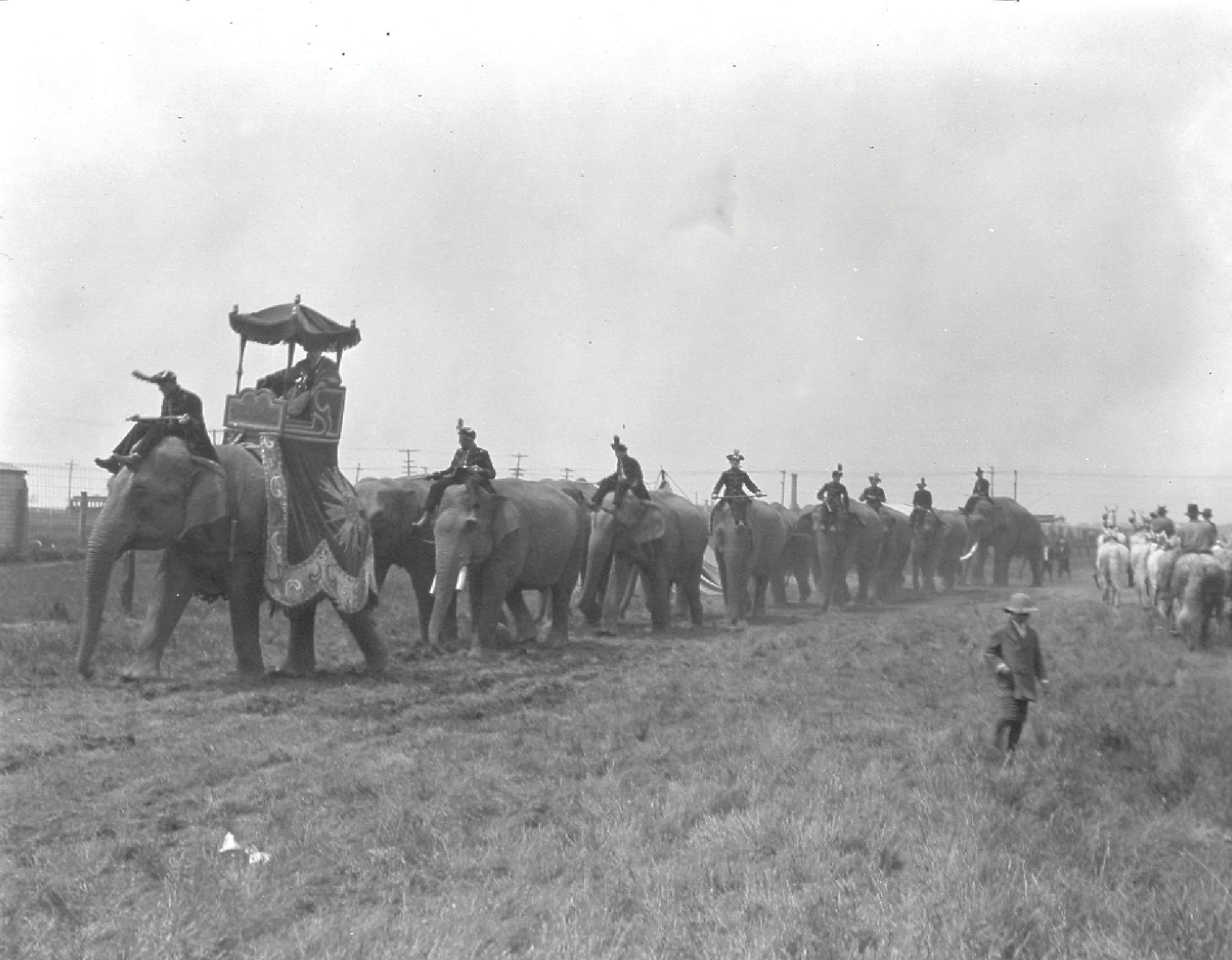
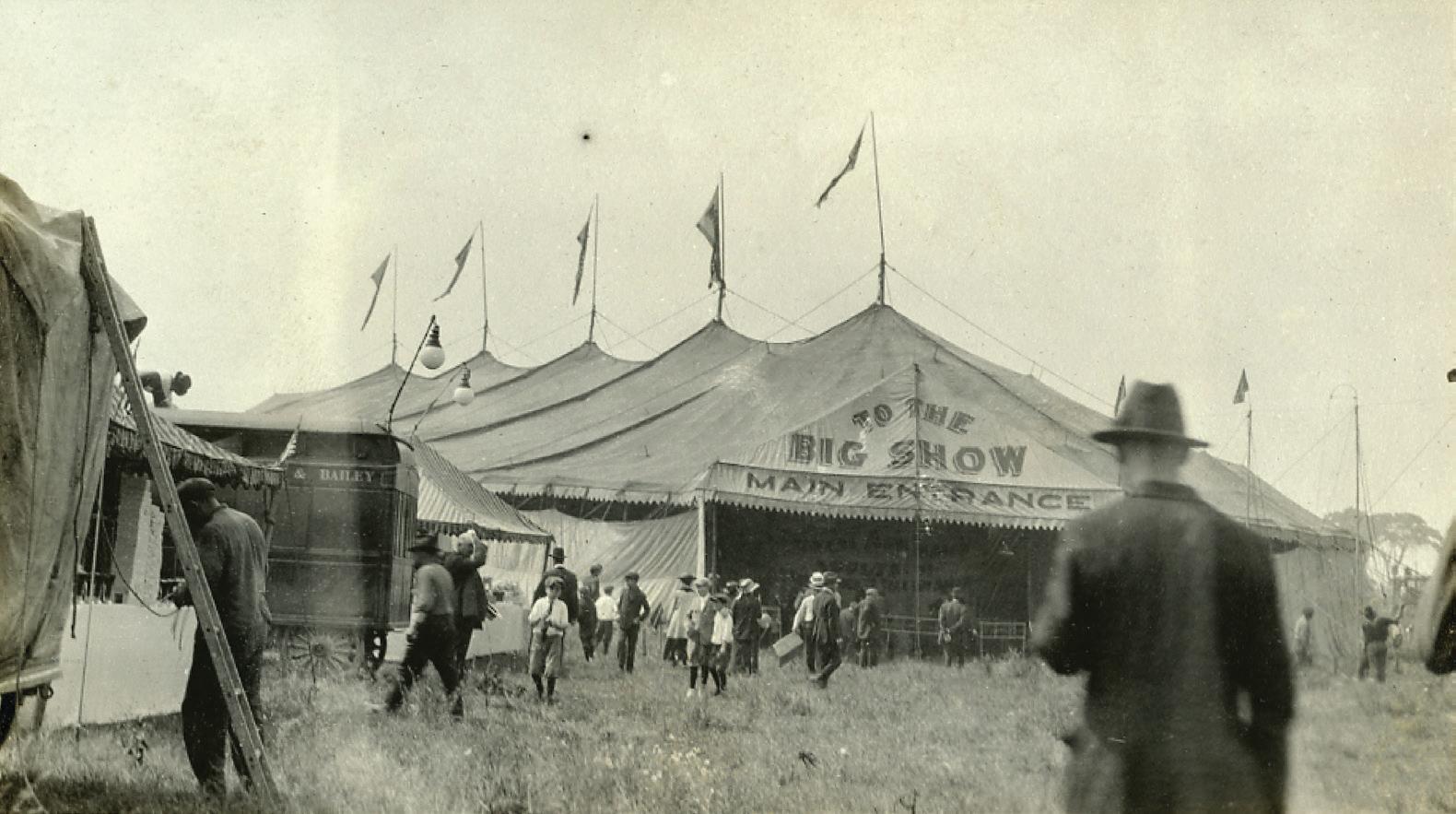
56
Bottom: Dr. Henry Dudley Prescott, Circus Tent, June 21, 1916. NBWM 1981.80.47.3.a.
Top: Albert Cook Church, Circus elephants on parade, 1929. NBWM 2000,100,86.272.
18 Johnny Cake Hill
New Bedford, MA 02740
www.whalingmuseum.org
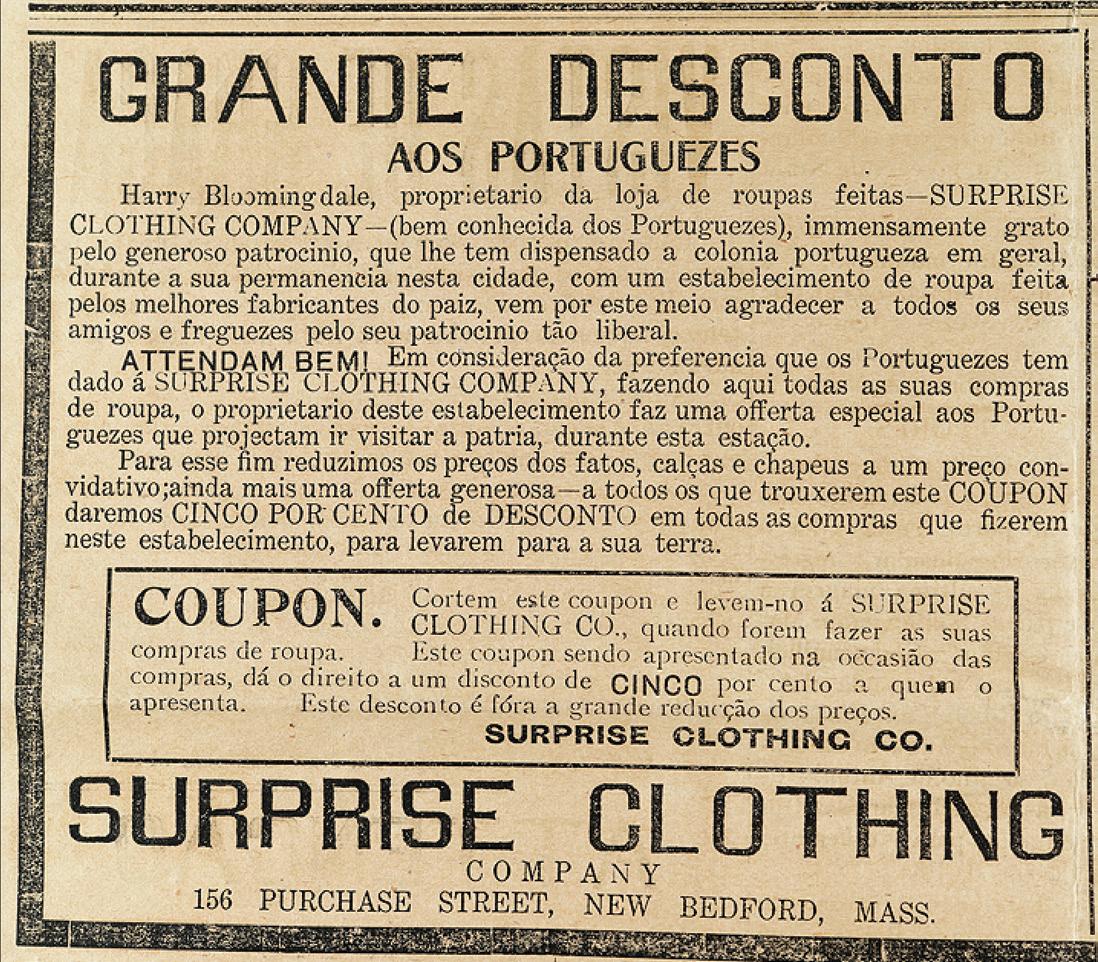
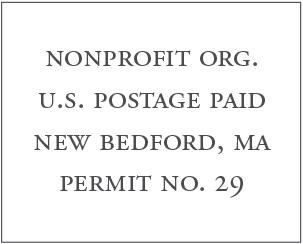 Surprise Clothing Company, 156 Purchase St., New Bedford, MA, Harry Bloomingdale, proprietor. Advertisement from the New Bedford Portuguese-language newspaper Progresso, vol 12, no. 48 (January 6, 1906), Francis C. B. Silva, editor, offering discounts to Portuguese clients. NBWM, 2023.58. Gift of Rita Pacheco.
Surprise Clothing Company, 156 Purchase St., New Bedford, MA, Harry Bloomingdale, proprietor. Advertisement from the New Bedford Portuguese-language newspaper Progresso, vol 12, no. 48 (January 6, 1906), Francis C. B. Silva, editor, offering discounts to Portuguese clients. NBWM, 2023.58. Gift of Rita Pacheco.




 Figure 1. Central court of the Mercer Museum with whaleboat, photograph by author, March 2023.
Figure 1. Central court of the Mercer Museum with whaleboat, photograph by author, March 2023.









 Figure 6. Cora-Allan Lafaiki Twiss making hiapo in Samoa with Fa’apito, 2019. Courtesy of Cora-Allan Lafaiki Twiss.
Figure 6. Cora-Allan Lafaiki Twiss making hiapo in Samoa with Fa’apito, 2019. Courtesy of Cora-Allan Lafaiki Twiss.









































 Surprise Clothing Company, 156 Purchase St., New Bedford, MA, Harry Bloomingdale, proprietor. Advertisement from the New Bedford Portuguese-language newspaper Progresso, vol 12, no. 48 (January 6, 1906), Francis C. B. Silva, editor, offering discounts to Portuguese clients. NBWM, 2023.58. Gift of Rita Pacheco.
Surprise Clothing Company, 156 Purchase St., New Bedford, MA, Harry Bloomingdale, proprietor. Advertisement from the New Bedford Portuguese-language newspaper Progresso, vol 12, no. 48 (January 6, 1906), Francis C. B. Silva, editor, offering discounts to Portuguese clients. NBWM, 2023.58. Gift of Rita Pacheco.